We kindly recommend you to familiarize yourselves with the previous articles of the series In quest of… A journey to the remote 11th century:
A journey to the remote 11th century series has proved to be much more difficult than I expected, though such difficulty even peps me up. During the last two months I felt ten times sorry for having started the theme. Max Vorontsov and Yura Ignatov who are searching for relevant information on the web also note a similar unclear pressure from outside. A part of my consciousness throws in numerous provocative questions and doubts about the reasonability of continuing the series, but at the same time the other part unexpectedly finds counterarguments, saying without such an analytical material dedicated to the initial preamble the whole website project may come down to a mere collection of authors’ lyrical opinions and lose its ultimate purpose. Therefore, we shall anyway endeavour to continue, though with a slight adjustment in our movement: we will minimize assumptions from our minds and refer only to universally recognized facts and discovered photographs. In particular, in this article we will have very, very many images, since the Pacific Ocean is truly immense.
Before starting the story I would like to make a reservation that the idea of the previous article Sican and Inca civilizations was not mine, and it was not dreamt up. My assumption that Someone highly spiritual, bringing the Knowledge, light and wisdom, after visiting Toltec tribes (ancient Mexico) in Central America did not go back across the Atlantic Ocean, but descended to the South American continent, is based on indications accidentally found in the book Kon-Tiki: Across the Pacific by Raft by the famous Norwegian archaeologist Thor Heyerdahl (I will cite extracts from the book a bit later). I do admit there could have been no round-the-world journey at all, and it might be a mere fruit of my fertile imagination. However, in such case let me anticipate things and ask: why did a similar “spiritual boom” take place in Indonesia, Pagan, Khmer, and India (i.e. on the opposite side of the Pacific Ocean) starting from the same 11th century? Hence, we can theoretically assume that 10 centuries ago Someone, most probably accompanied by a team of companions, crossed the Pacific Ocean from the east to the west. Why not? In 1947, it took Thor Heyerdahl and a team of his friends 101 days to cover the distance of 4300 nautical miles (8000 km!!!) on a little raft named in honour of the ancient deity Kon-Tiki (https://en.wikipedia.org/wiki/Thor_Heyerdahl). Later on he wrote a book about the voyage, and recently a relevant motion picture about his journey was released.
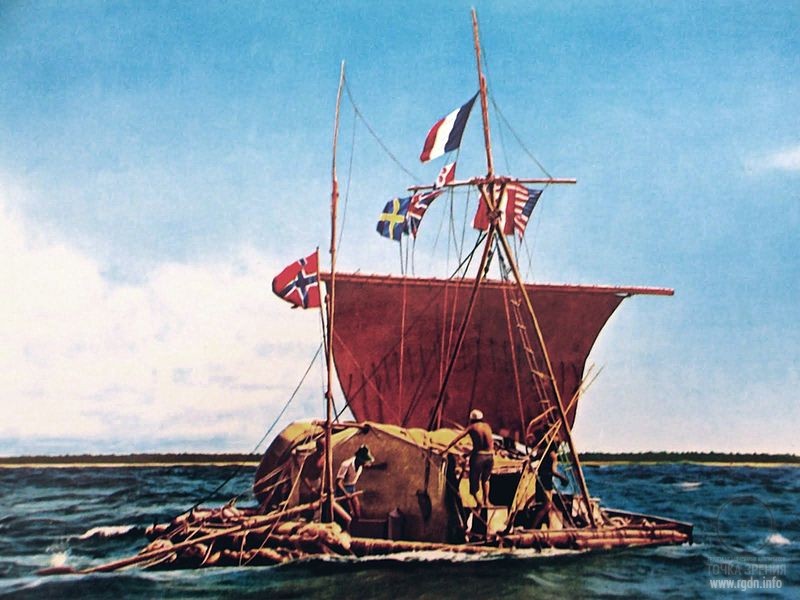
So, let’s proceed to the quotes that awoke my interest in Thor Heyerdahl’s Kon-Tiki: Across the Pacific by Raft:
About Easter Island:
 “To all appearances, a drastic stratigraphic shift in architecture of stone sanctuaries occurred circa 1100 AD, right when the Inca Empire emerged in Peru. Since the resemblance between the monuments of the Early and Middle Periods and the architecture and sculpture monuments of ancient Peru is obvious, it’s important the emphasize that the beginning of the Middle Period culture on Easter Island coincides with the First Inca’s rise to power…”
“To all appearances, a drastic stratigraphic shift in architecture of stone sanctuaries occurred circa 1100 AD, right when the Inca Empire emerged in Peru. Since the resemblance between the monuments of the Early and Middle Periods and the architecture and sculpture monuments of ancient Peru is obvious, it’s important the emphasize that the beginning of the Middle Period culture on Easter Island coincides with the First Inca’s rise to power…”
I viewed it appropriate to omit certain Heyerdahl’s considerations, which seemed questionable to me. Let’s continue:
“... ahu of the Middle Period. These ahu were not oriented to the sun and simply represented solid stepped platforms for gigantic monuments that towered above the adjacent ground with their backs overlooking the ocean. While the Early Period arts included big-eyed guises of the solar deity and dissimilar statues carved of various kinds of stone, sculptors of the Middle Period made all their statues of Rano Raraku yellowy-grey tuff. Moreover, although about a thousand such monuments were carved, over six hundred of which have been preserved until today, all of them are basically copies of a single prototype. Such prototype was a basalt bust of the Early Period, which the Middle Period newcomers moved to their ceremonial village of Orongo where they worshipped the bust as the only idol of the island up until the arrival of the missionaries. This statue, embodying the sun deity and supreme creator Makemake, outlived all three periods in the Easter Island culture and was associated with religious feasts that included sacrifices of the first fruits and ritual bonfires…
Another significant change that marked transition from the Early Period to the Middle Period was replacement of the solar cult by the birdman cult. On plane surfaces of local rocks, often on top of Makemake guises of the Early Period, they carved human figures with a bird’s head. Such figures were even added to solar symbols of the main deity of the Early Period… Artists of the Middle Period drew big crescent-shaped cane boats on platforms of cult buildings and structures. (Note by the article author: could the crescent-shaped boats symbolize Allat?) These boats with double paddles and the “crying eye” paintings are also non-Polynesian elements, typical rather for pre-Incan cultures of South America. In particular, the ao paddle that occupies a notable place in religious motifs and rituals of the Easter Island, with all its specific features and peculiarities is found in the areas of Moche and Chimú cultures of pre-Incan Peru, which is a conclusive proof of a contact...”
Another confirmation that the famous moai emergence dates back to the 10th century I found on http://www.historie.ru:
The stone statues started appearing circa the 10th century. Probably, they embody Polynesian deities or deified local leaders...
Hence, we again see the reference to the time span of approximately the 11th century.
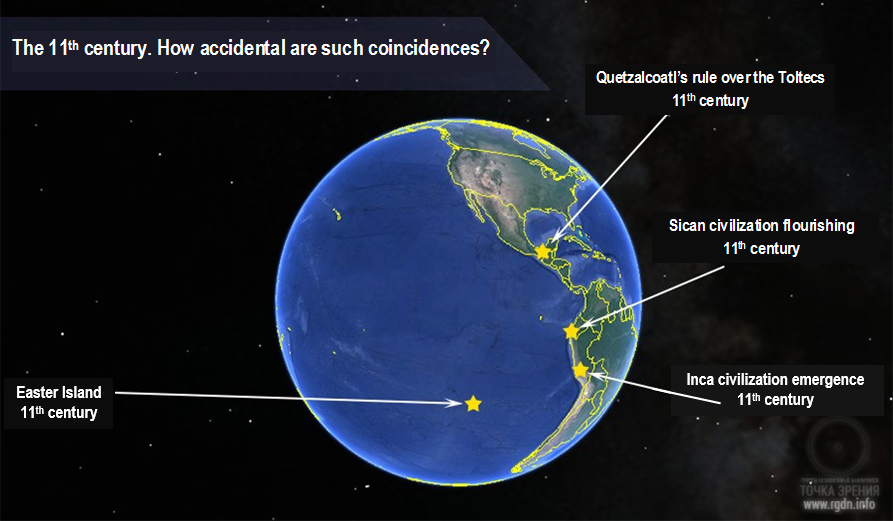
The Birdman cult again! Let’s recall:
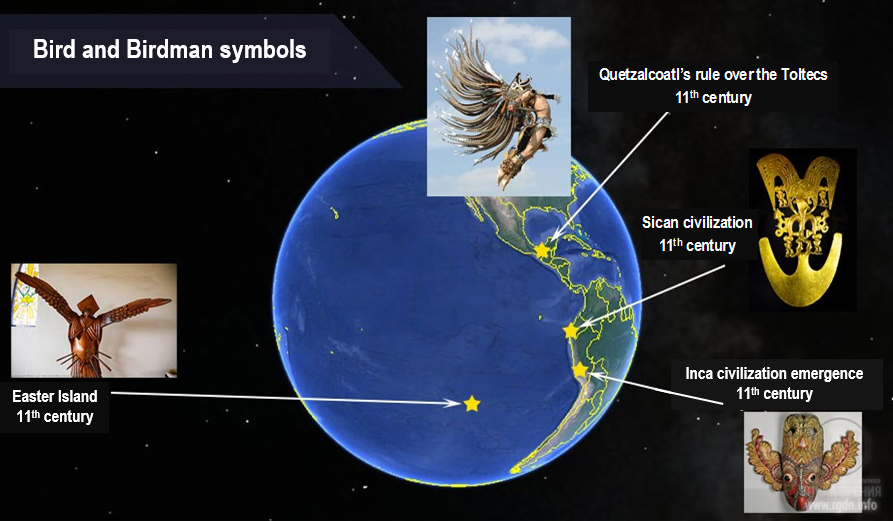
In my opinion, there is logic here, all the more when we start examining photographs of the artefacts discovered on Easter Island and being beyond description so far. Yet, this time I will avoid building any hypotheses associated with the name of the One who could have gone on such a journey (across the ocean), for it is unknown whether the journey took place in fact. Let’s better look at the rich heritage of the extant artefacts that by a miracle were not destroyed by barbarian archaeologists, and let’s recall the knowledge given in the AllatRa book which explains many elements and features of these ancient items.
The image collection is large, but Easter Island really deserves attention:
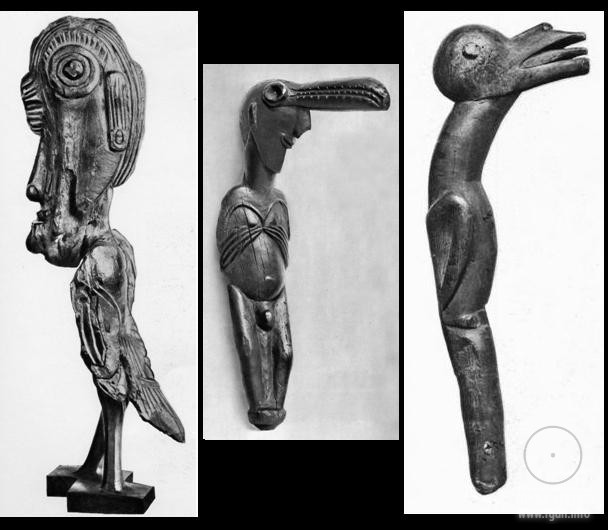
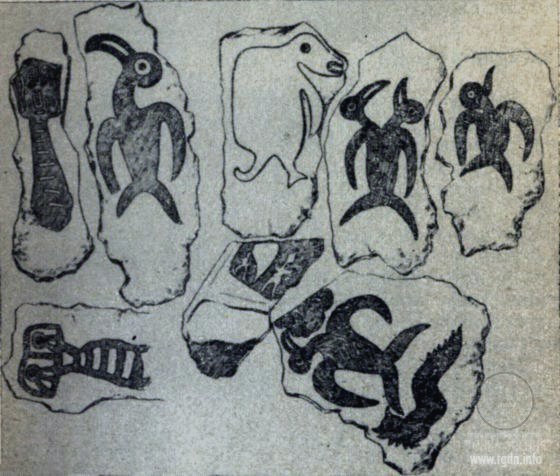
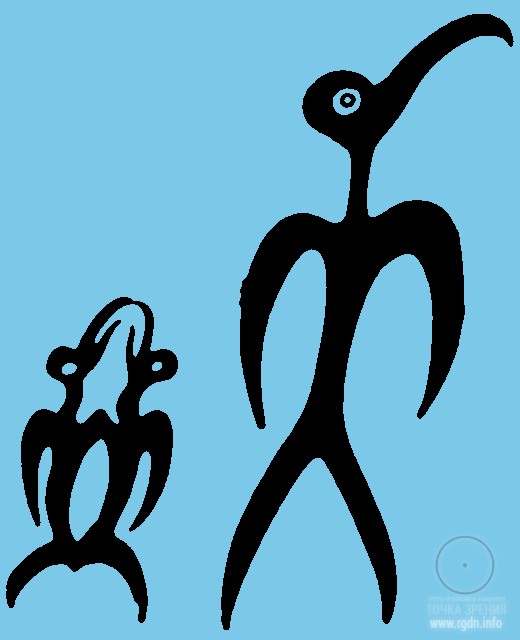
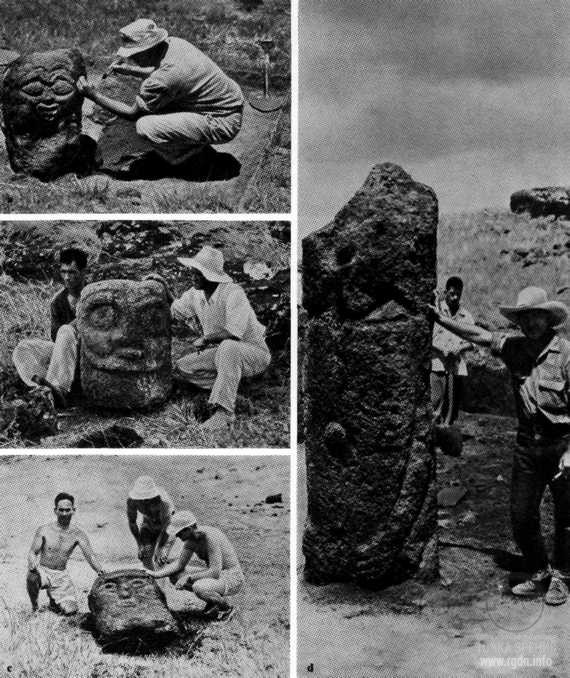
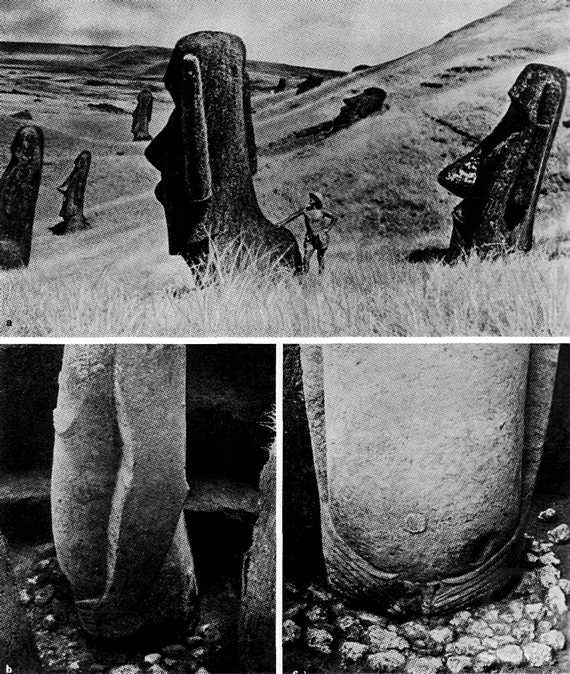
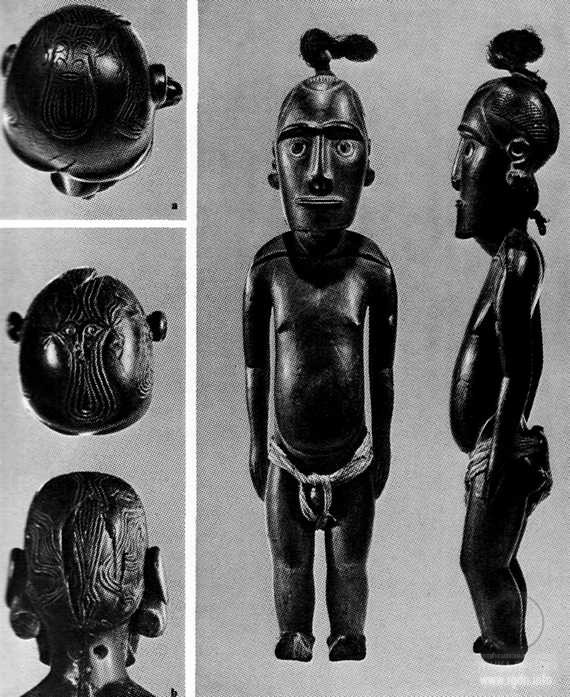
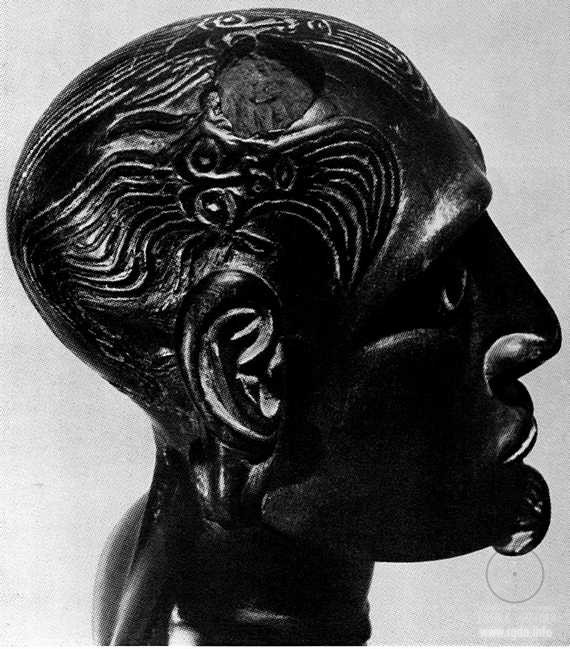
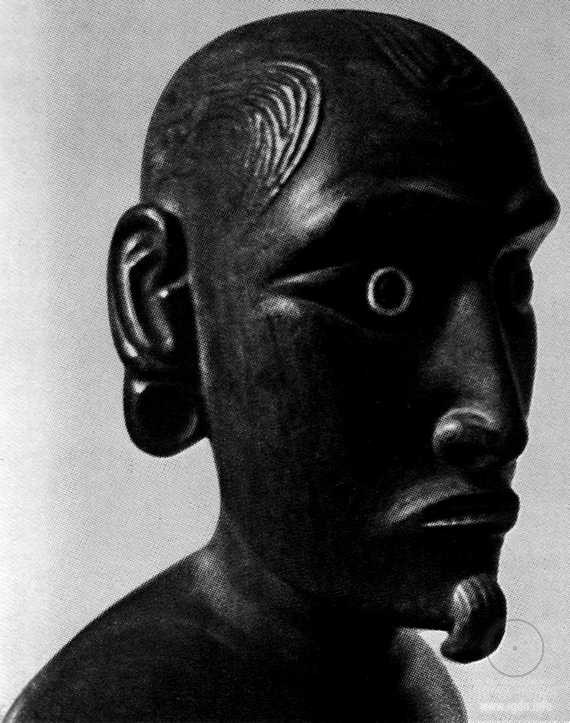
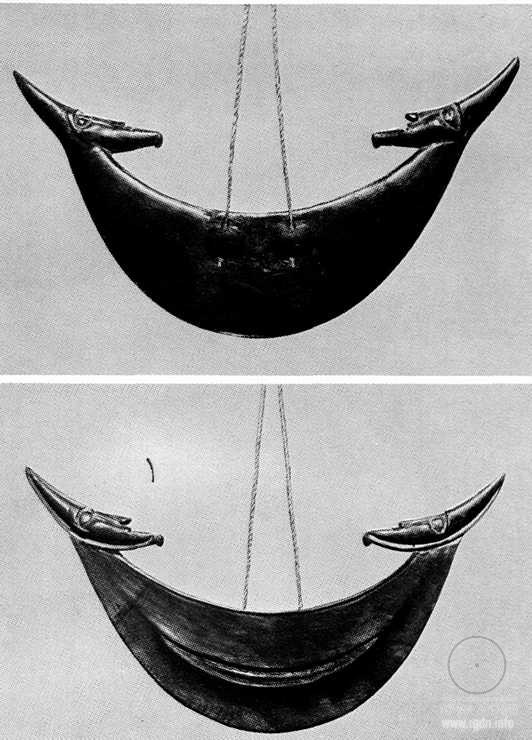
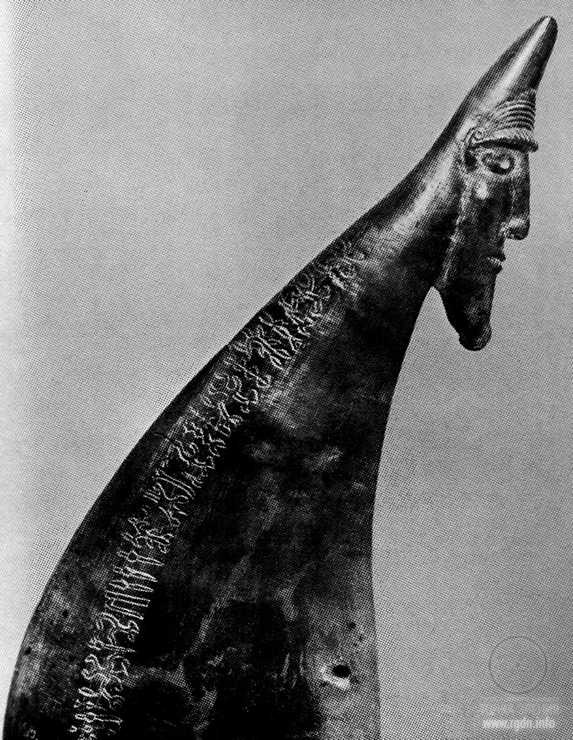
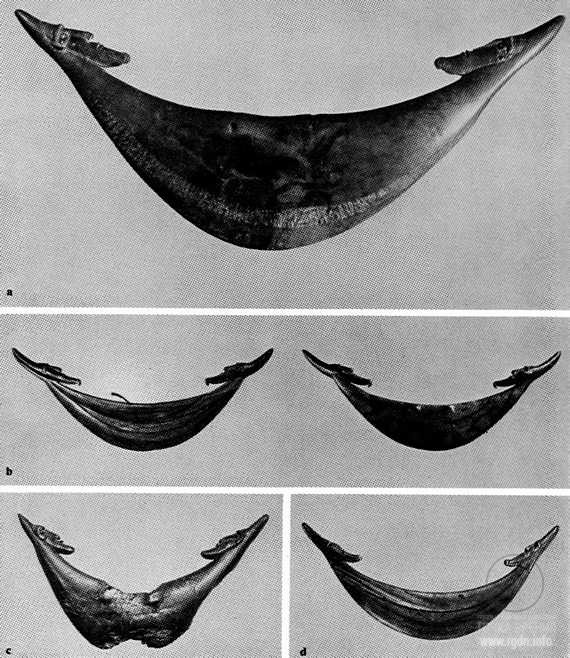
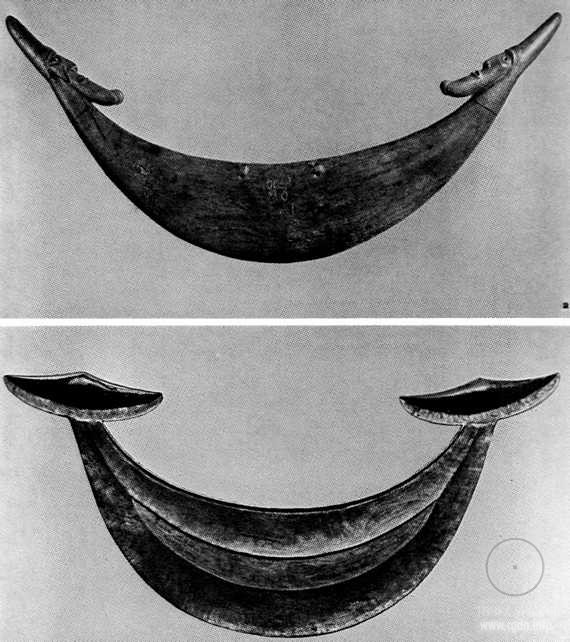
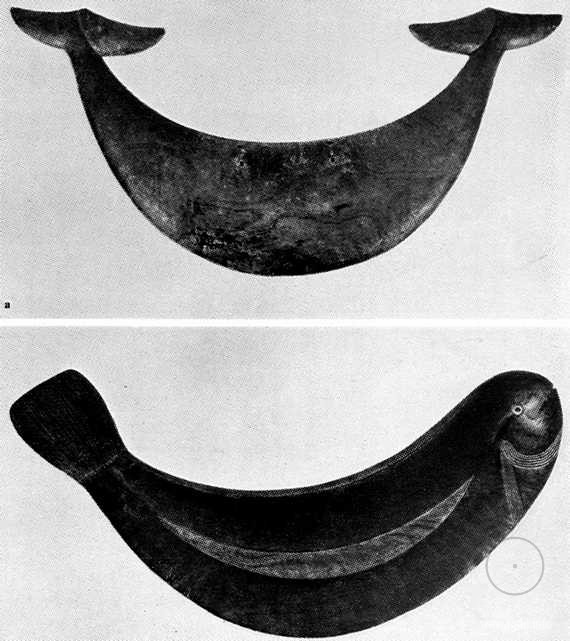
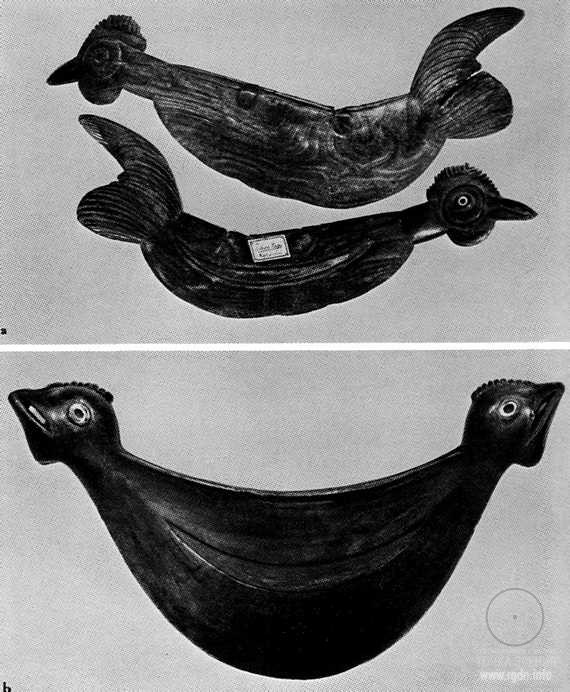
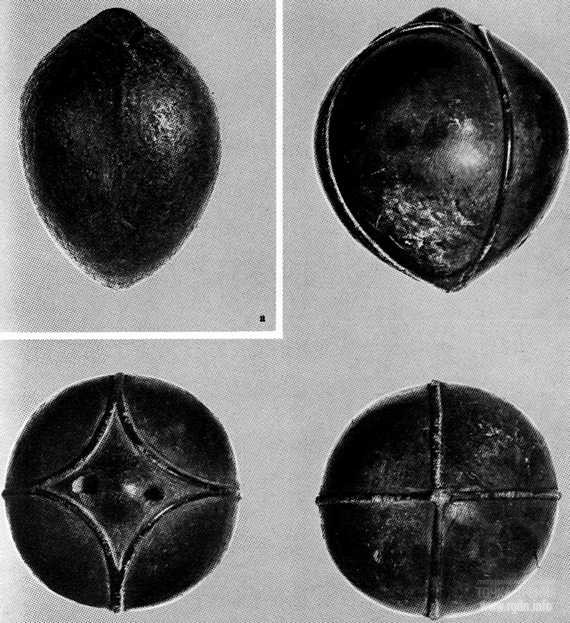
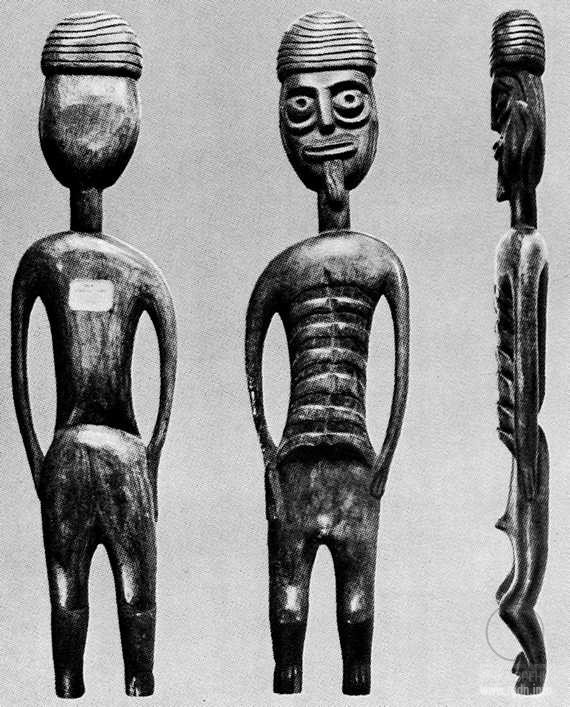
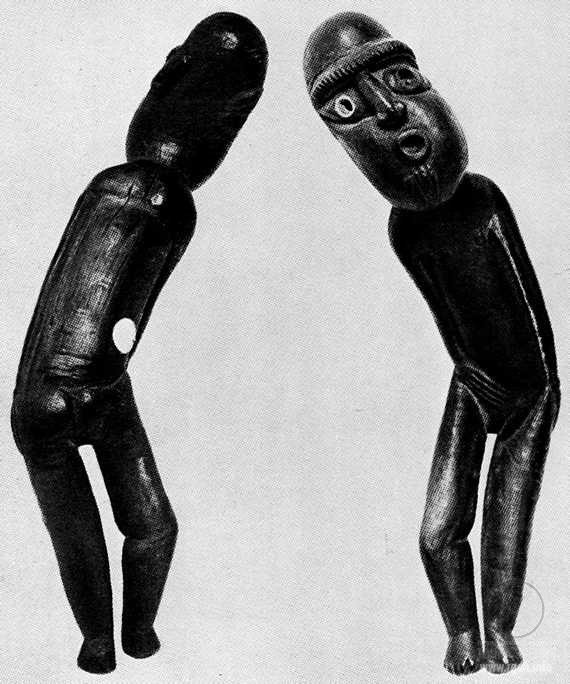
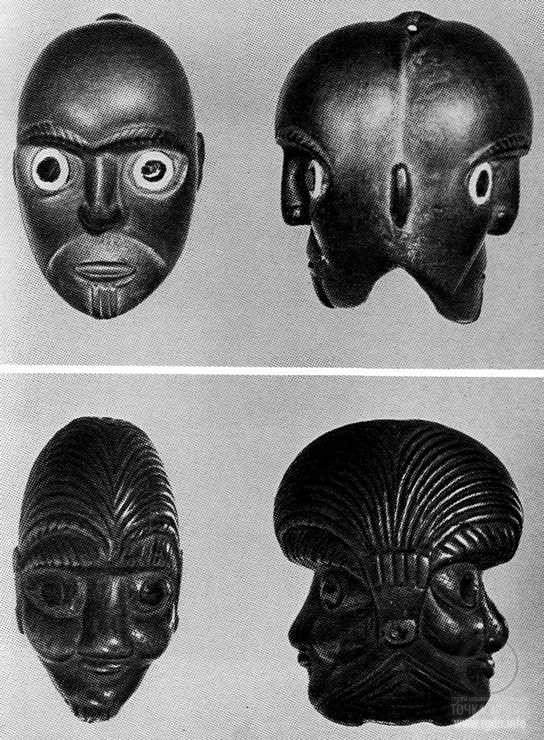
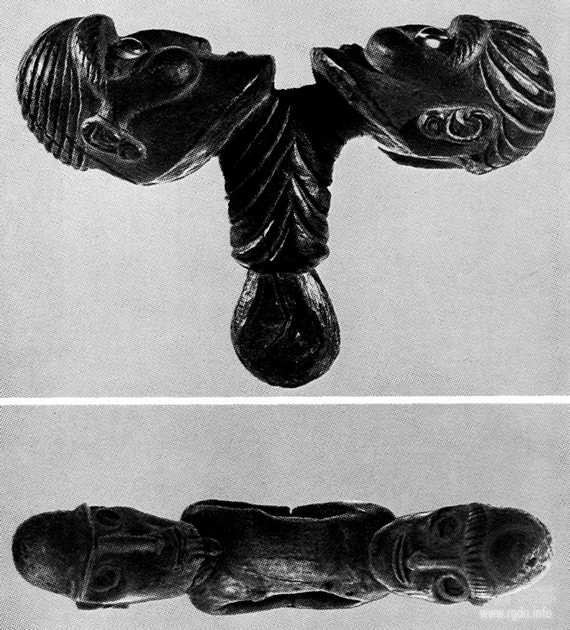
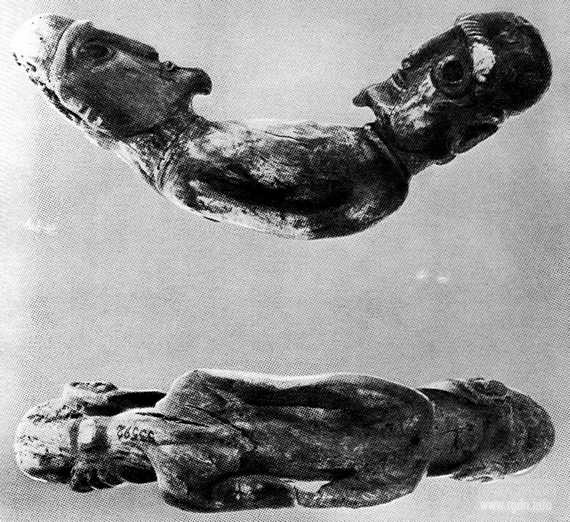
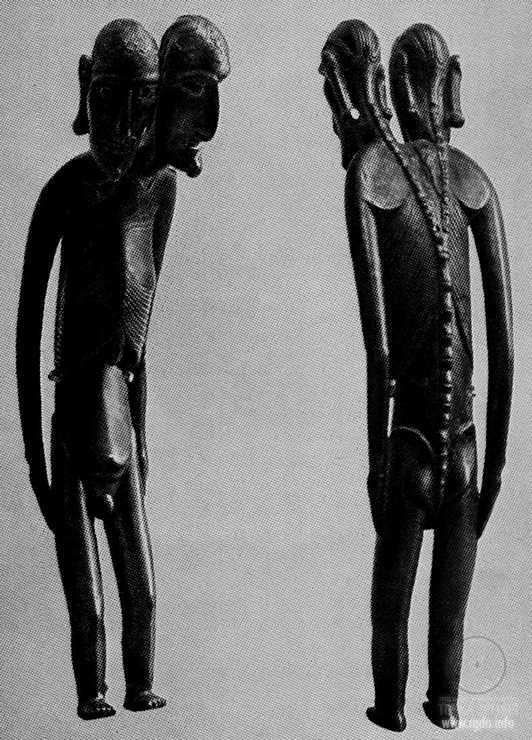
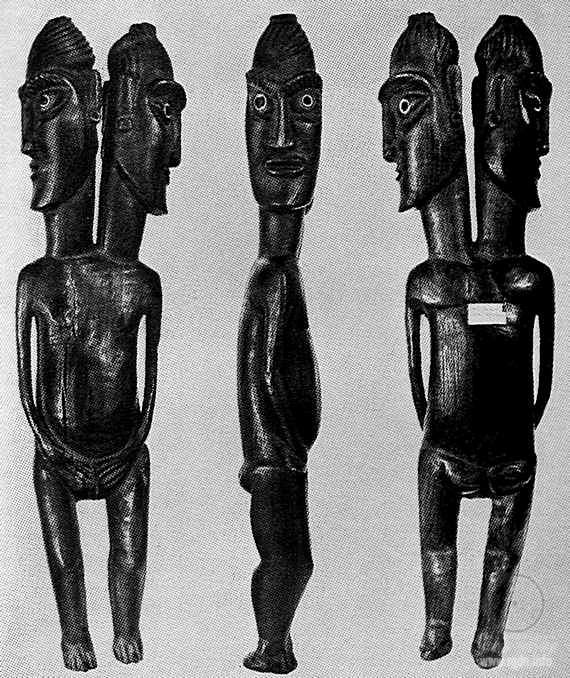
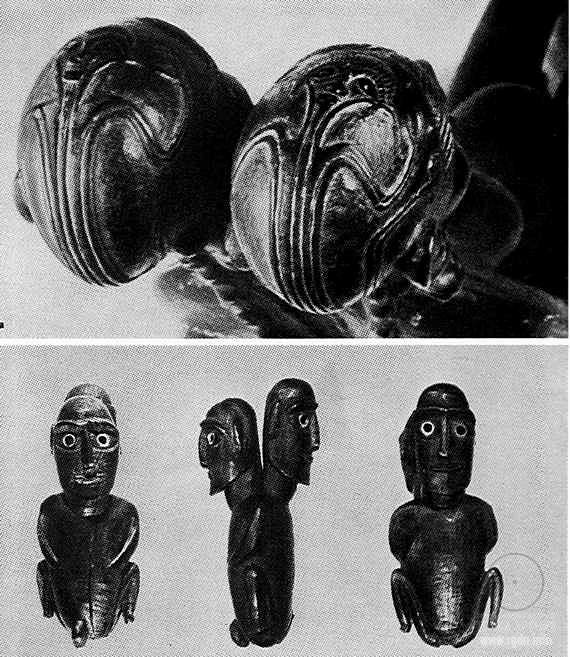
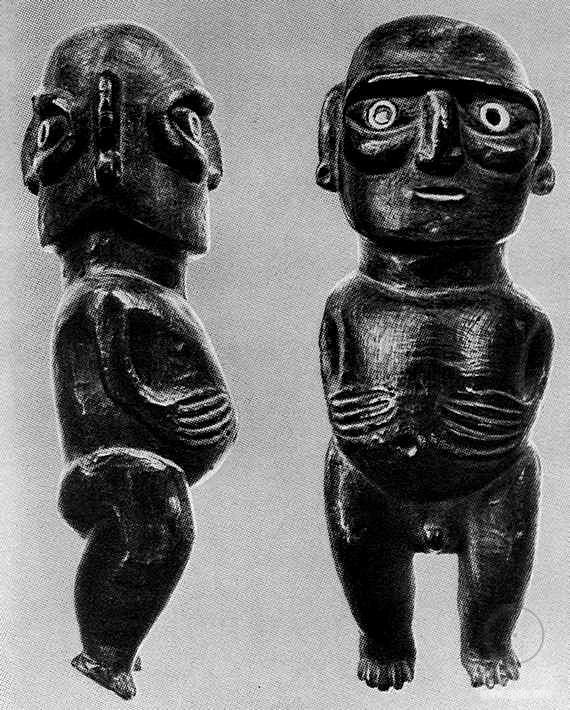
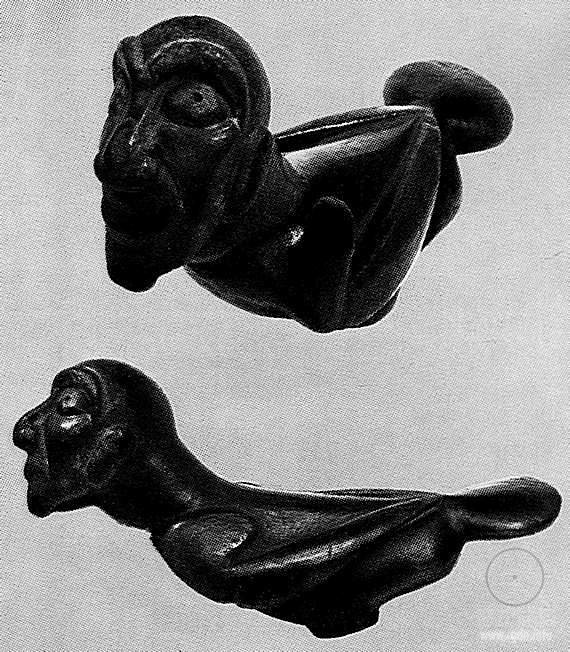
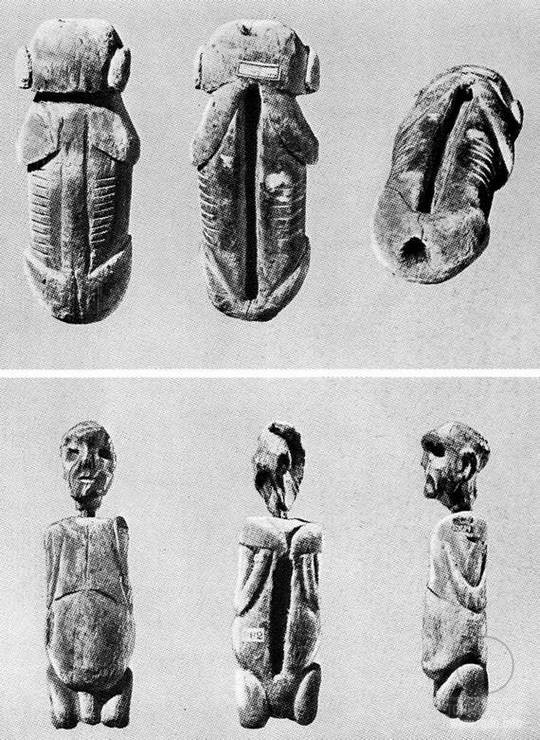
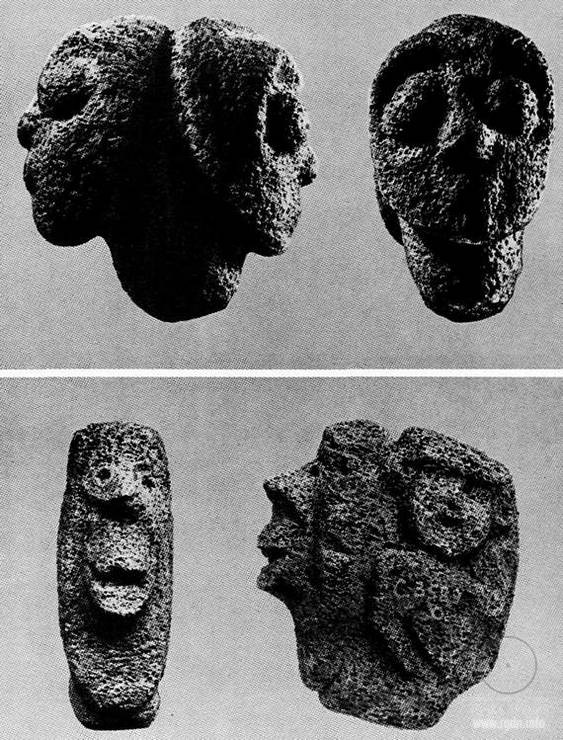
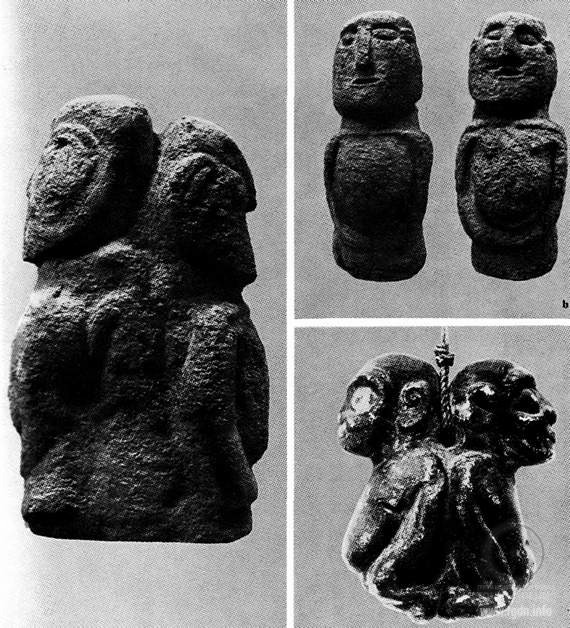
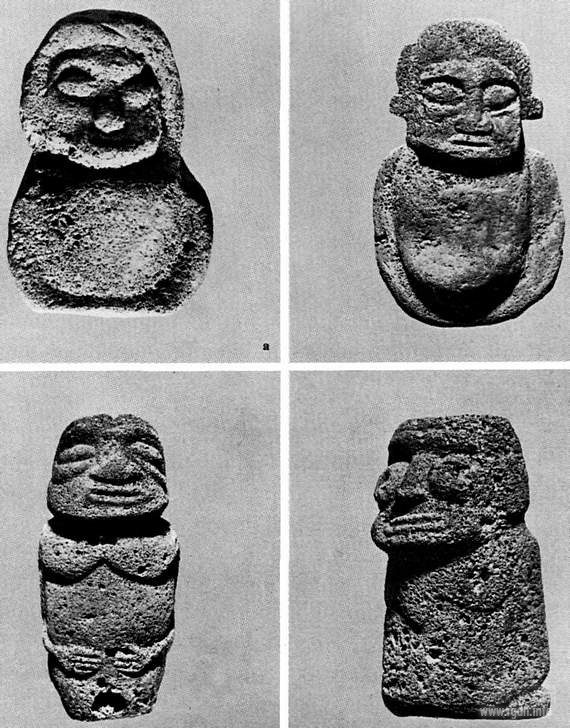
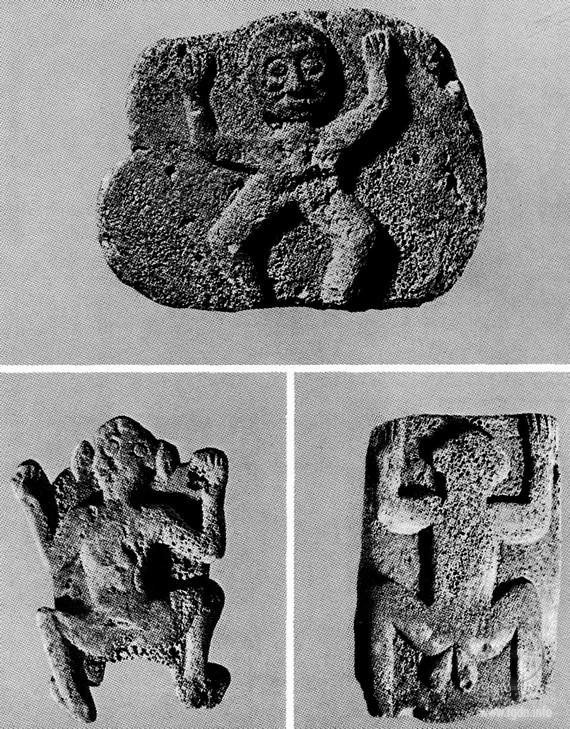
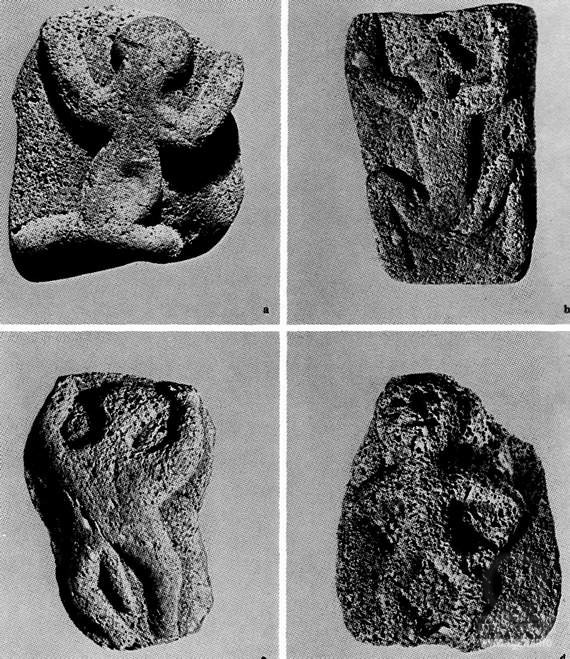
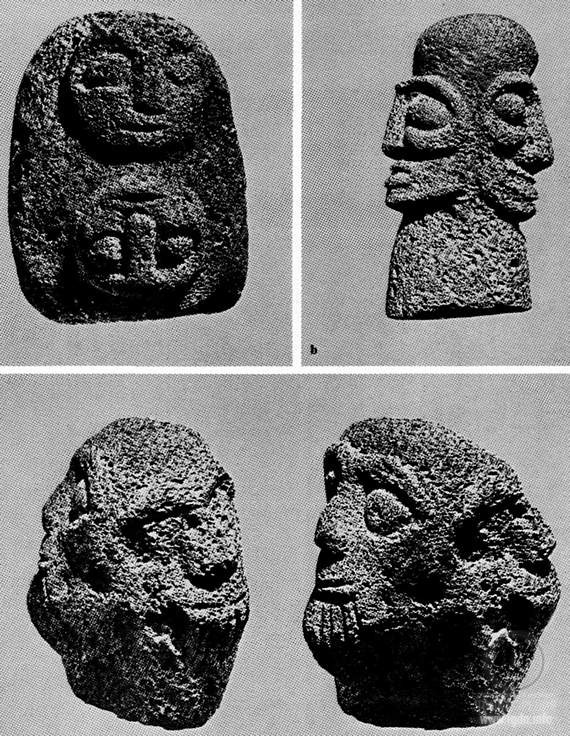
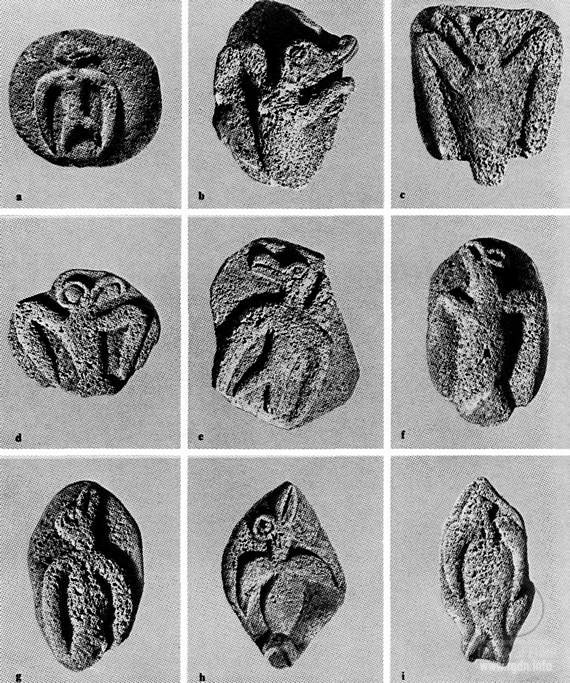
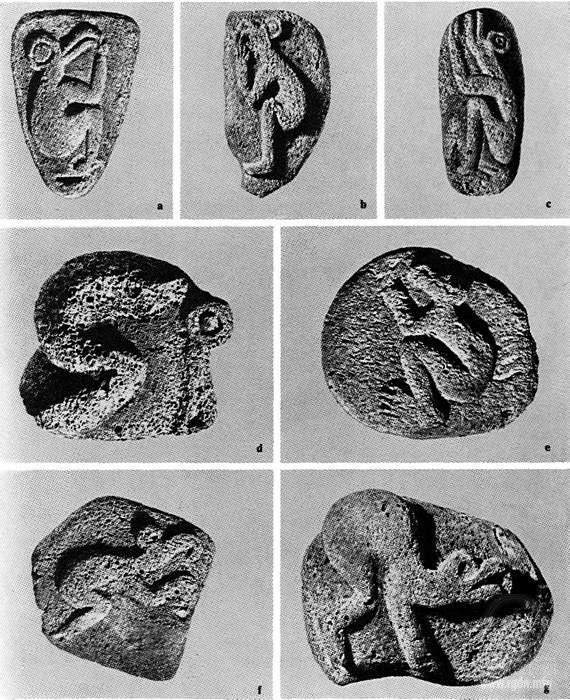
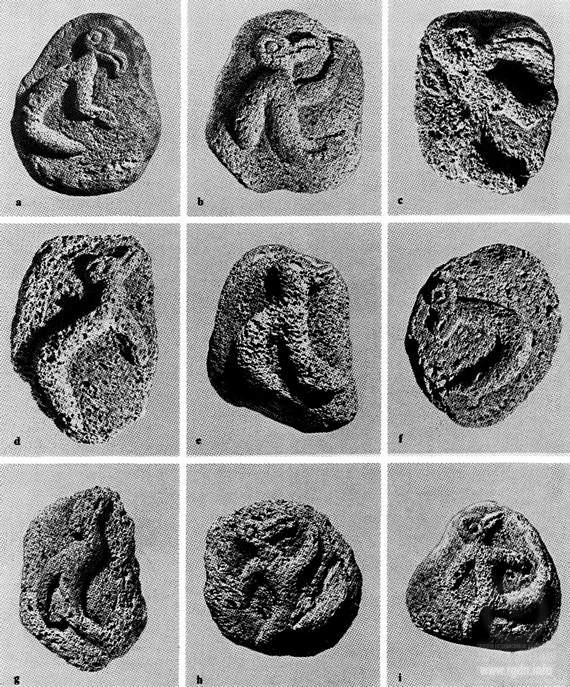
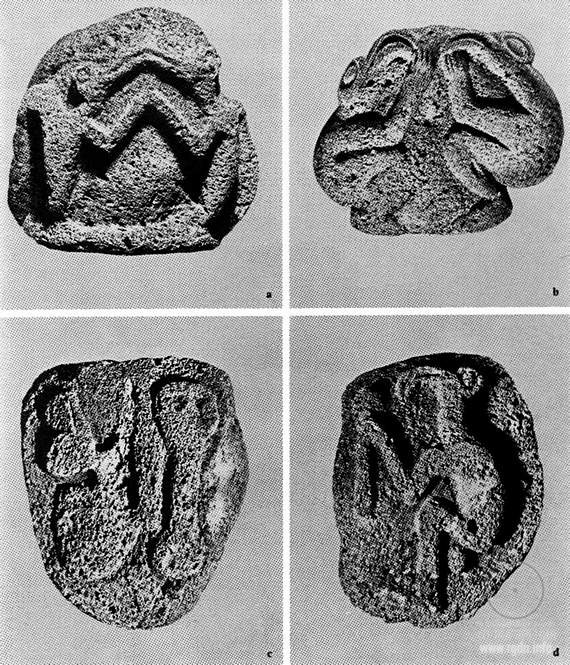
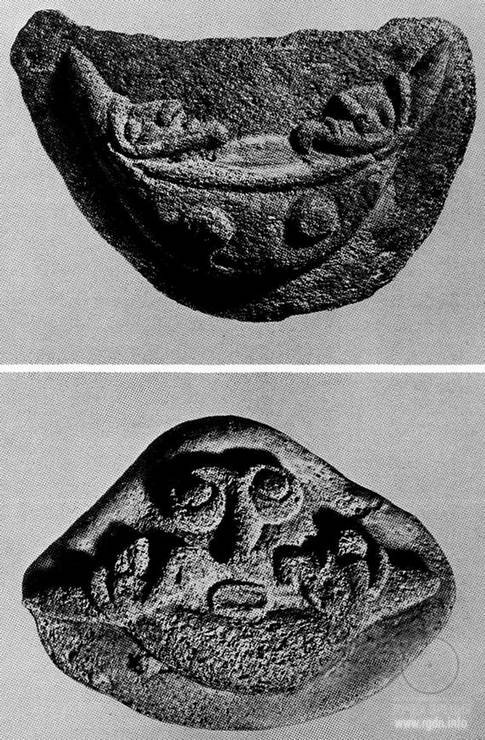
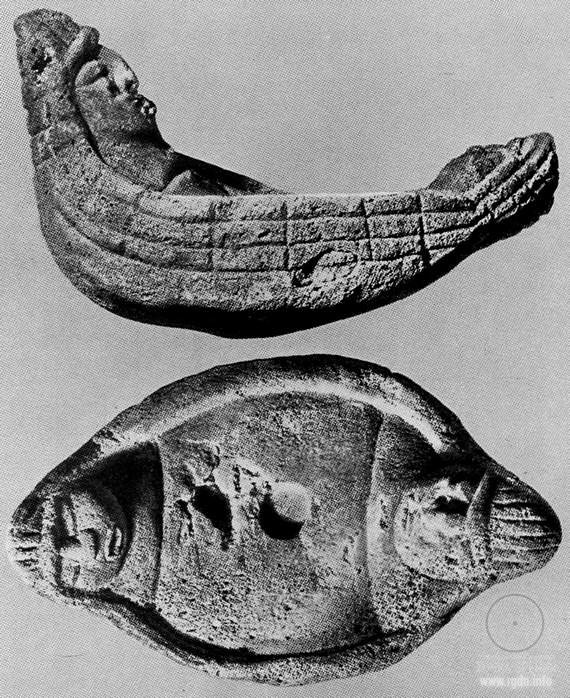
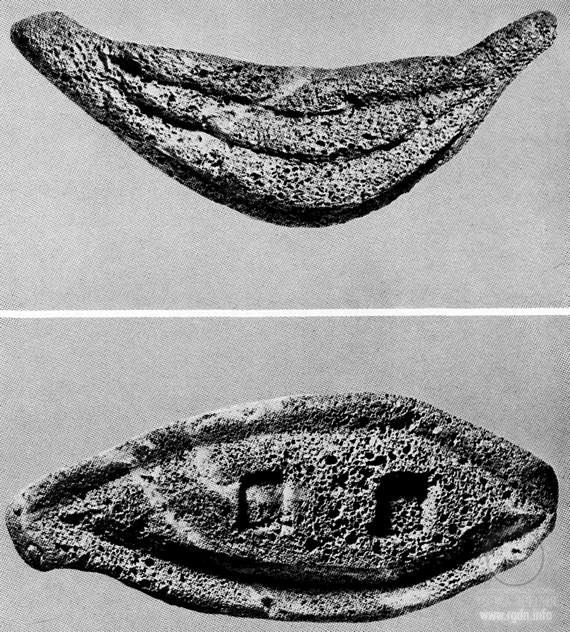
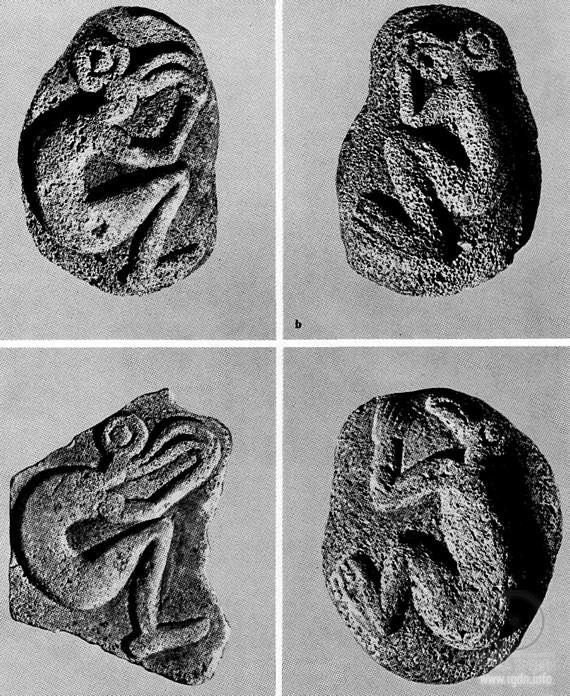
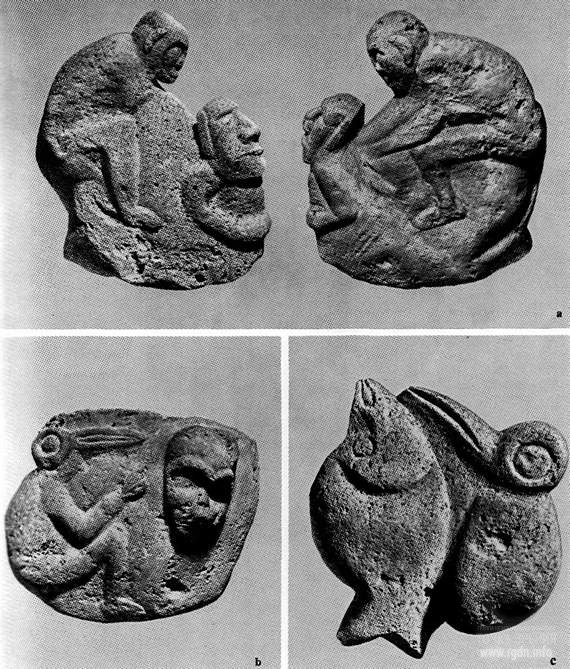
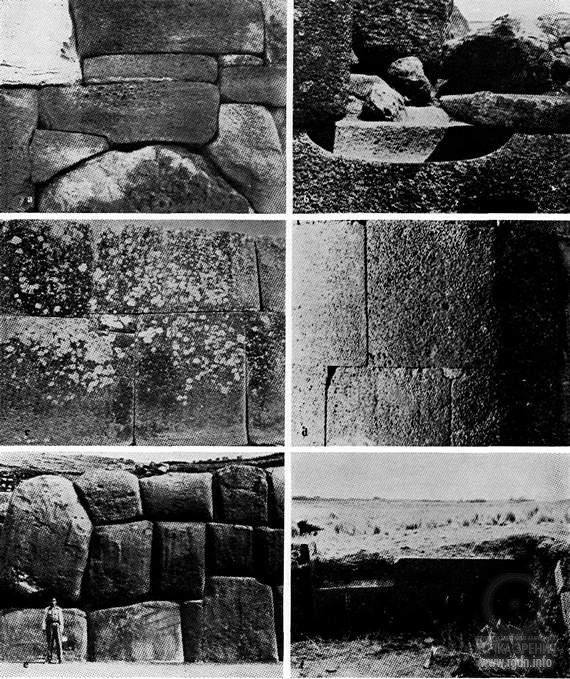
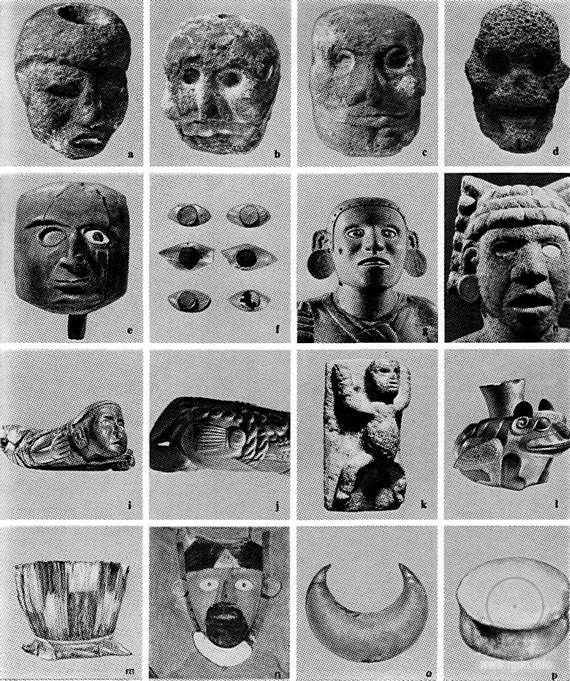
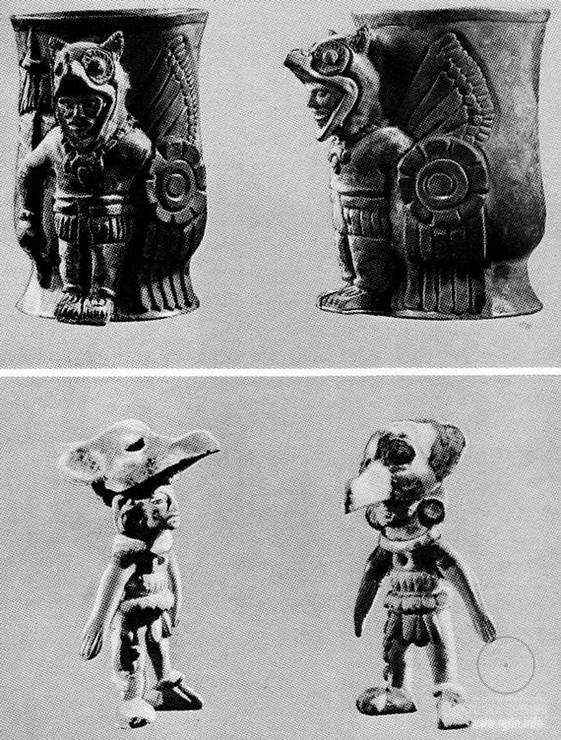
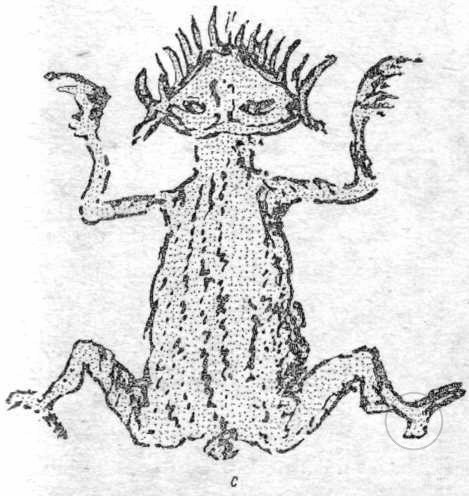
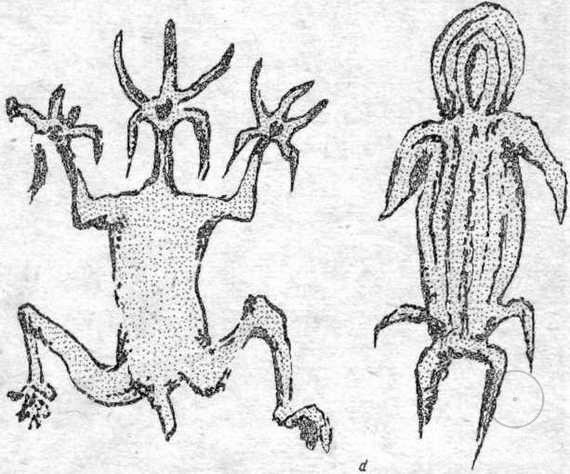
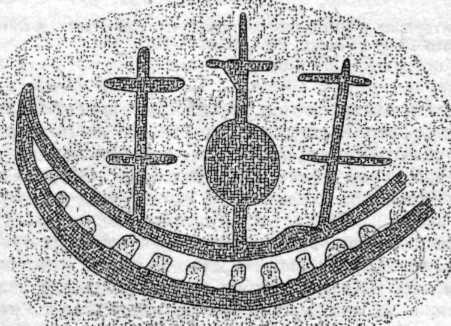
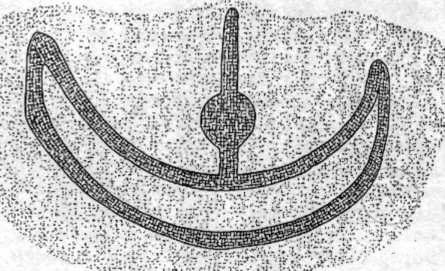
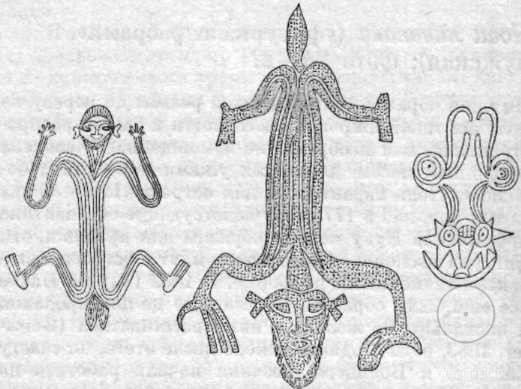
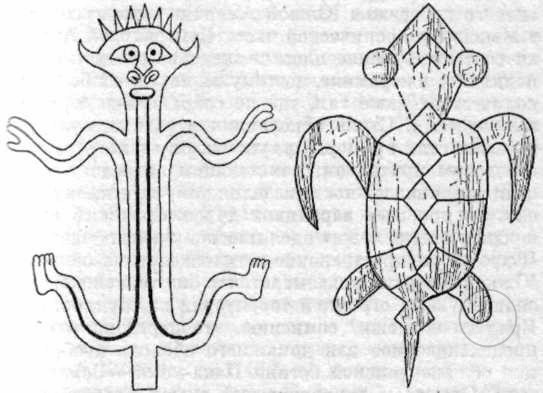
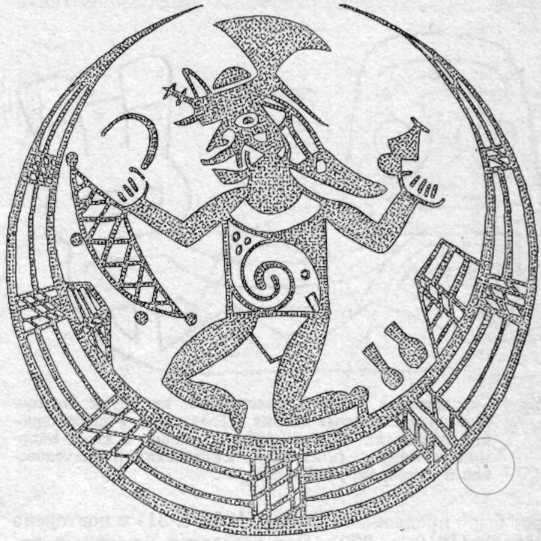
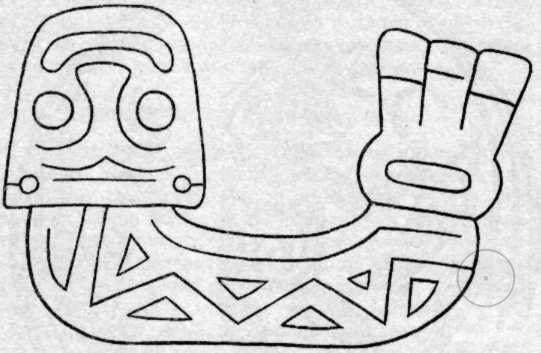
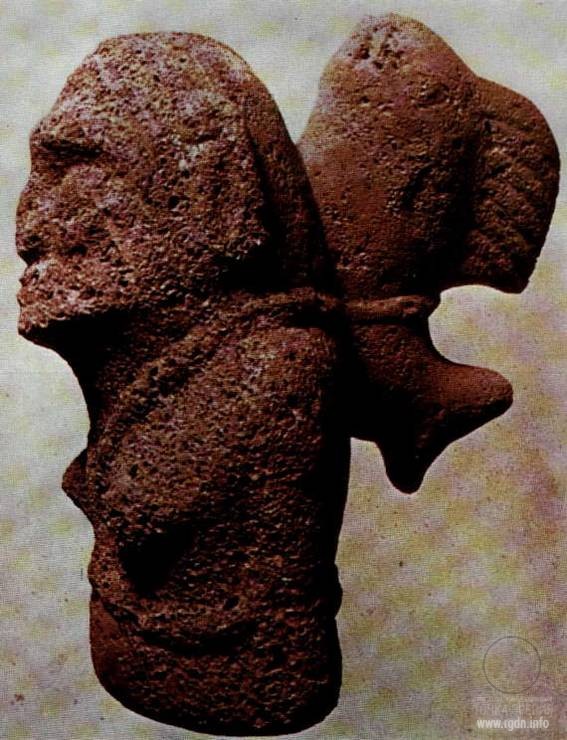
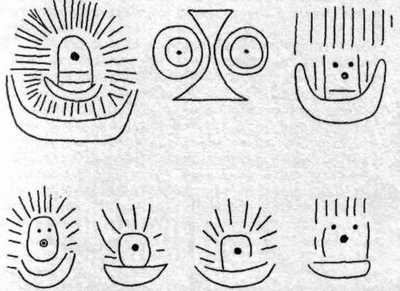
You have noticed many familiar things, haven’t you? The Birdman, the crescent as the symbol of Allat, the indication of human duality, the lateral Aspects, the “divine bug” as a symbol of spiritual enlightenment, even the AllatRa sign, etc. Let me remind that fish, among other things, is a symbol of the Rear Aspect, whereas a bird is a symbol of the Front, so-called spiritual Aspect. Detailed description of each of the four Aspects is given here. So, we cannot say the Primordial Knowledge was not available on Easter Island (hopefully, you agree with such statement of mine). It is still a riddle however who updated the symbols and signs there in the 11-12th centuries.
Another photograph was taken, to all appearances, in a contemporary Christian church on Rapa Nui:
Please, note that the number of “sticks” jutting out of the body and decorated with some signs is seven.
Easter Island may be talked about endlessly, and we can already say a new article with a working title Navels of the World is almost ready for publication, where more information on the island will be available. At that, a question arises: what’s next? If Someone who was bringing knowledge to people reached Rapa Nui, what was his further destiny? He could have hardly stopped there and rest, don’t you think? I started examining Polynesia and found several small pieces of dry land in the boundless ocean space, where researchers had discovered mysterious traces of ancient cultures and civilizations, wisely left in “everlasting” stone.
Should we assume that in the 11-12th centuries AD Someone who was bringing spiritual and practical knowledge, light and wisdom to people indeed visited Rapa Nui (Easter Island) and, according to Thor Heyerdahl, upgraded local architecture and valuables in such a way that nearly 1,000 new stone sanctuaries emerged there, then it is quite interesting what his further route was. For my search I used Google Earth, where in addition to marvellous satellite cartography there is also a unique image collection. Thus, sitting in my apartment, I went on a virtual journey, examining every little island I found, first from a bird's-eye view and then through the eyes of travelling photographers who had once taken pictures by means of this service: http://www.panoramio.com.
Several days later I managed to mark on the map more than a dozen of islands where there are almost identical vestiges of ancient cultures. Certainly, the island list is far from being complete, since my task was only to show that the so-called marae (malaʻe in Tongan, malae in Samoan, and mālaʻe in Hawaiian) still remain on the Pacific Islands. These are sacred places of the pre-Christian Polynesian communities, which were used for both religious and social purposes.
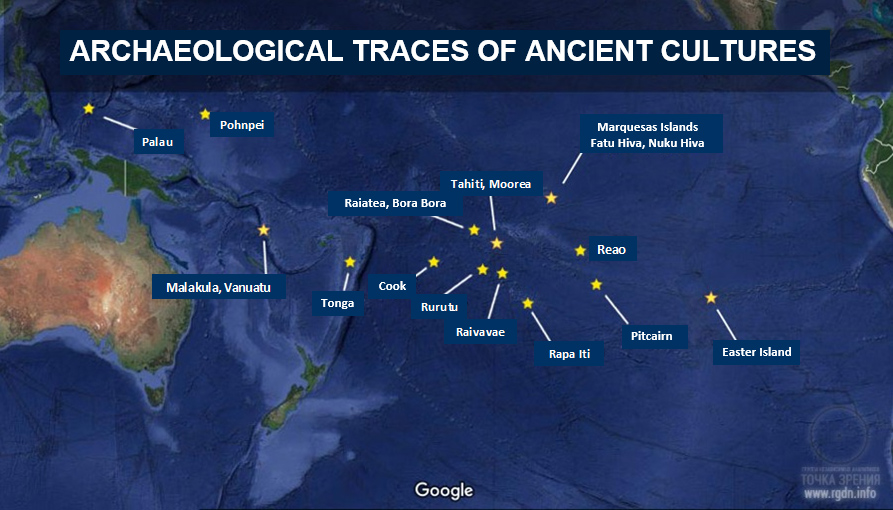
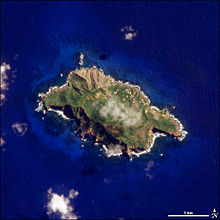
Moving from Easter Island (Rapa Nui) to the west (where else actually?), I ran into a tiny Pitcairn Island that unexpectedly puzzled me with its petroglyphs at the foot of the high rocky shore. I discerned the petroglyphs from afar and started searching for a photographer who would have taken pictures closely there. It took me about an hour to familiarize myself with www.panoramio.com and find close-up images. Unfortunately, there is no information about who took these pictures and when.
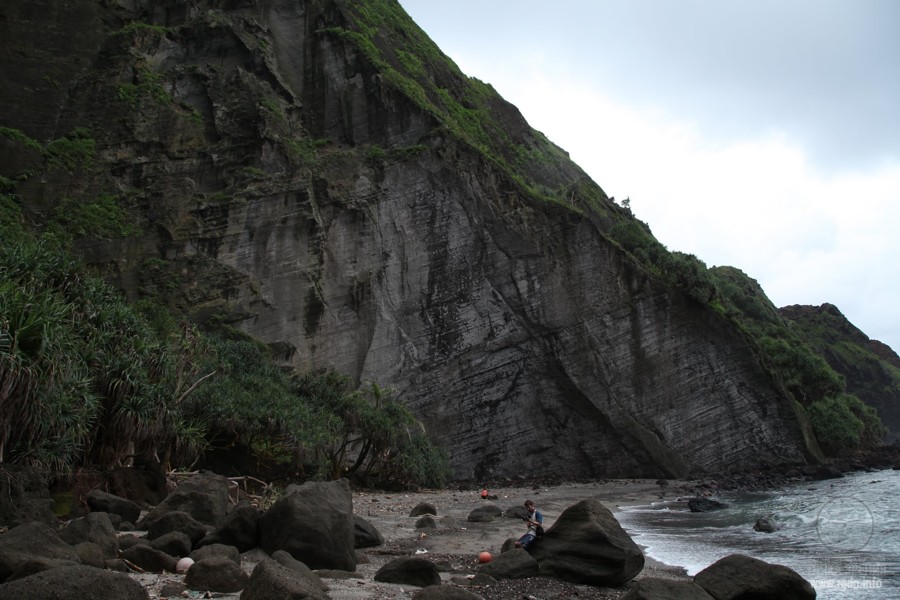
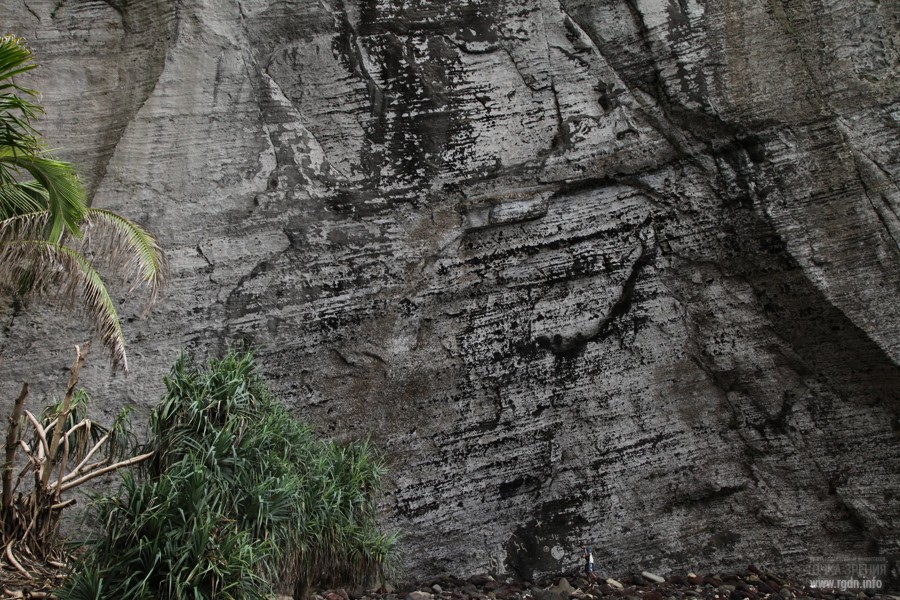
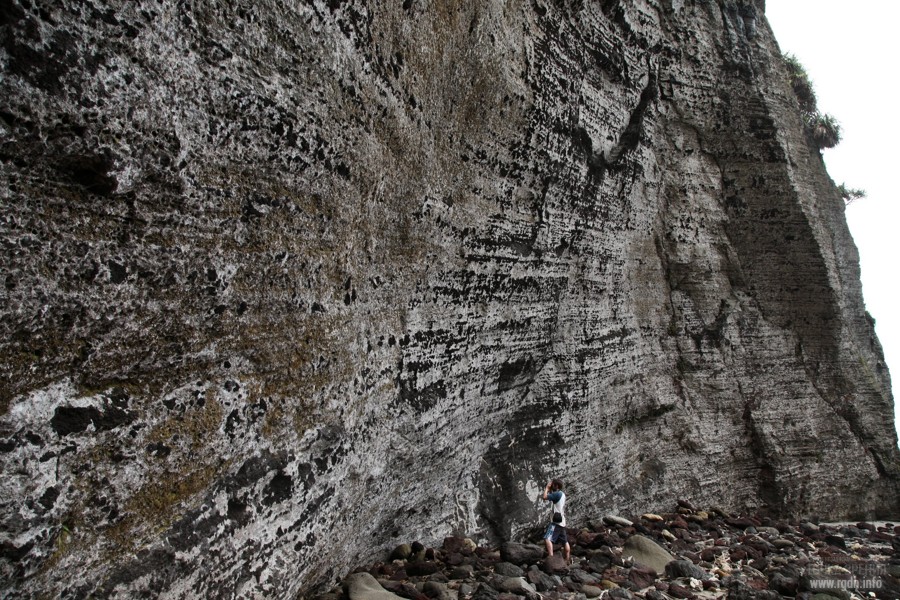
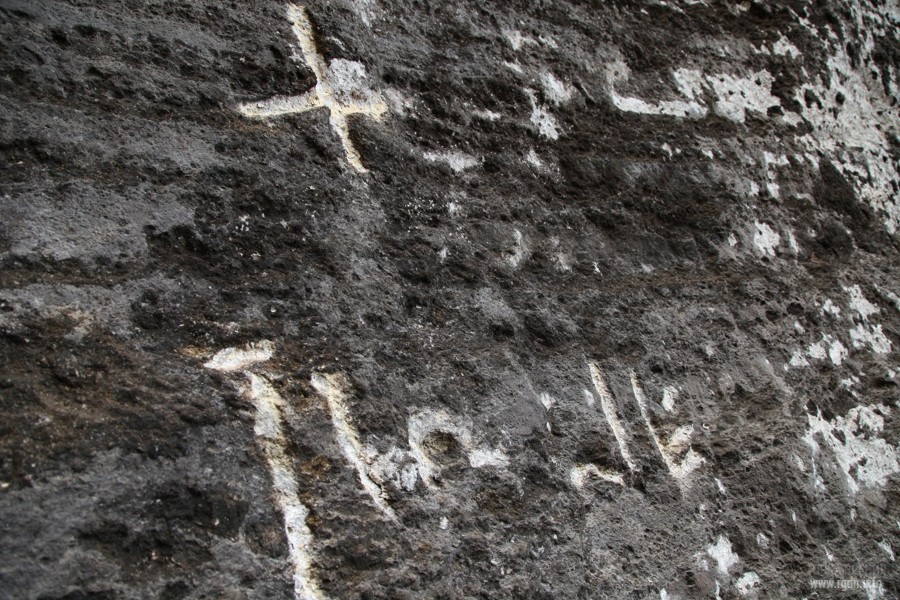
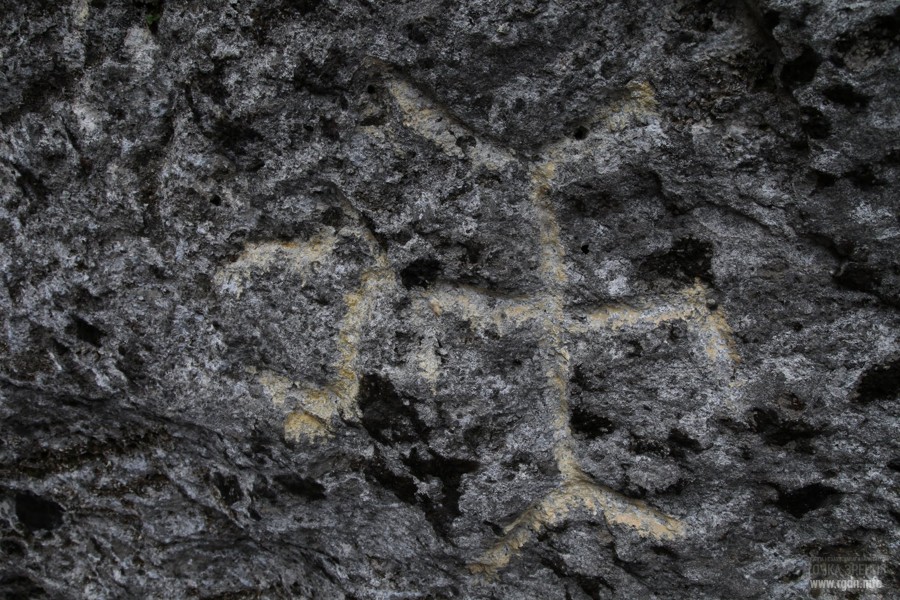
This looks like the script of Rapa Nui people.
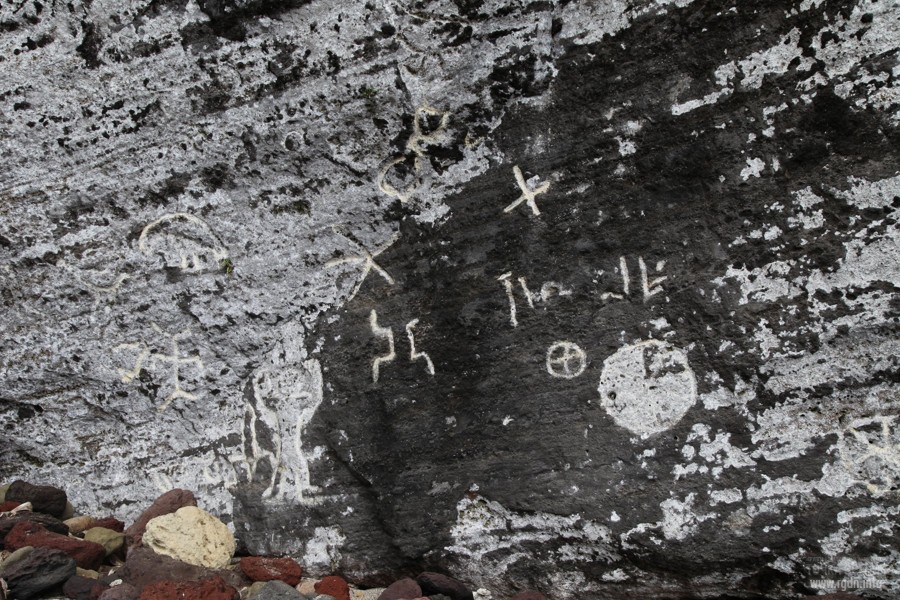
It seems to me the figure on the left below looks like a person with raised hands – the symbol of enlightenment. There are also an equilateral cross and a cross inside a circle...
This thin ring of dry land amidst the immense Pacific Ocean preserves remains of masonry of an ancient sanctuary:
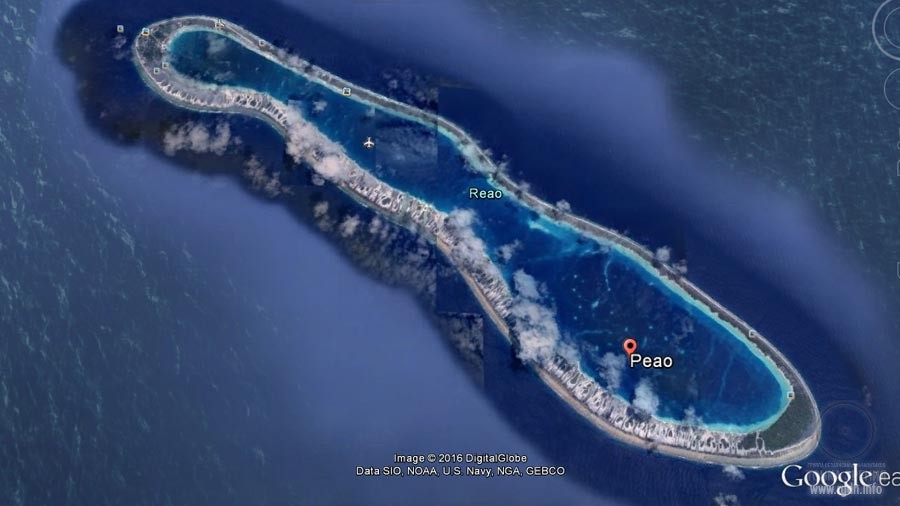
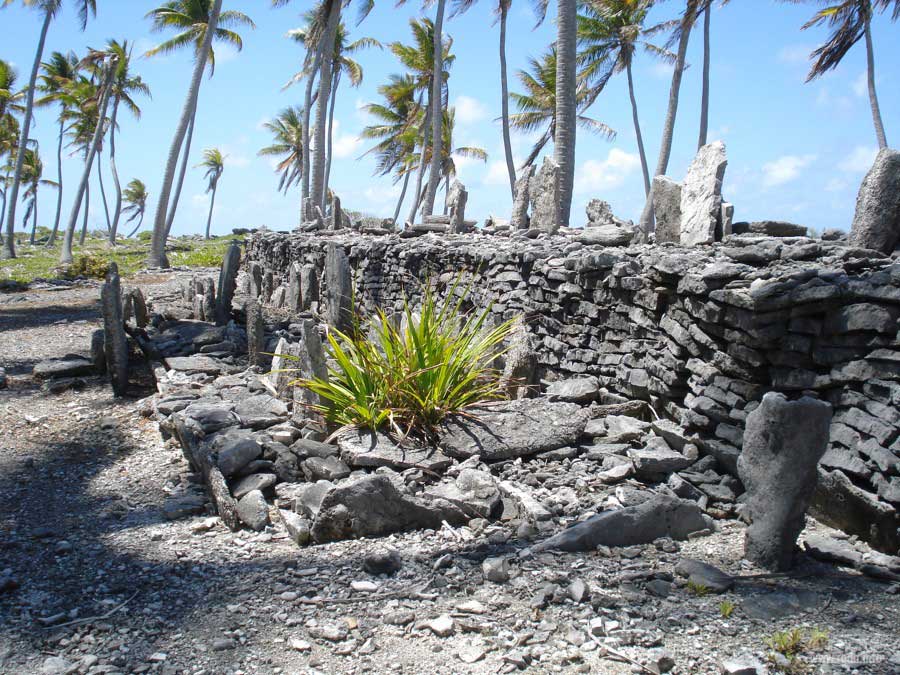
A group of scientists from the Australian National University, Canberra, headed by Professor A. J. Anderson, used advanced methods of radiocarbon dating to analyse the biological remains found in island swamps and ascertained quite credibly that the first Polynesian settlers landed at Rapa Iti circa 1150 AD. There is a real pyramid on the island!
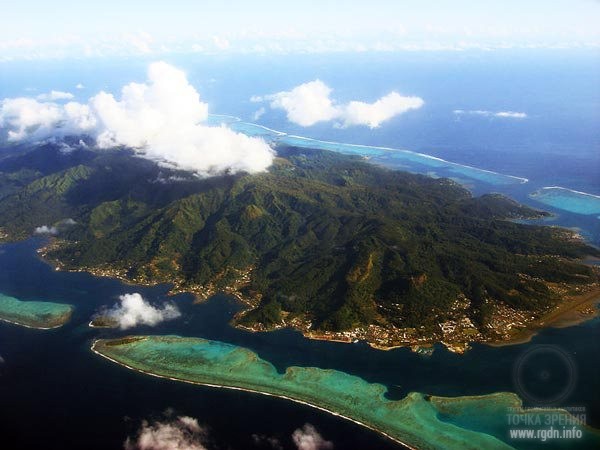
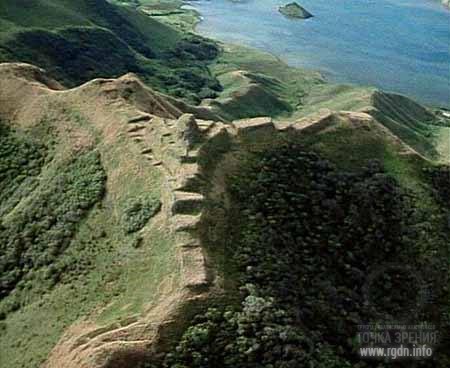
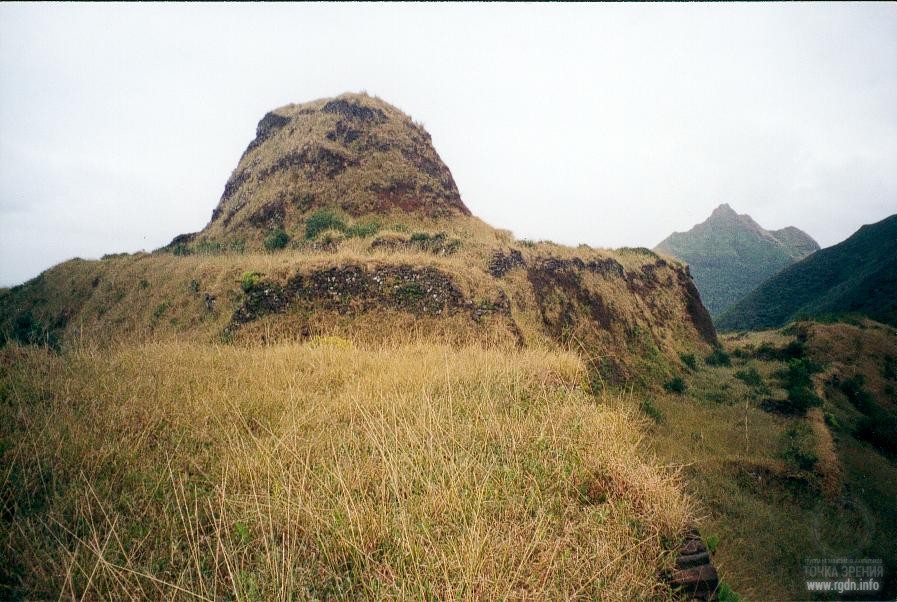
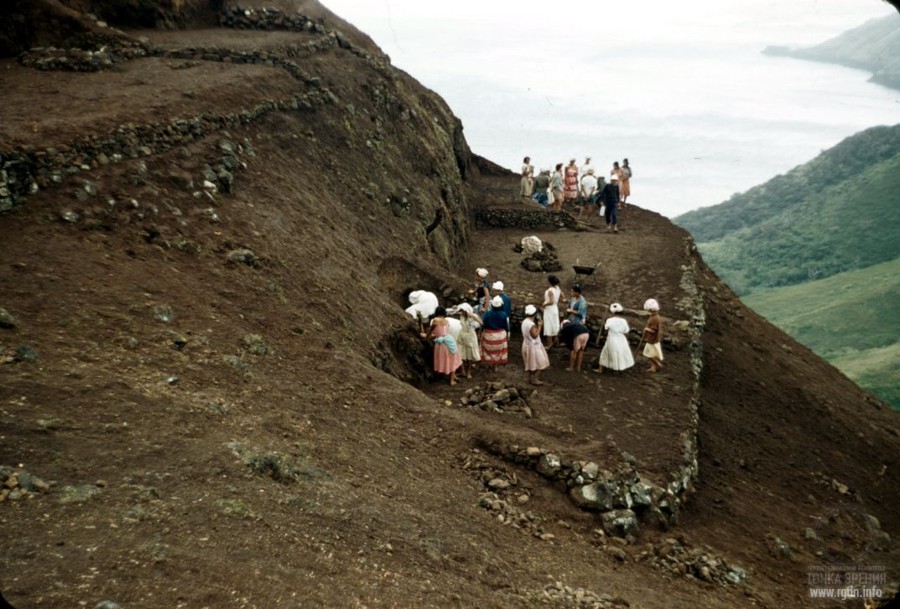
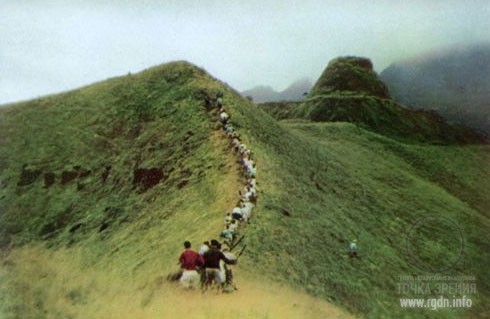
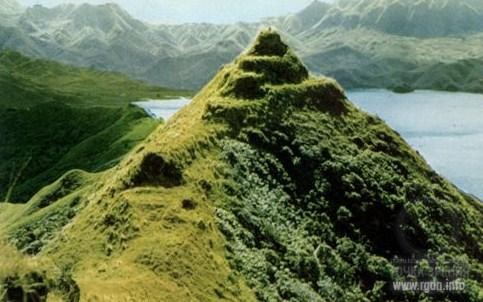
Local natives continued living in fortresses even after the Europeans had arrived, up until the 1820s when diseases and alcohol decreased the island population by almost one third, whereas those who survived settled around the Catholic mission in the place where Aurei Village is now situated.
Stone marae and a statue of god Tiki have been found:
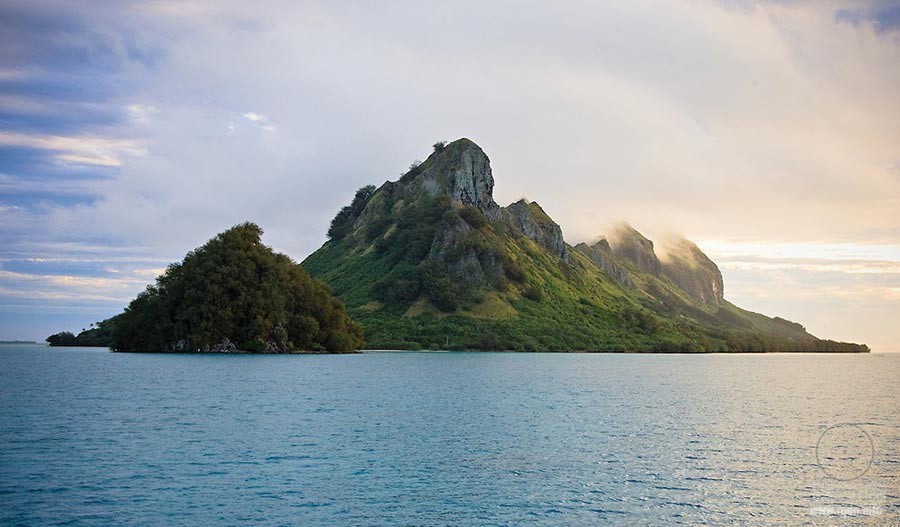
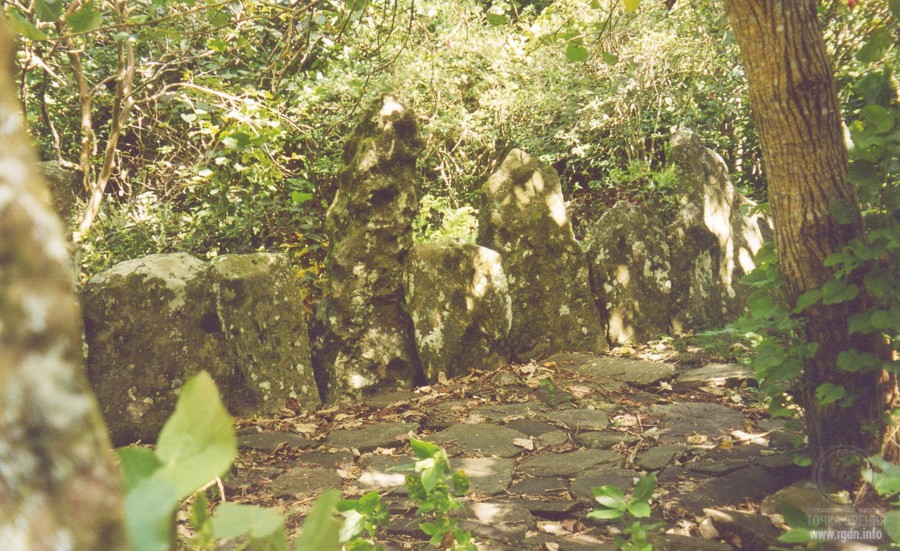
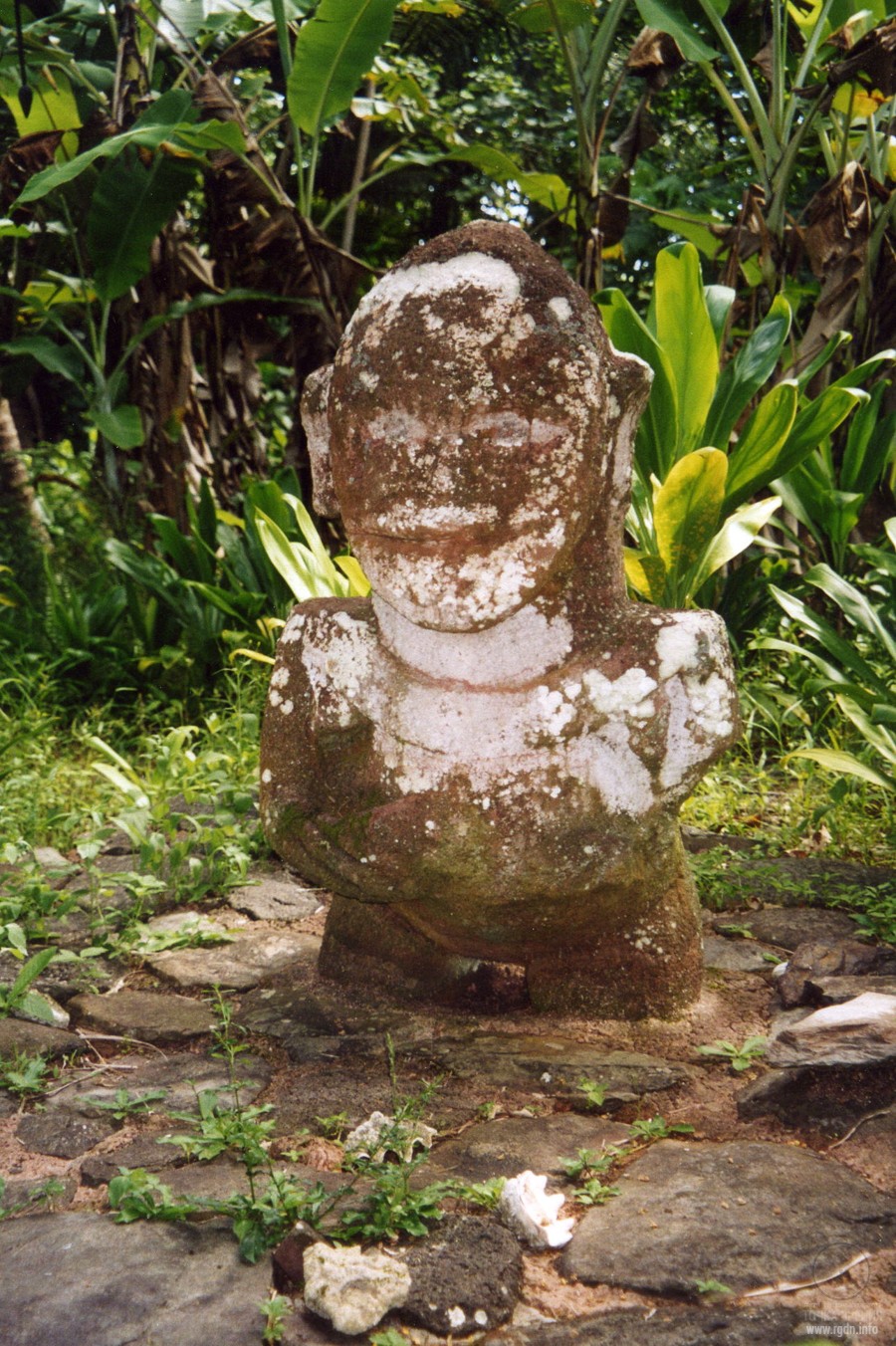
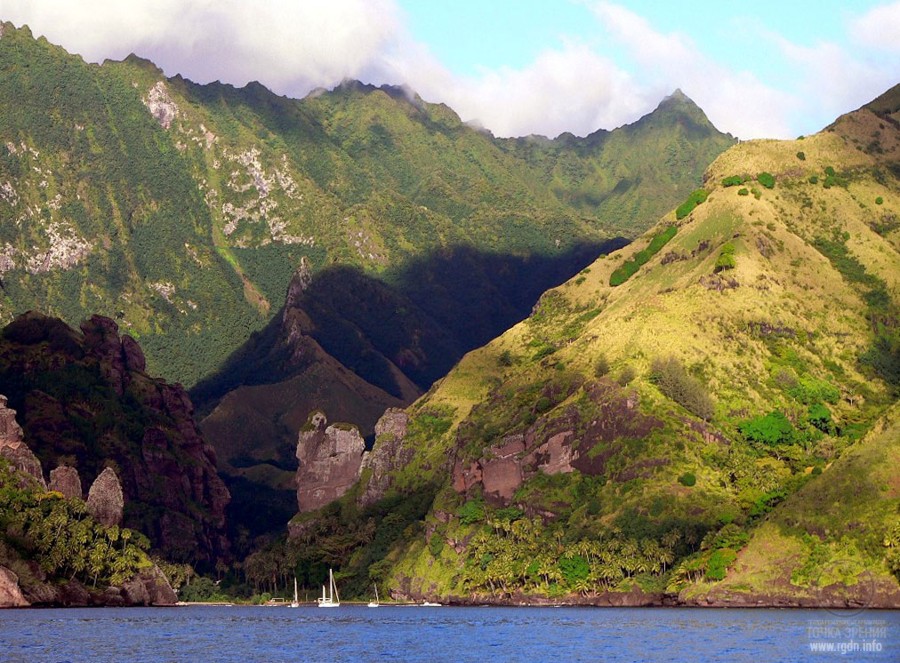
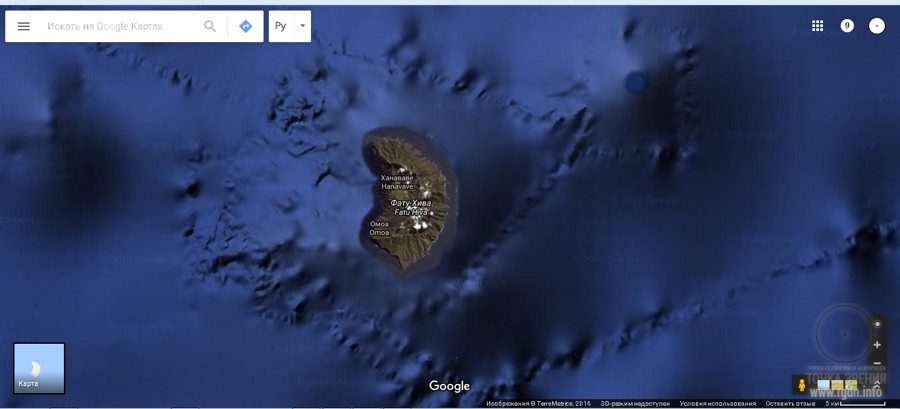
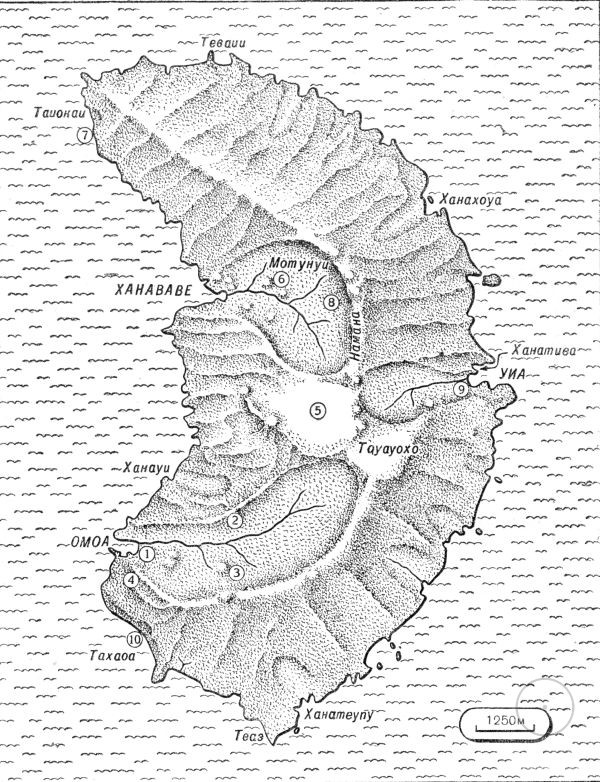
Fatu Hiva Island layout (looks like a crescent)
1 — the shore where we landed; 2 — our bamboo hut; 3 — rock paintings; 4 — ancient ruins and skulls; 5 — unexplored plateaus; 6 — a tabooed forest; 7 — “the night water”; 8 — ruins, idols and drawings on stones; 9 — our “pile hut” in Uhia Valley; 10 — the cave – our last dwelling
There is another interesting piece of dry land in the very middle of the Pacific Ocean. It’s Fatu Hiva (the southernmost island of the Marquesas Islands) with its numerous stone idols in the hands-on-the-belly posture repeatedly mentioned in the previous articles and commentaries on ancient cultural monuments. Let me suggest to you a little photo tour, but first I would like to present a picture taken on Fatu Hiva by Thor Heyerdahl. In one of his books Hunt for Paradise Heyerdahl describes the remote 1936, when right after the marriage he and his wife Liv lived for a whole year on this isolated island away from civilization.
An extract from the book:
"... We were ascending higher and higher, and the further we went the harder it took us walking. It was stifling, and we were drenched in sweat. Above the steep slopes of Tauauoho storm clouds were hanging. Rain was pouring up there almost incessantly. No matter how blue and clear the sky over the ocean was, the mountain top always wrapped itself up in a shaggy cloud. As for the slopes, there were either dizzy precipices or such thickets that no axe could hack the road to the top. There was no room to put your foot: the earth was covered with wind-fallen trees, compact webs of branches and putrescent trunks. Yet, we were not going to conquer the top of Tauauoho. We went to the forest to see the marvellous fish discovered by the islanders. That fish is totally amazing – it is stone!
We were moving farther through the wet brushwood. Soon we found ourselves on a slope that descended towards a stream. The forest here was sparser. A gigantic tree had swept everything away while falling. Our friends explained that was a sacred tree, one of those which had been planted here a very long time ago. Two solid stone plates were lying right near the fallen trunk, almost totally covered with coffee bushes. The Polynesians agitatedly pointed at the lateral face of the largest plate.
... On the mossy surface of the stone we saw a carved image of a marvellous fish, two metres long from its head to the mighty caudal fin. The fish was surrounded by mysterious drawings. Beyond all doubt, in ancient times all the symbols had a magic meaning. The upper face of the plate was totally flat, though later on I noticed several grooves on it. What was the point? I asked the islanders to clean the brushwood and take greensward off. Another huge plate emerged, covered with strange signs. The Polynesians got excited and started conversing in whispers. We cleared the stone of rubbish, and more drawings appeared before our sight – primitive images of men and women, obscure lines… The islanders were looking at those reverently. As if enchanted by the sunlight, the grotesque figures lay petrified at our feet. They had been dancing for many centuries since the time when a mysterious culture established by enigmatic people ruled over the Marquesas Islands, the people totally unknown to science… Where were those people from? Who were they? Thick walls and terraces made of huge stones are everything that remained since those ancient times. The people who lived here were kindred to those who once erected the marvellous statues on Easter Island.
We were looking at the stone plates as if covered with unknown ciphers. For the first time in those places petroglyphs were discovered. Having looked closely, we discerned not just human figures among them, but also fish, turtles, magic masks, and wide-open eyes. We failed to discern some of the drawings though. What was that – millipedes, lobsters or long boats with paddles? Some elements were erased by time. At that, the images were so numerous! In the brushwood nearby we found a stone platform edged with a wall on which very big eyes had been carved. Could those be ruins of an ancient temple?”
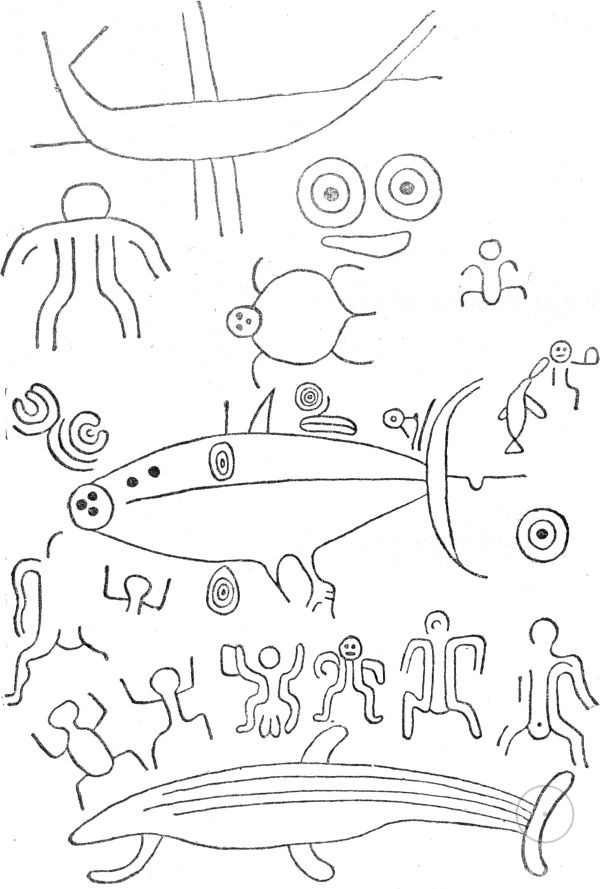
Looking at this picture, I recalled a documentary about Jacques-Yves Cousteau’s expedition to Easter Island. Let’s compare the images. Aren’t they alike? In the meantime, the distance between Rapa Nui and Fatu Hiva is thousands of water kilometres!
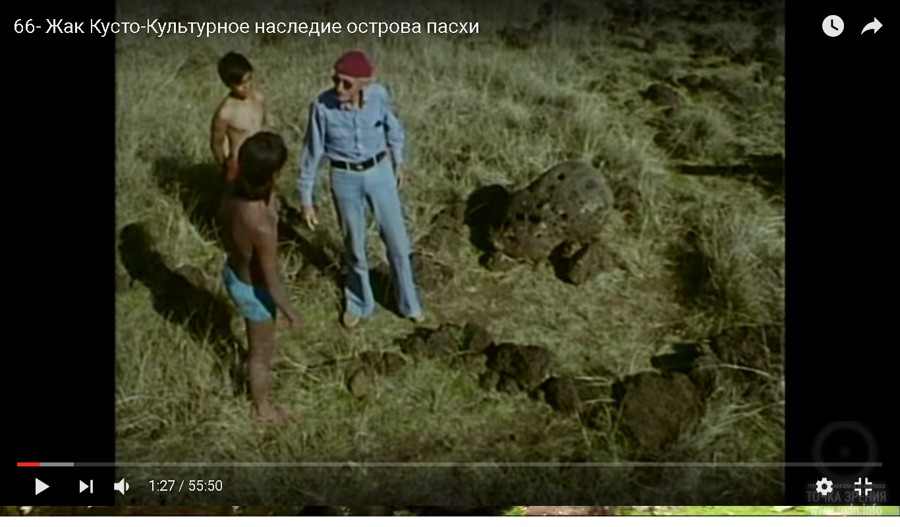
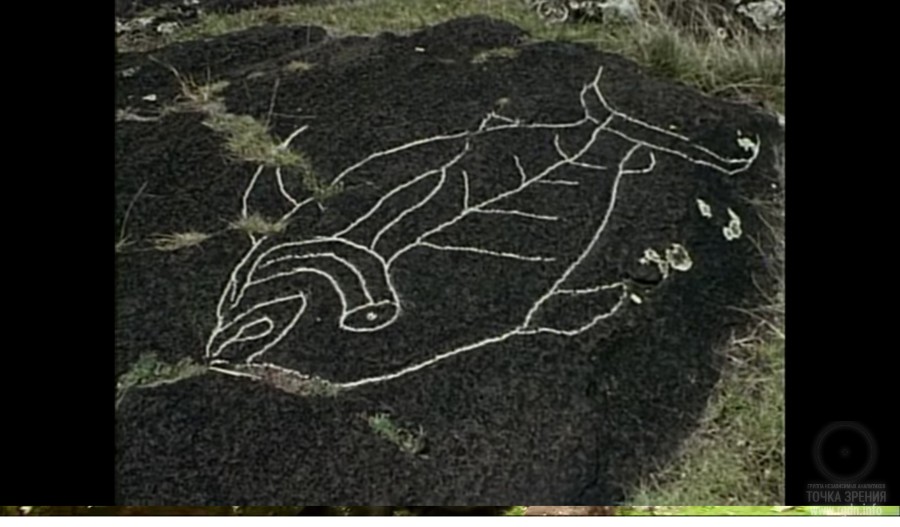
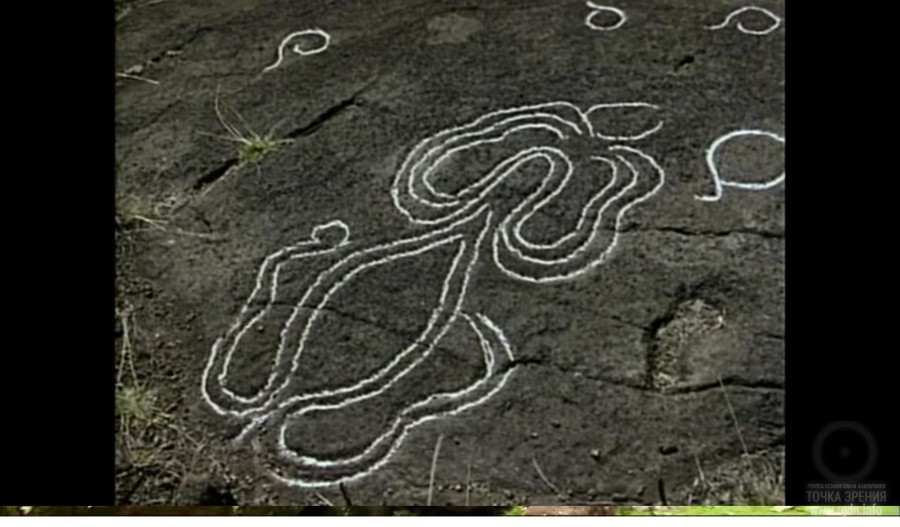
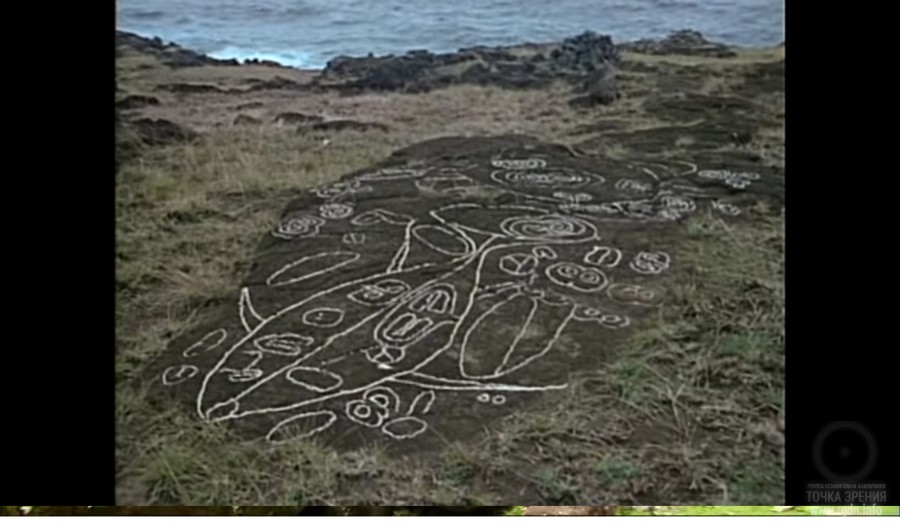
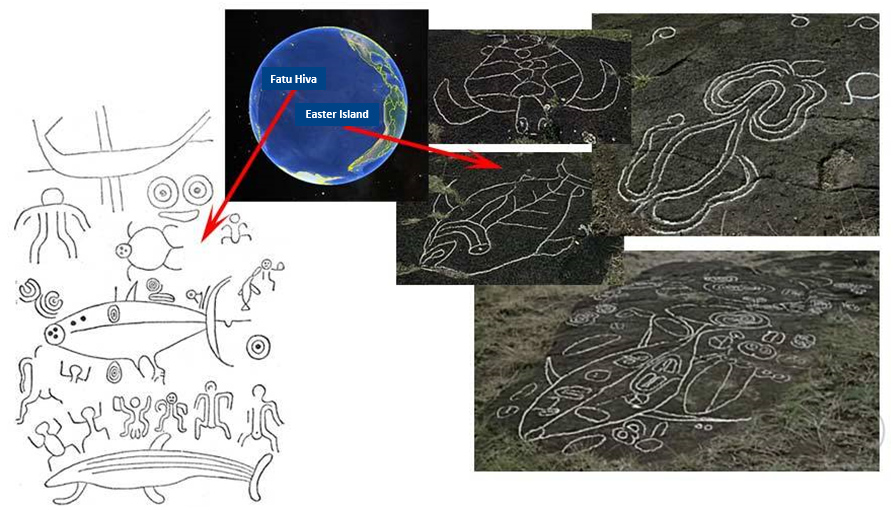
Who made these rock paintings, and for which purpose? There was definitely some purpose, as we understand. May this be a way to transfer spiritual knowledge? Everything fades away, but stones bear centuries-old memory. Residing on the opposite side of the globe, I cannot judge what the age of drawings and stone statues on Fatu Hiva is. The only thing is clear: the makers of drawings and statues on different Pacific islands “graduated from the same arts school”.
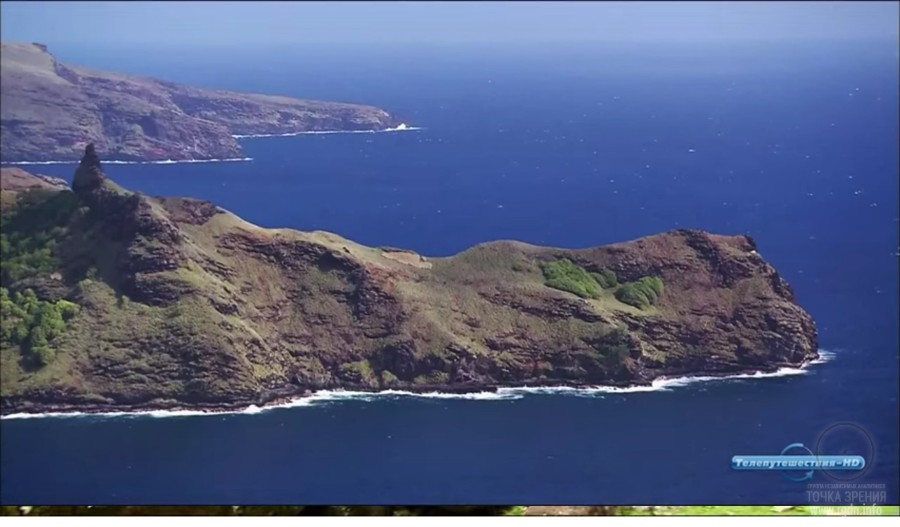
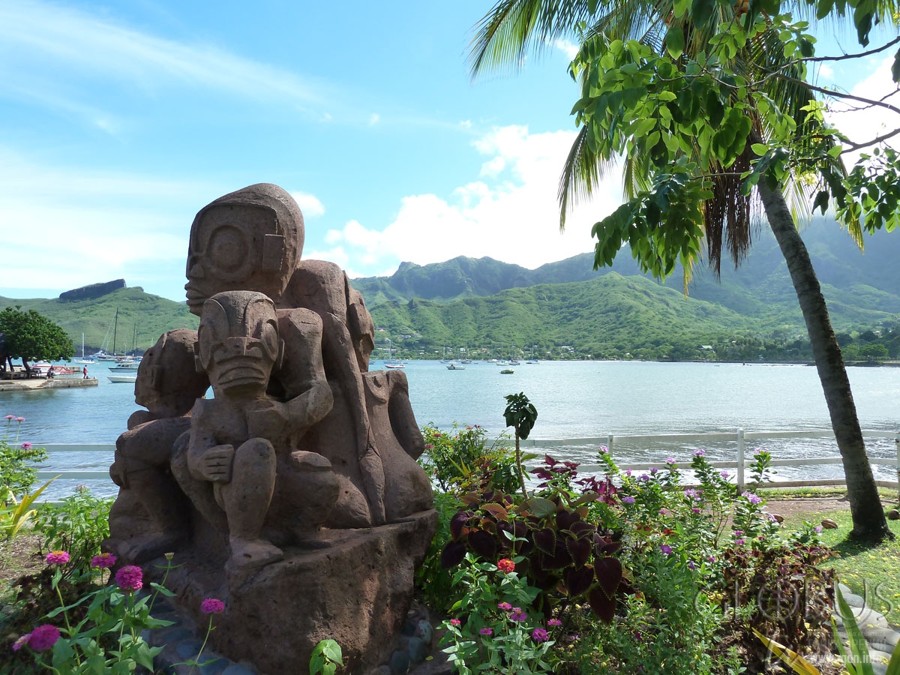
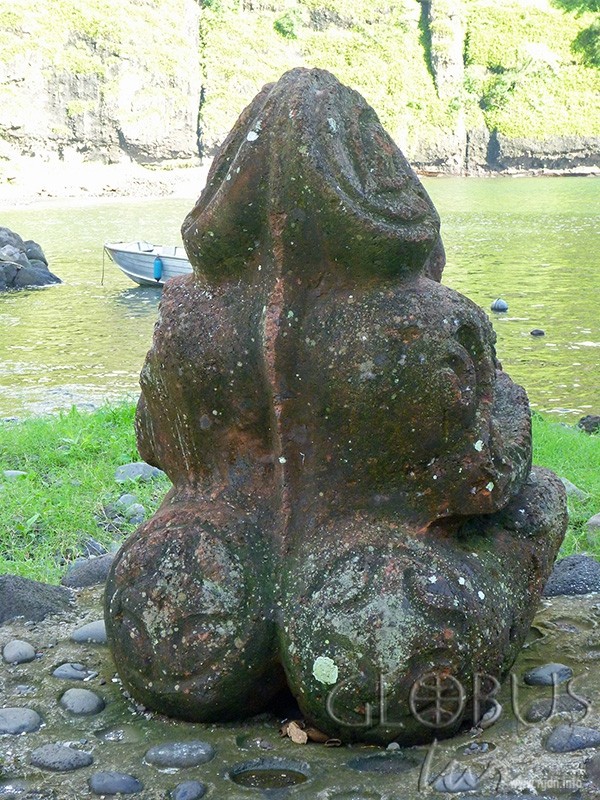
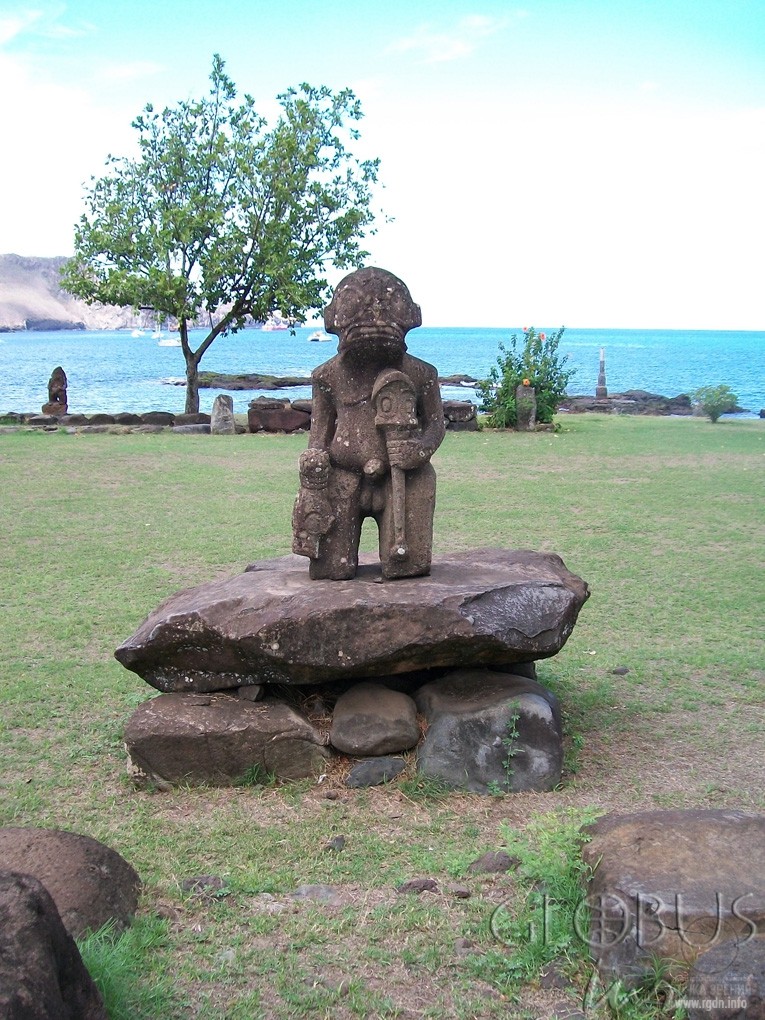
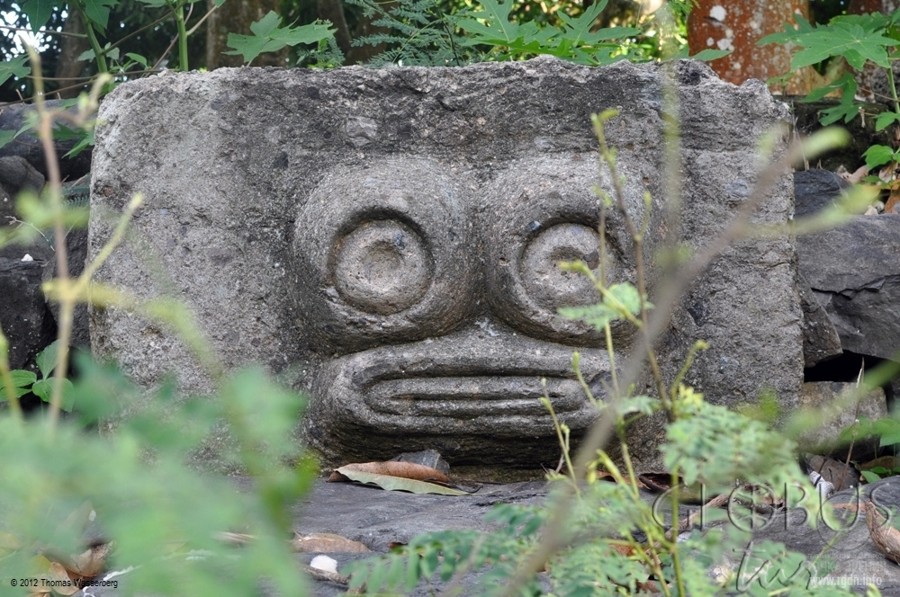
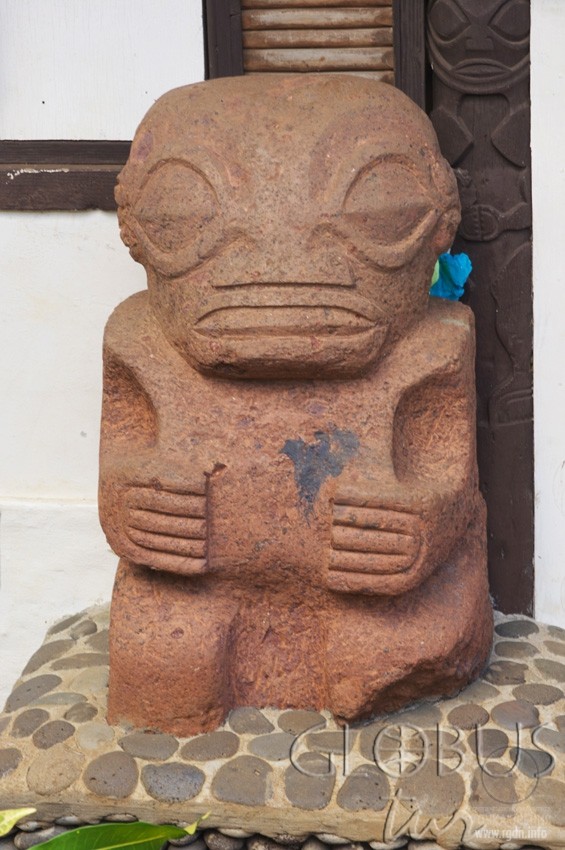
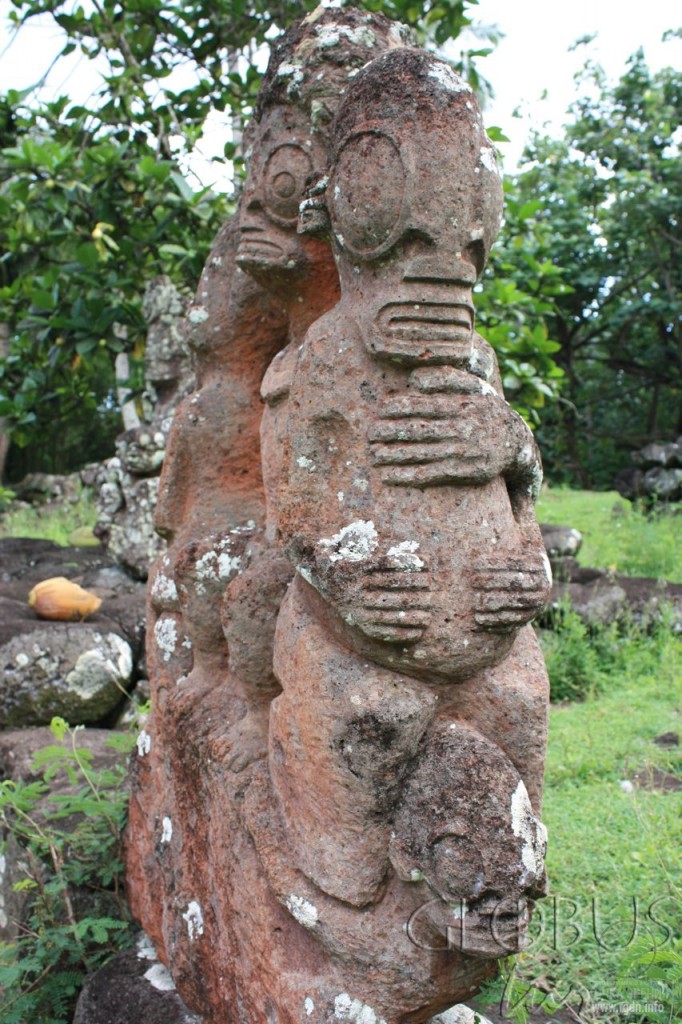
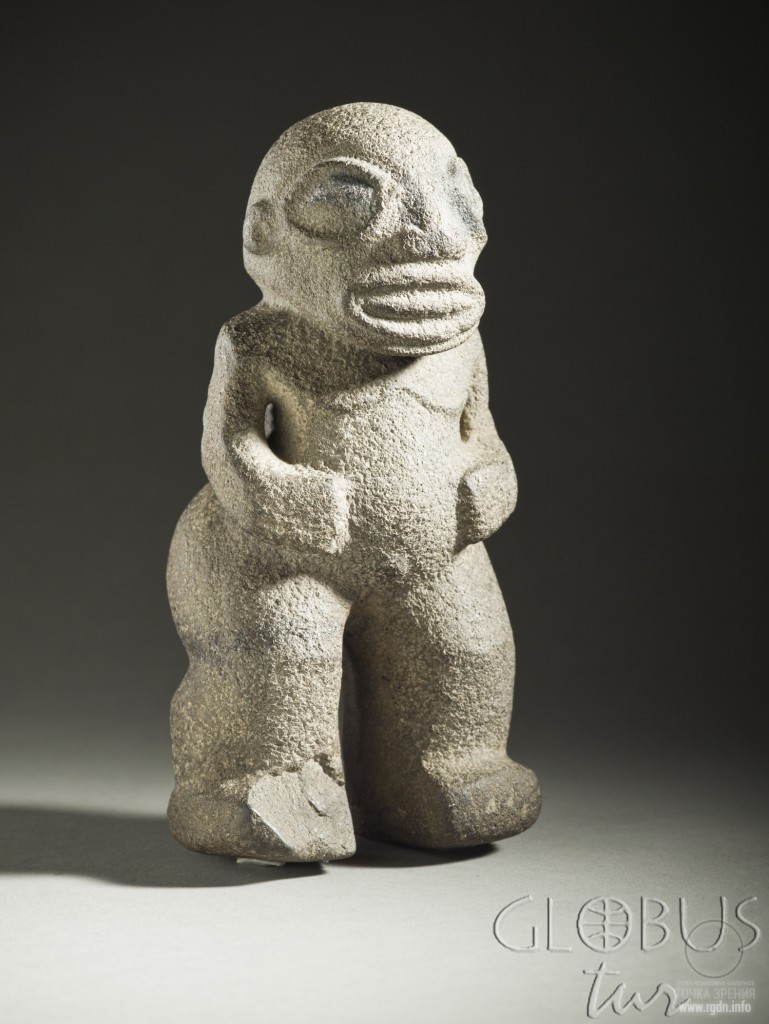
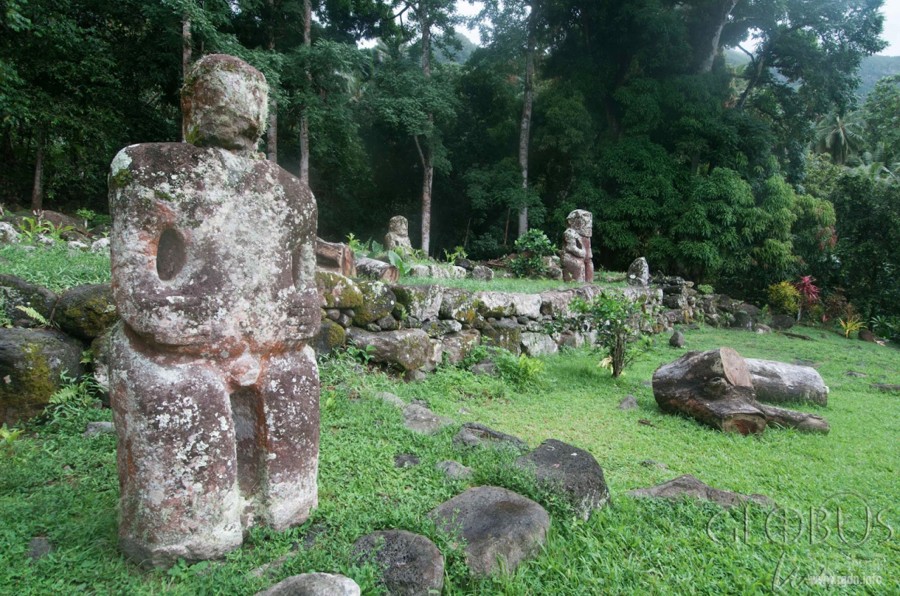
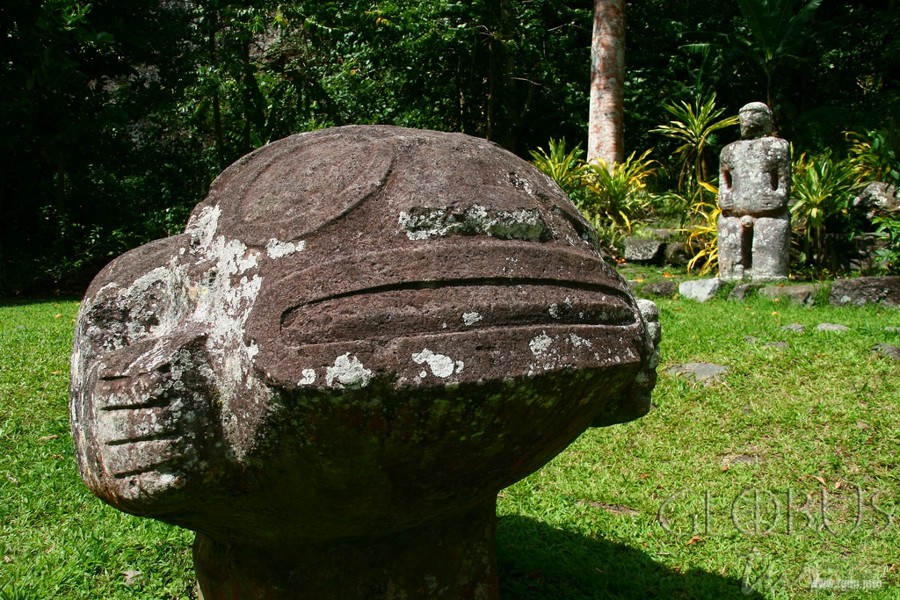
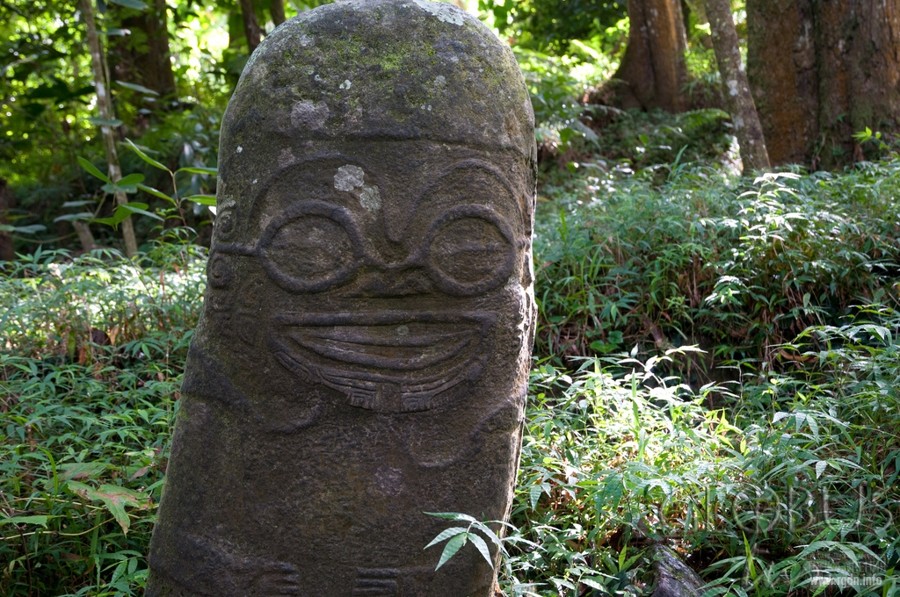
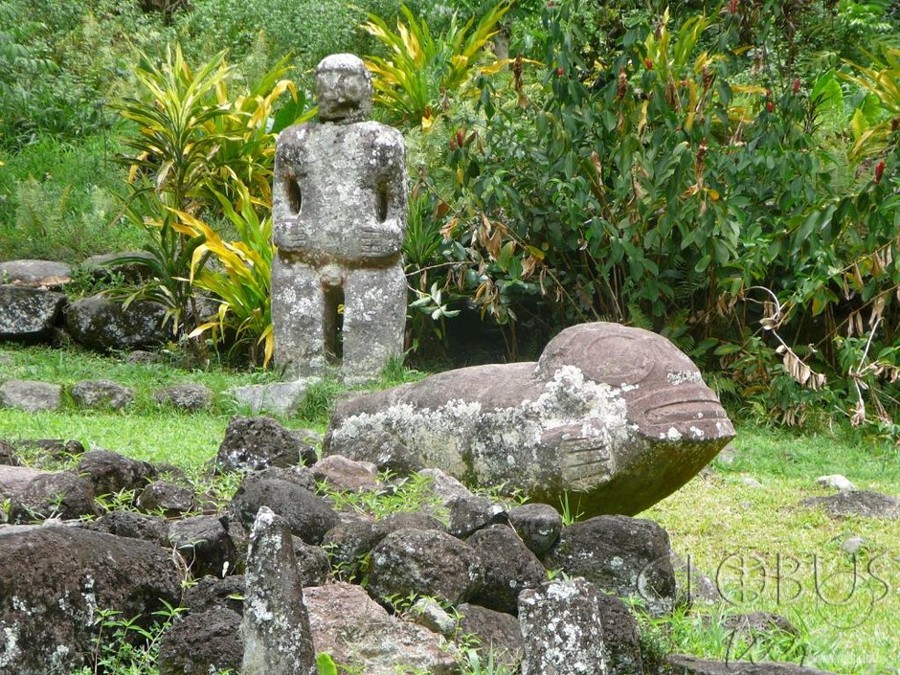
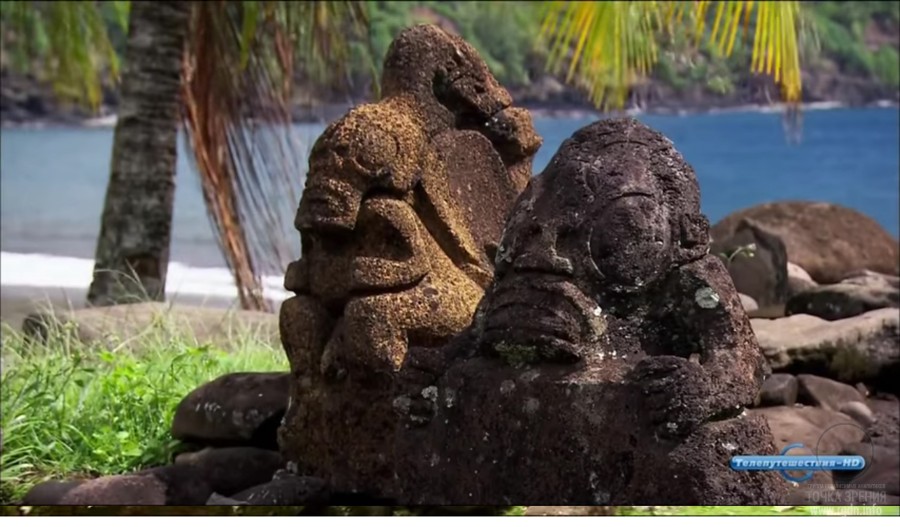
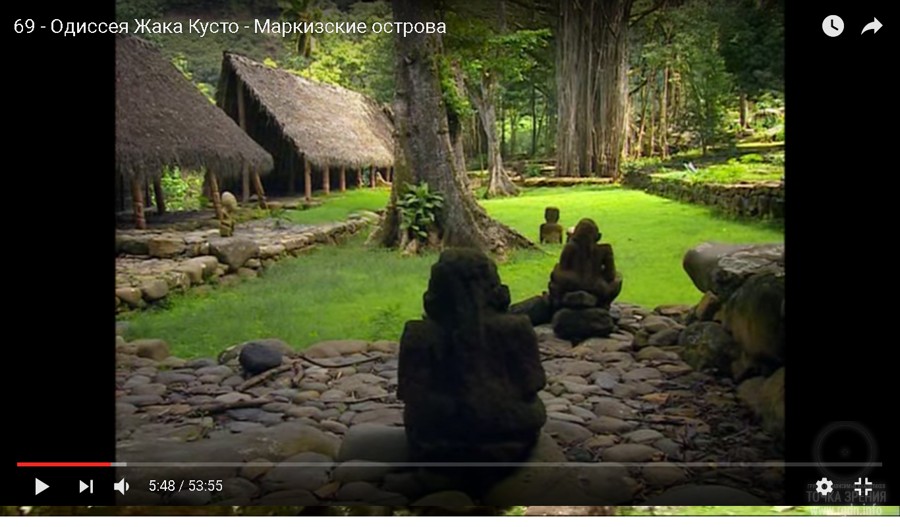
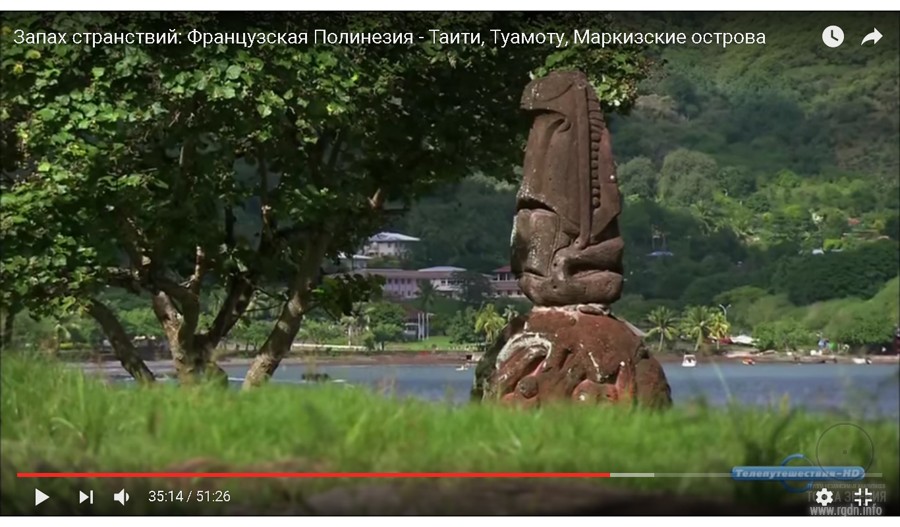
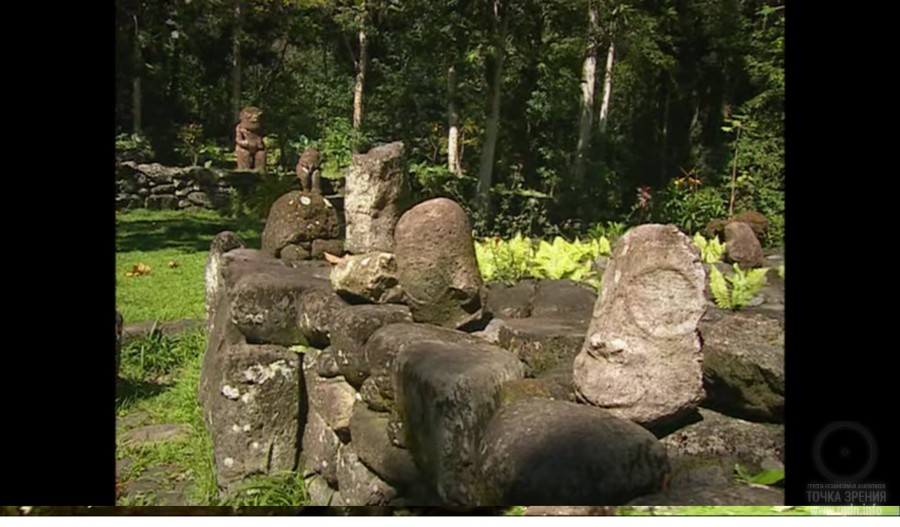
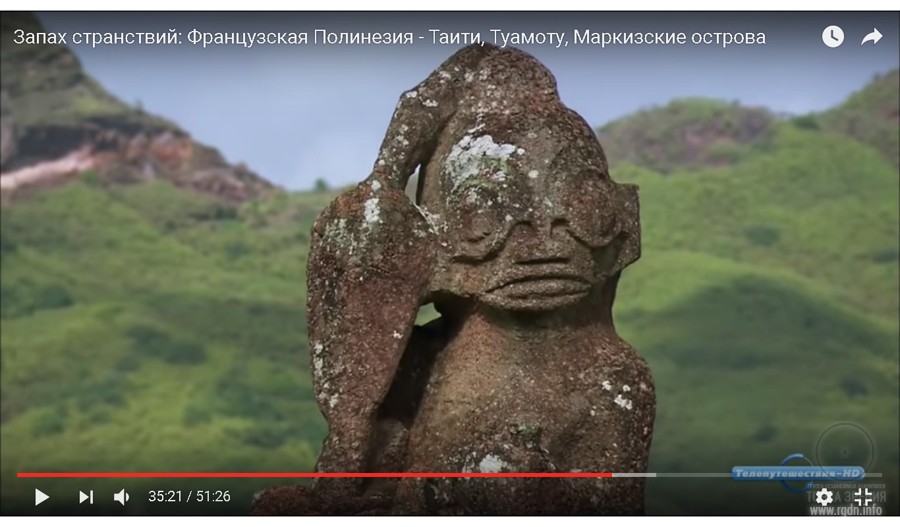
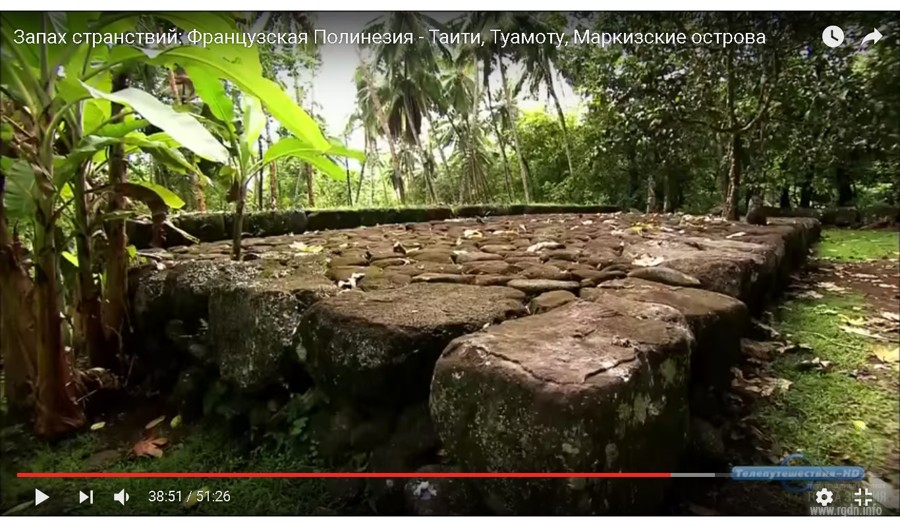
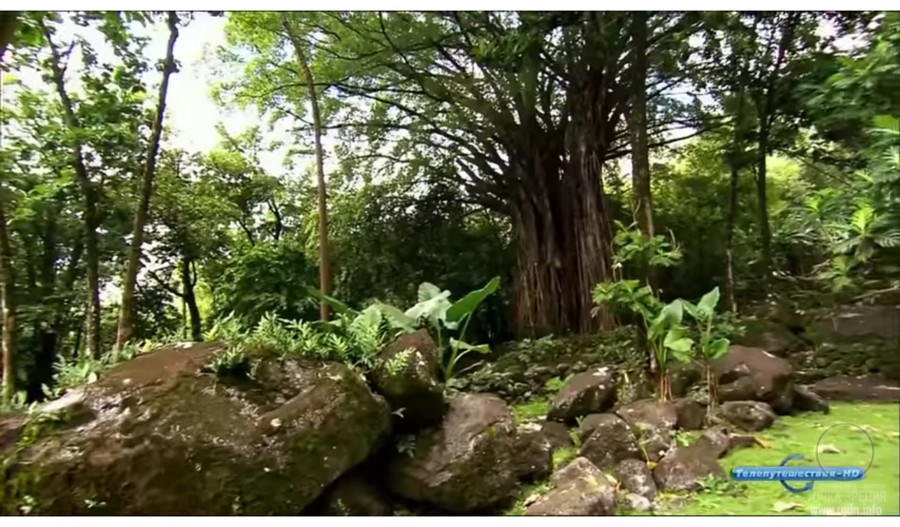
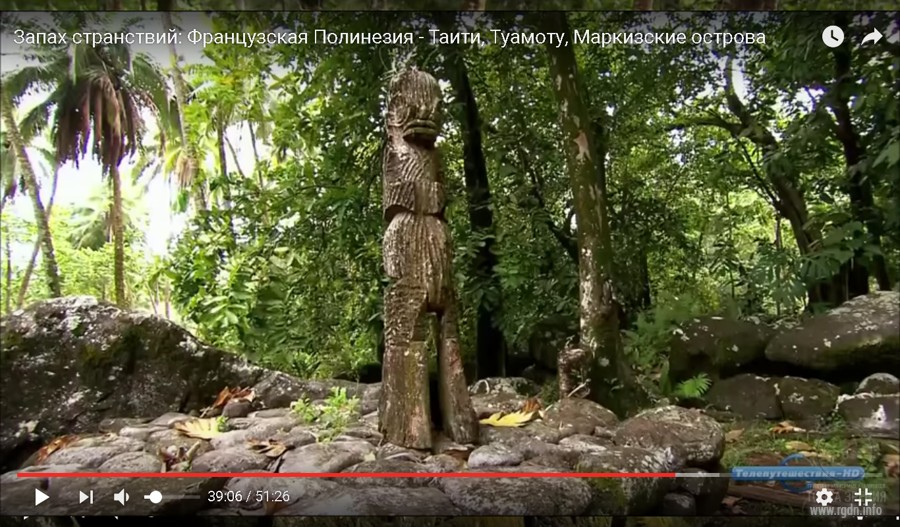
Among the Marquesas Islands there is another land where similar ancient statues are found. It is Nuku Hiva, the largest island of the archipelago, located northward of Fatu Hiva and famous for its stone “reptilians” as many tourists and researchers call them. These are really strange figures:
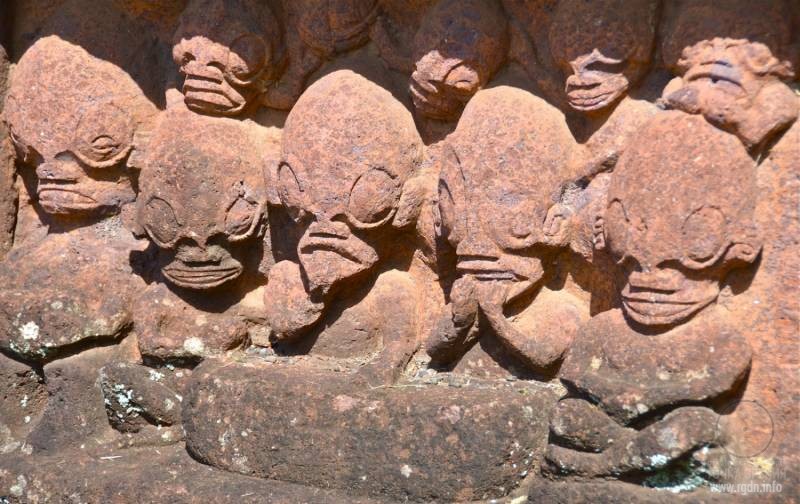
Tahiti, the largest island of the Windward group of French Polynesia, with its capital city of Papeete, is one more island in the Pacific Ocean where similar stone sculptures of once revered deities are found. This place is well-known for its picturesque views, tourism, and so forth, but we are mostly interested in traces of spiritual knowledge, so I will limit myself to some images discovered on the web. It turns out there are even stone pyramids on Tahiti. They are not high, but the fact of their existence is significant. If there are pyramids, this means there lived people who possessed advanced spiritual knowledge.
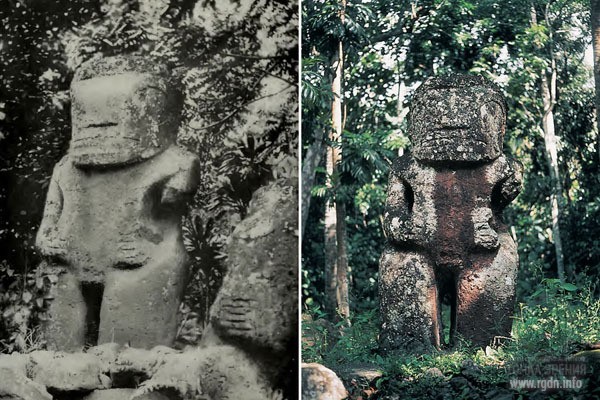
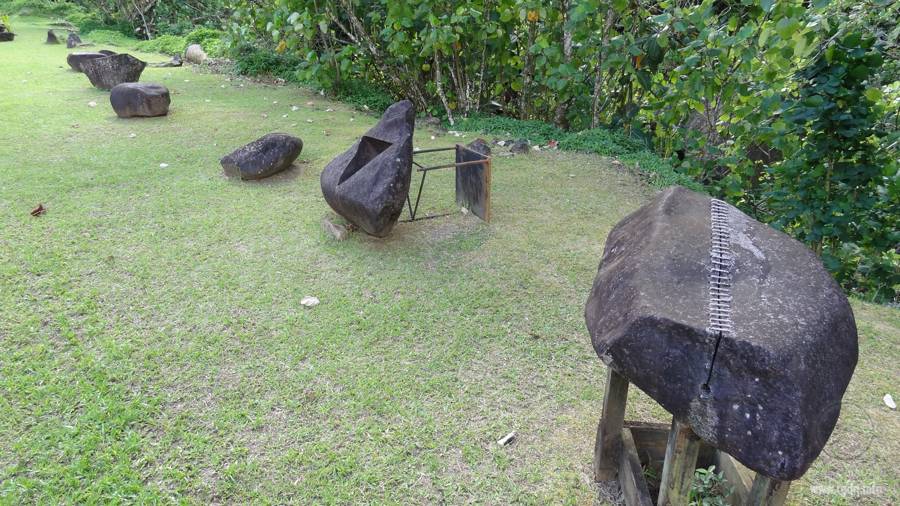
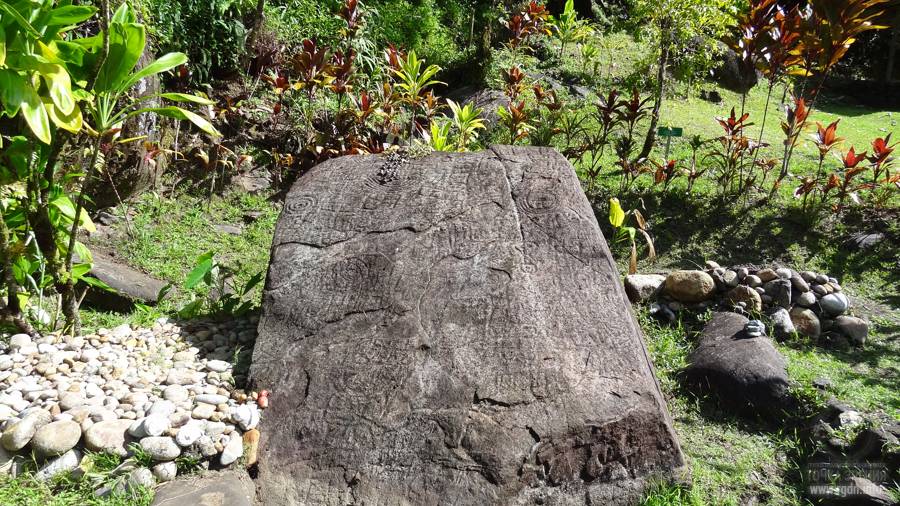
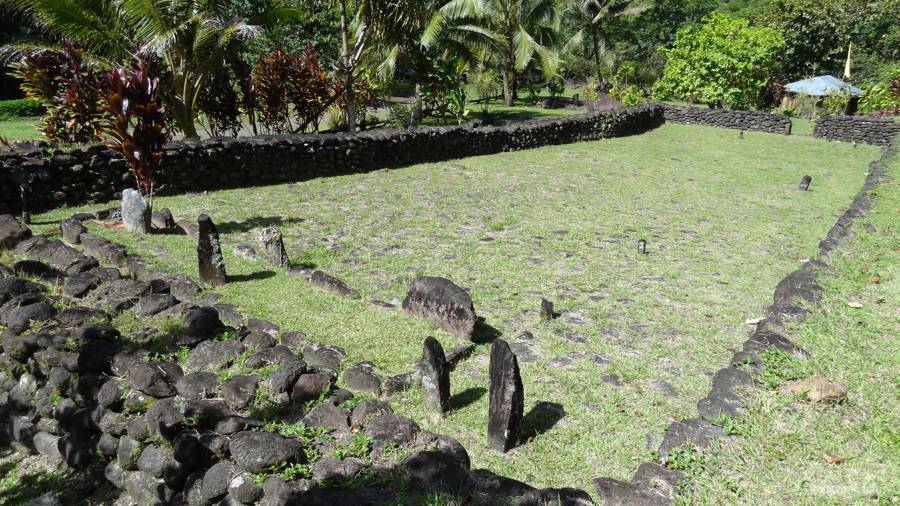
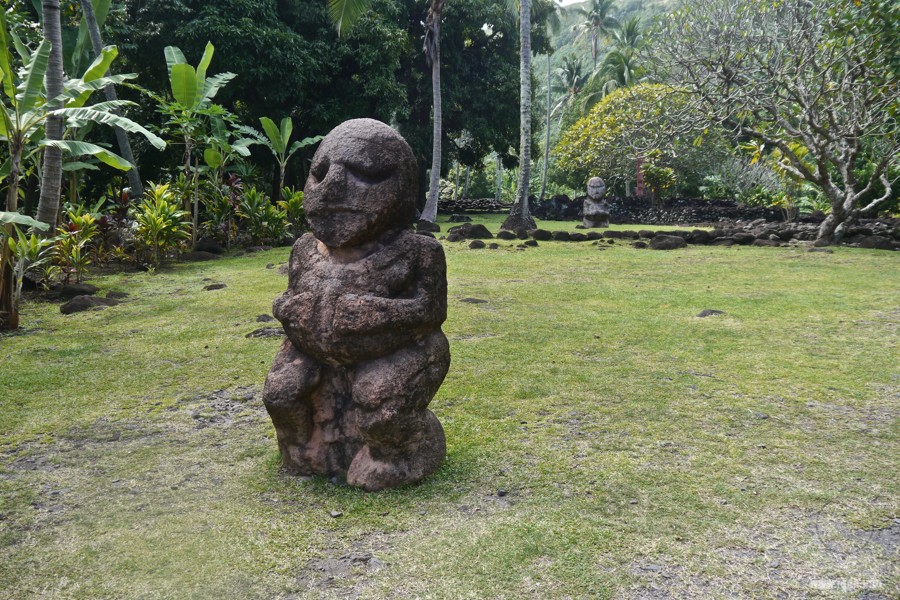
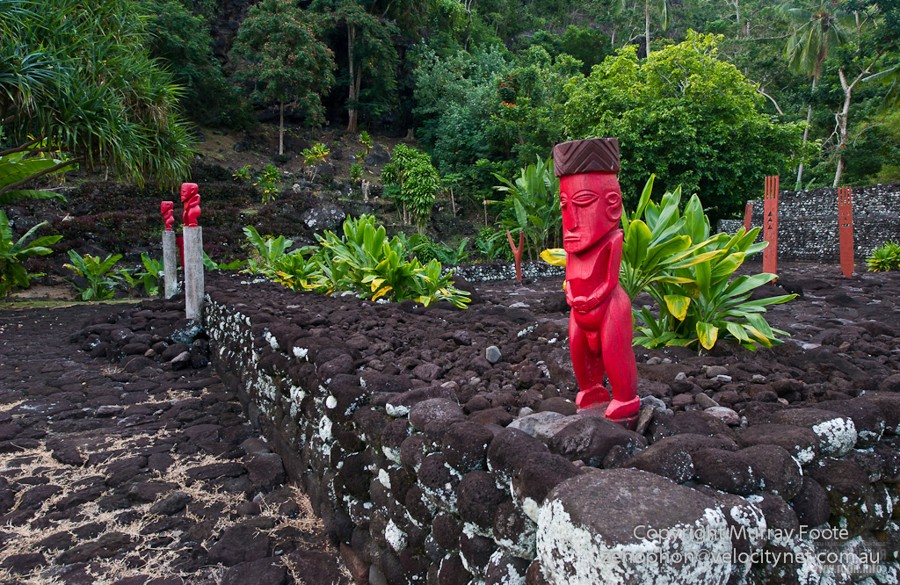
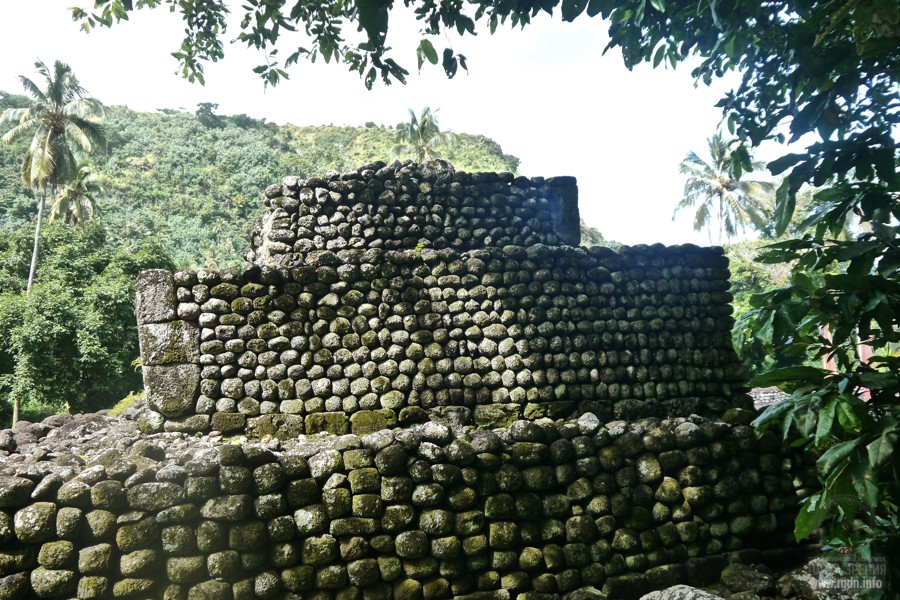
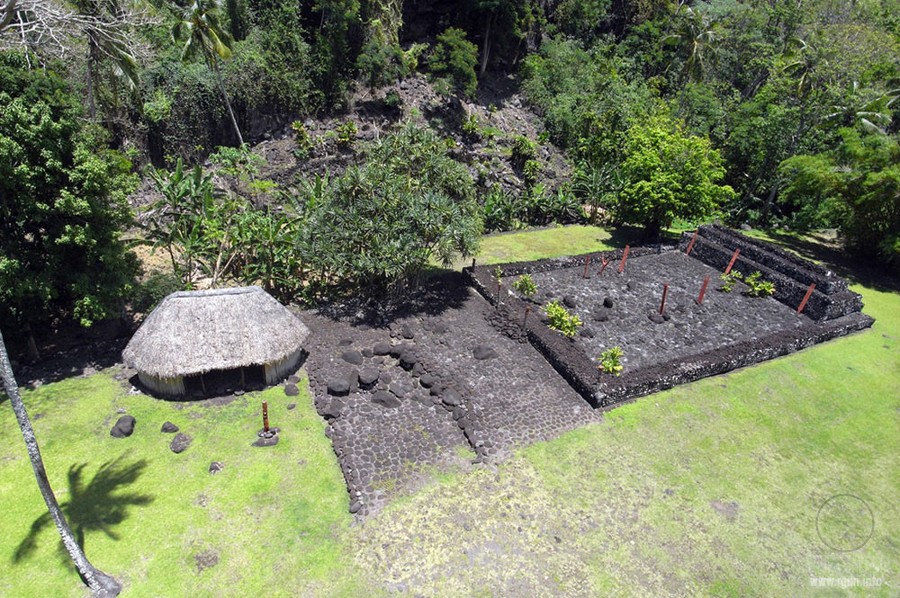
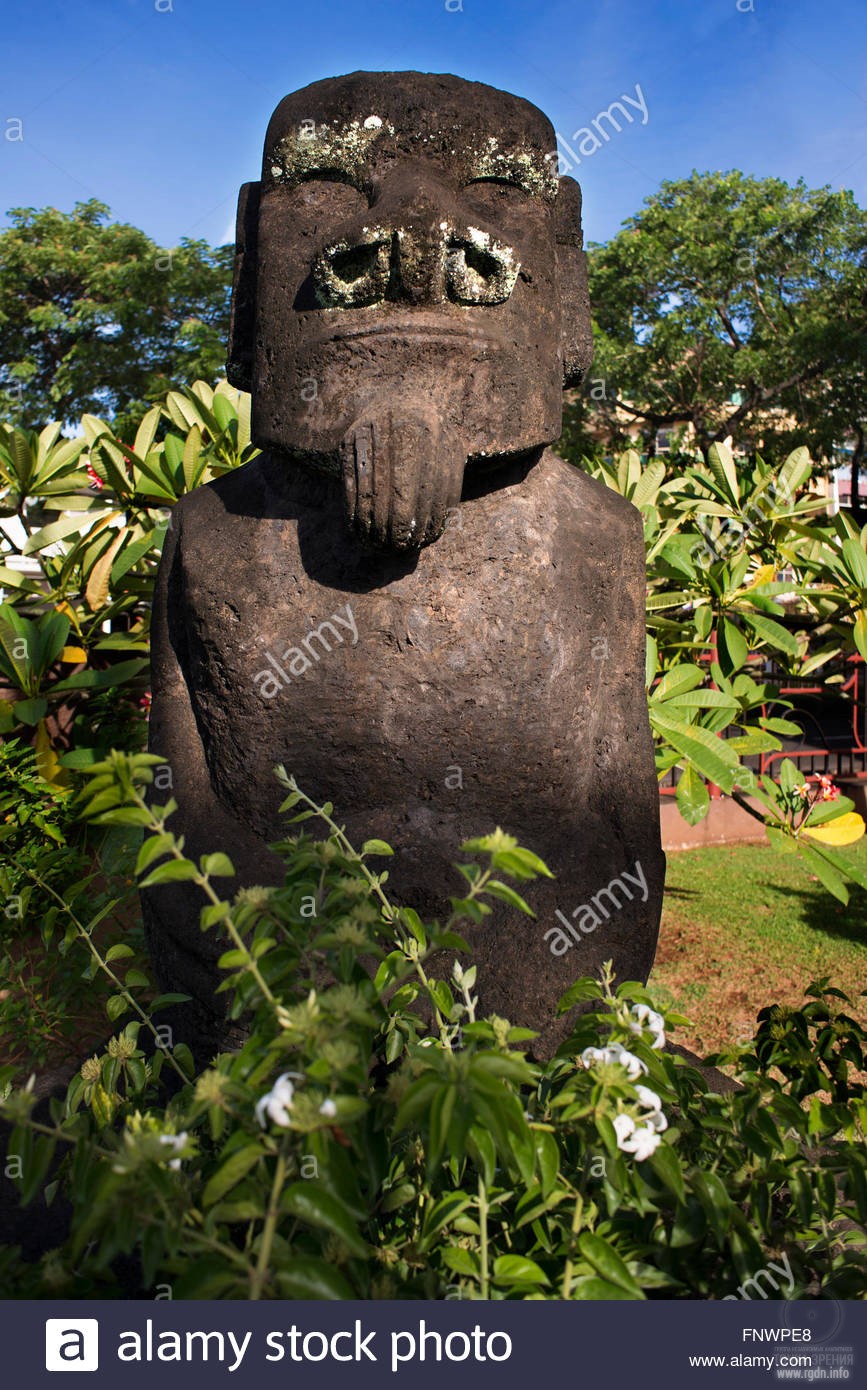
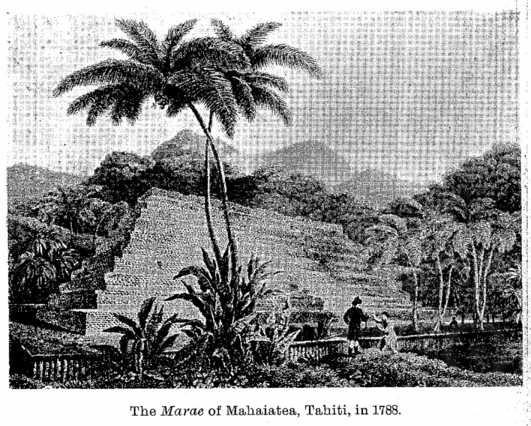
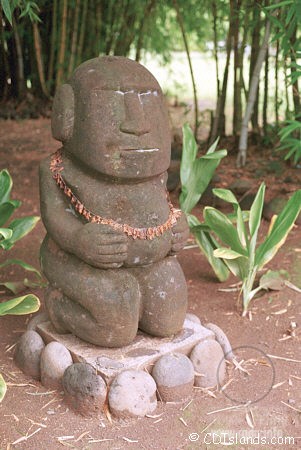
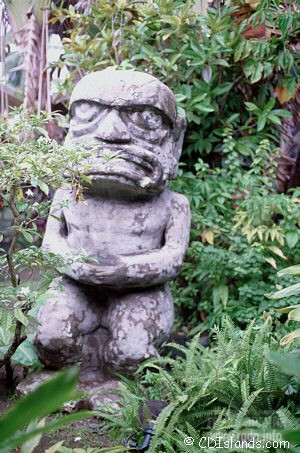
Next to Tahiti there is Moorea – a little island of French Polynesia, which has a rather unusual three-cornered shape:
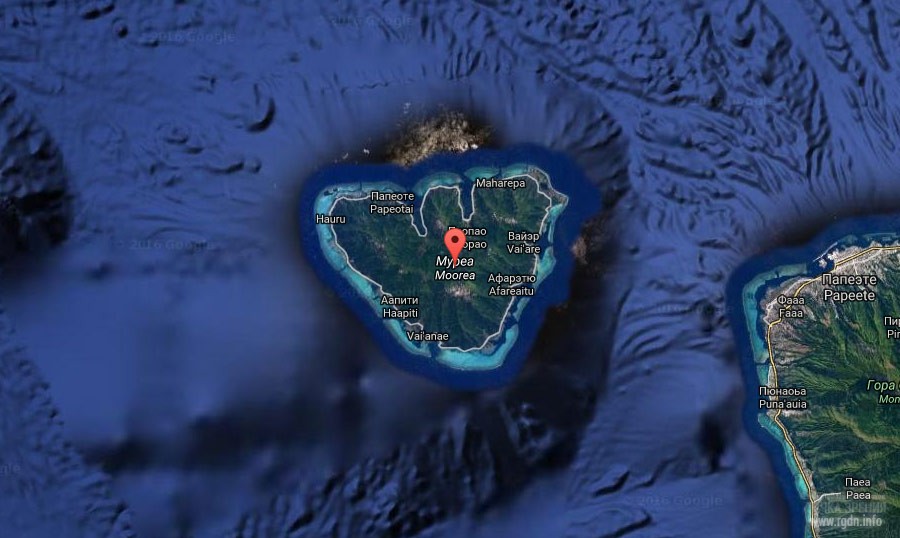
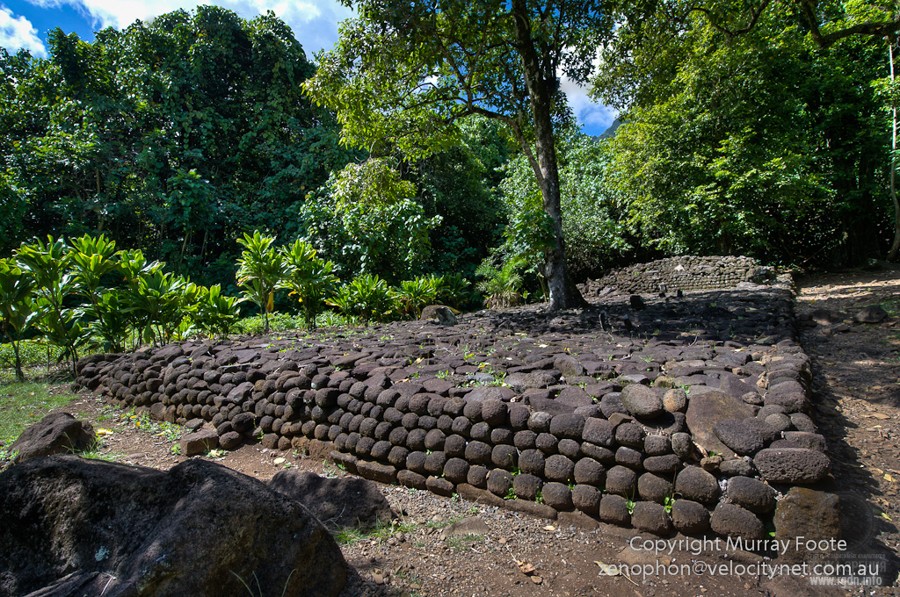
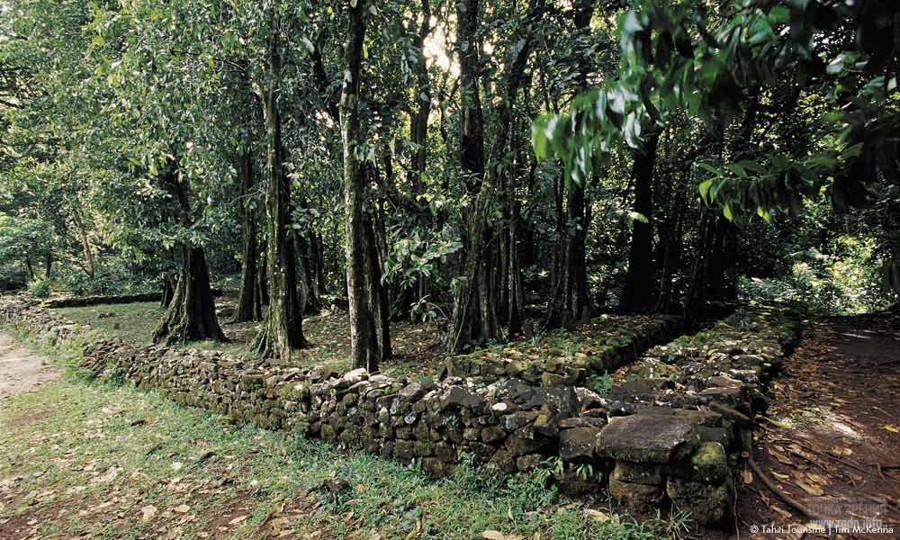
On this island there is famous Marae Taputapuātea – a large complex of stone platforms on the ocean shore, as well as many other ancient structures.
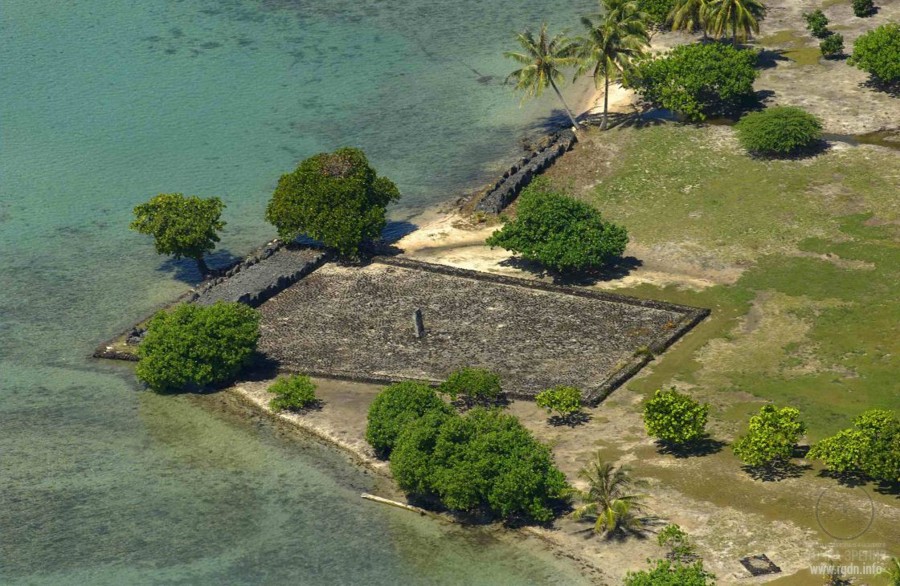
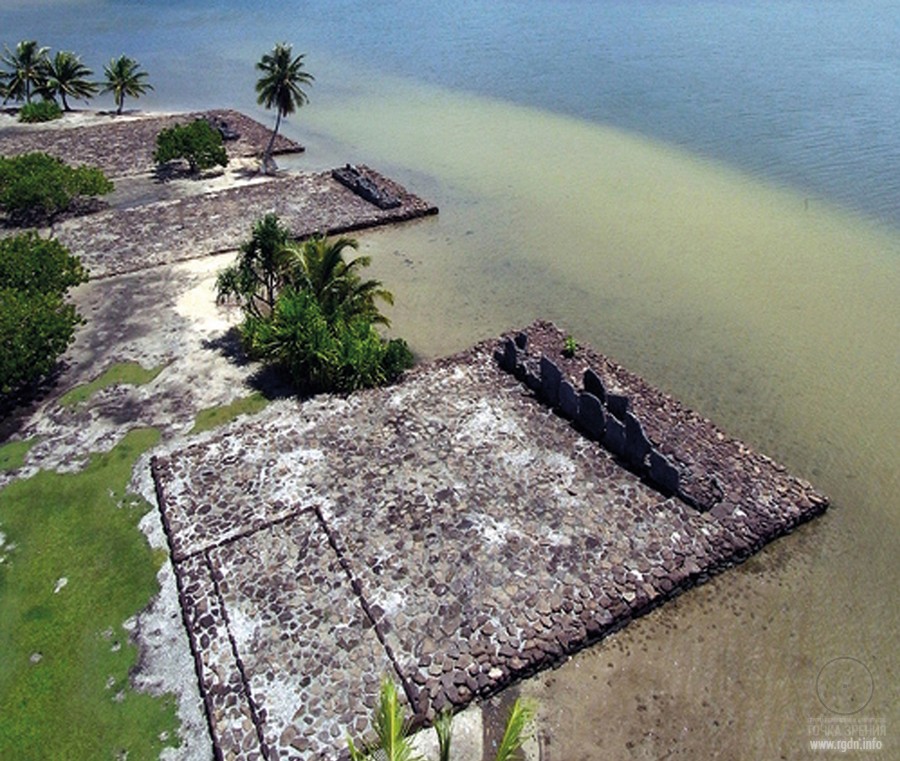
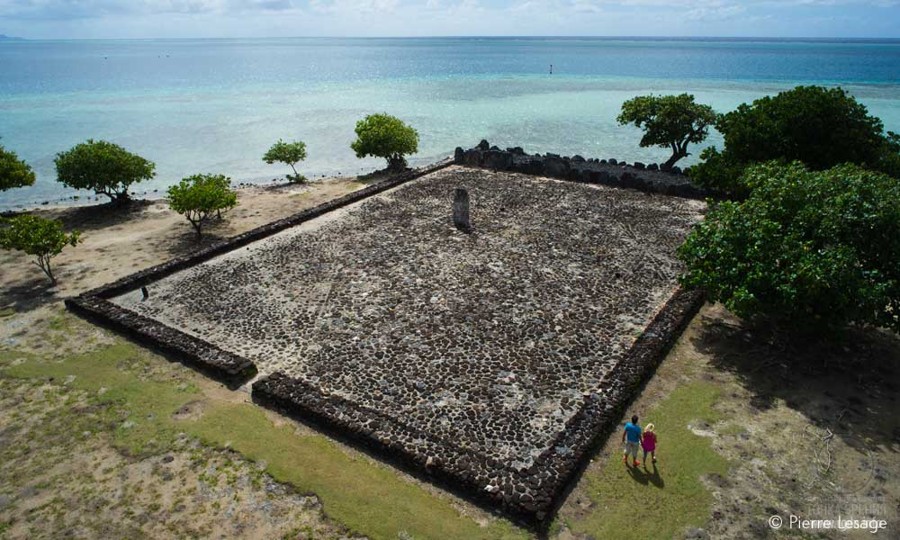
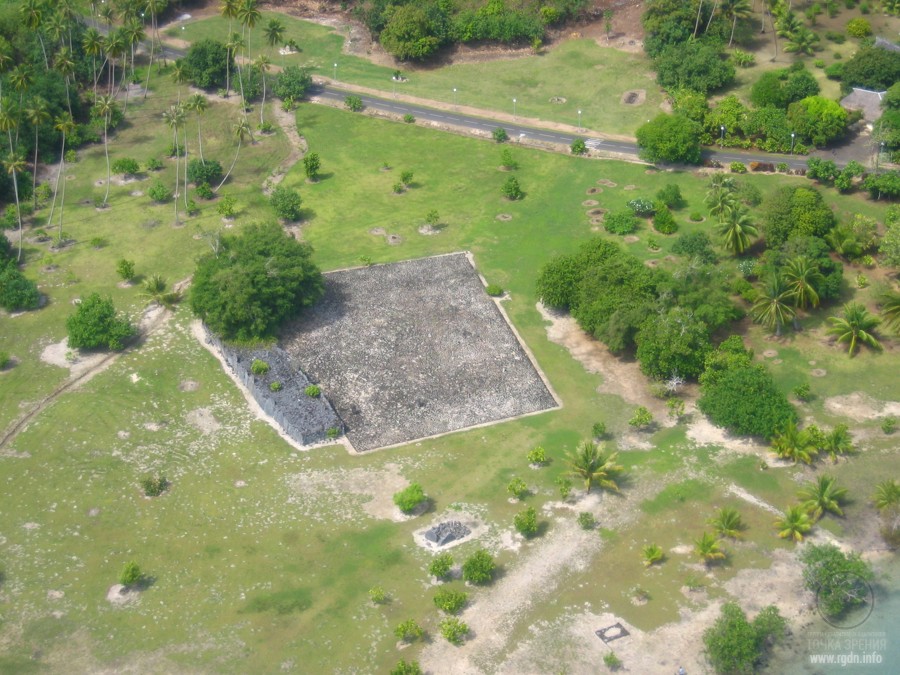
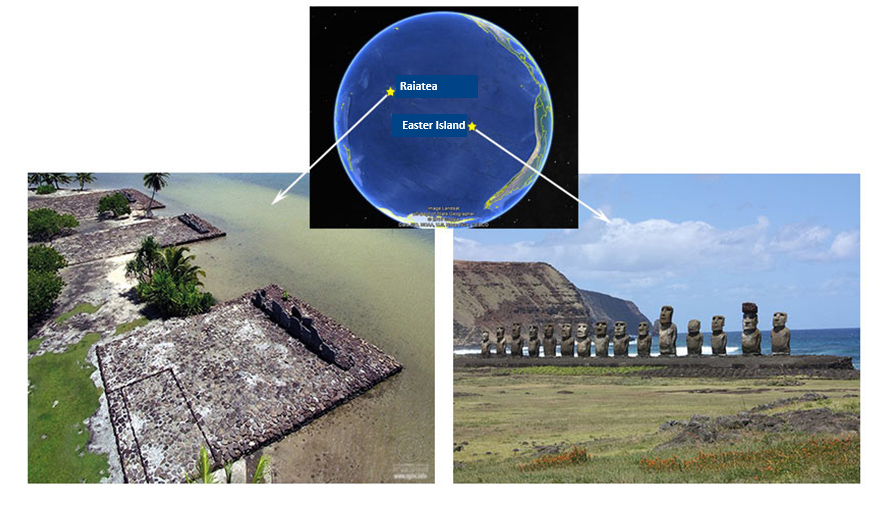
They look alike, don’t they?
This picturesque and fully civilized French Polynesian island with its highly developed tourism infrastructure also preserves memory of the mysterious forefathers. There is bearded Tiki deity with his arms raised (the symbol of enlightenment). Moreover, we again see a sign that resembles a cross in a circle.
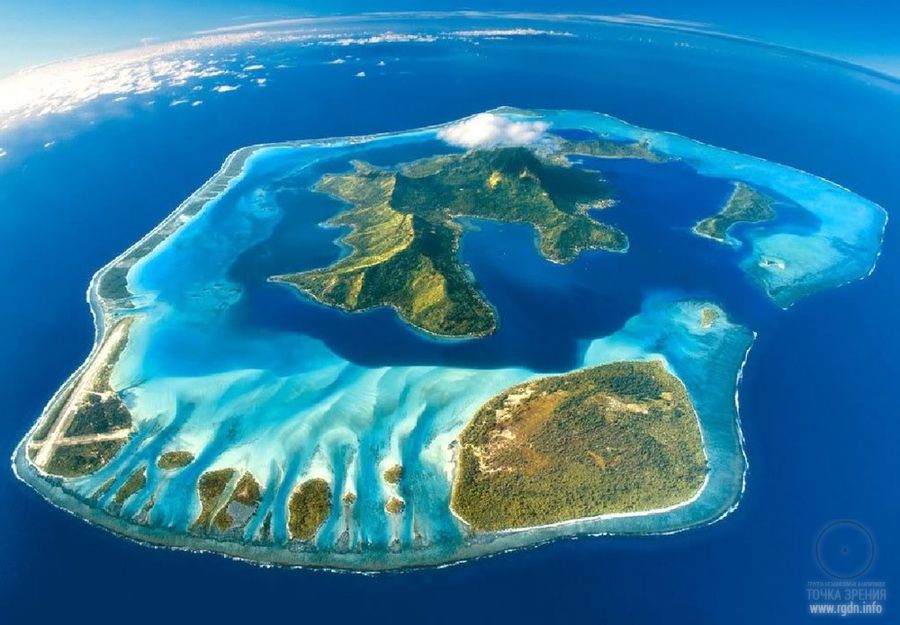
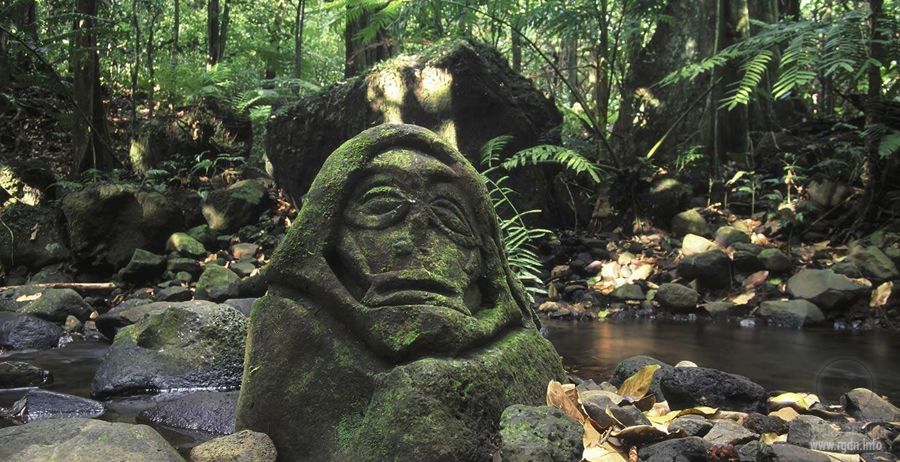
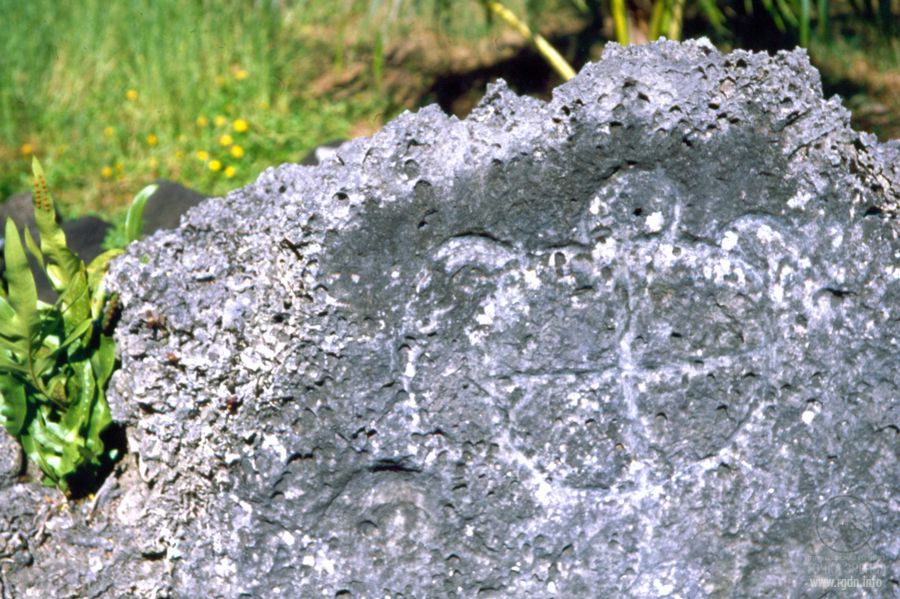
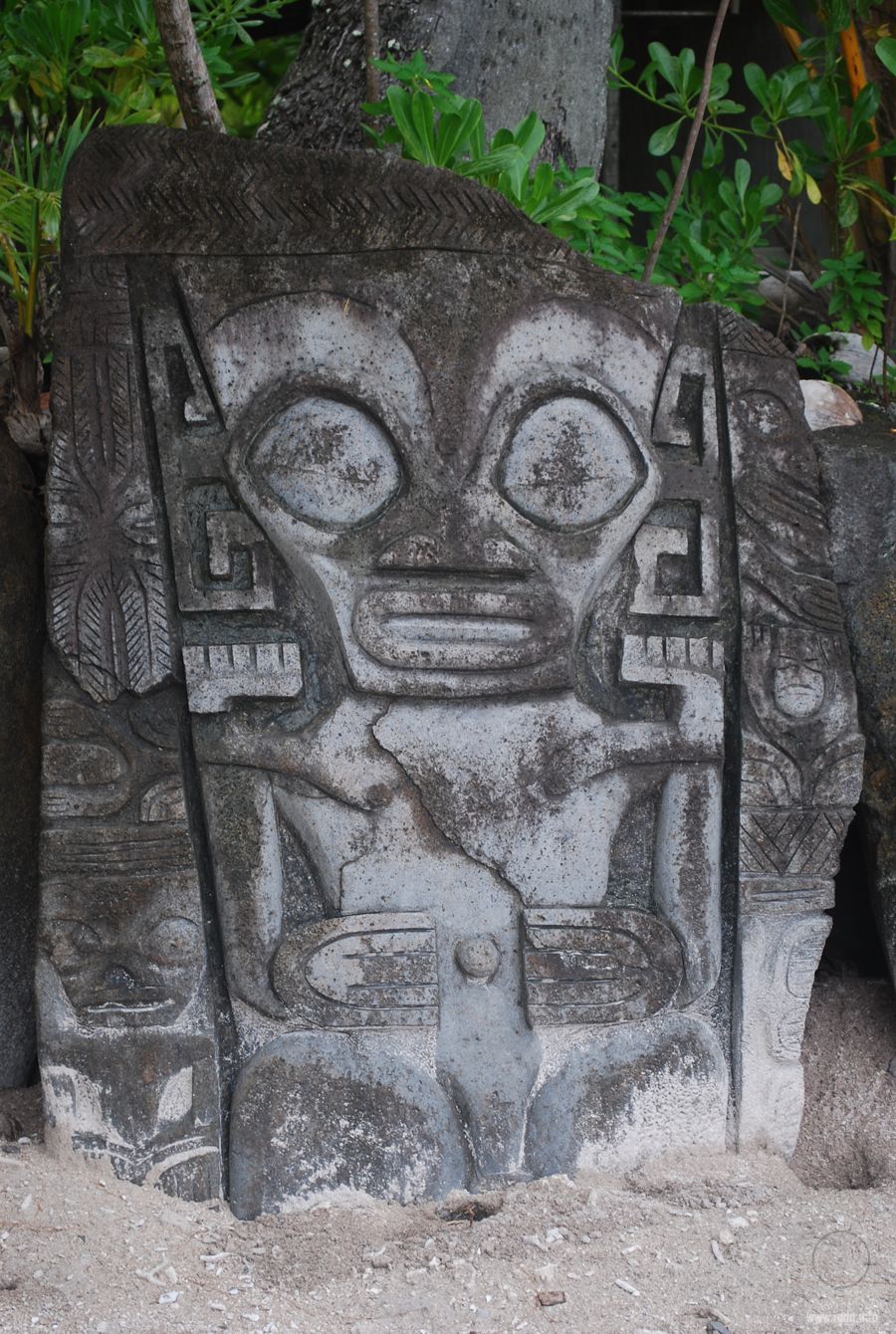
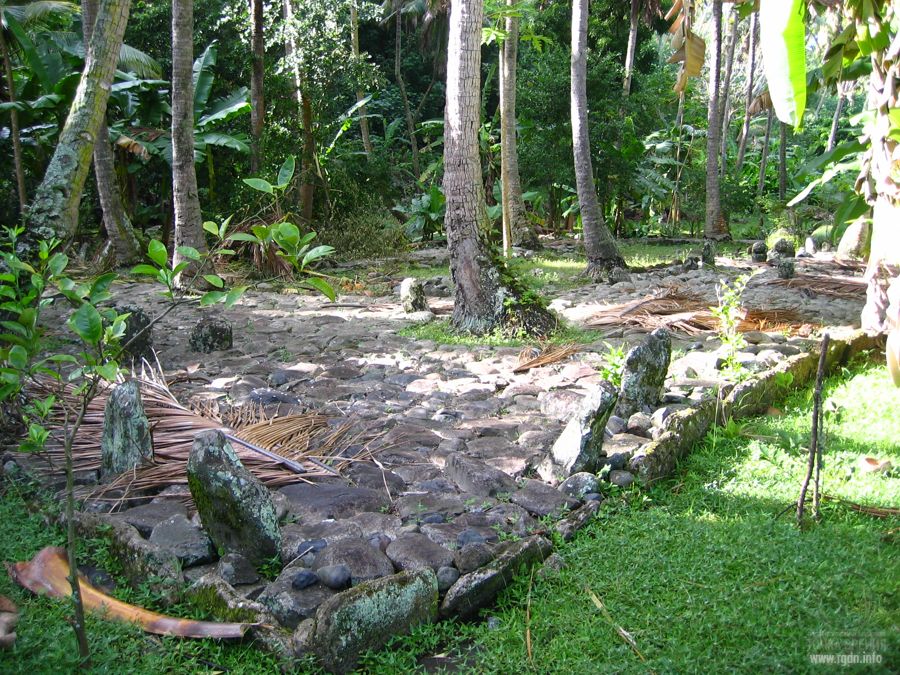
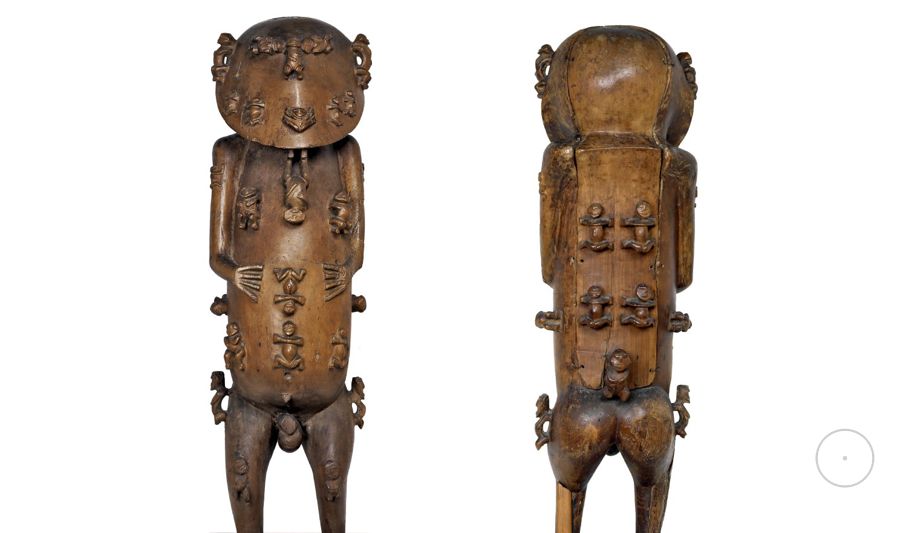
In August 1821 a group of Rurutu inhabitants went to Raiatea Island in the north to meet with representatives of the London Missionary Society. In order to demonstrate they were ready to adopt Christianity they forwarded a number of fretted figures to the missionaries, which figures embodied their deities. Thereafter the Rurutu population were altogether Christianized, having obeyed the decision of their leaders. The figures were brought to London in 1822 and given to the British Museum in 1911. Each of the wooden figures is hollow inside, has a removable panel on its back and initially contained 24 little figurines which in 1882 were unfortunately destroyed.
A link to the source
Marae on the Cook Islands:
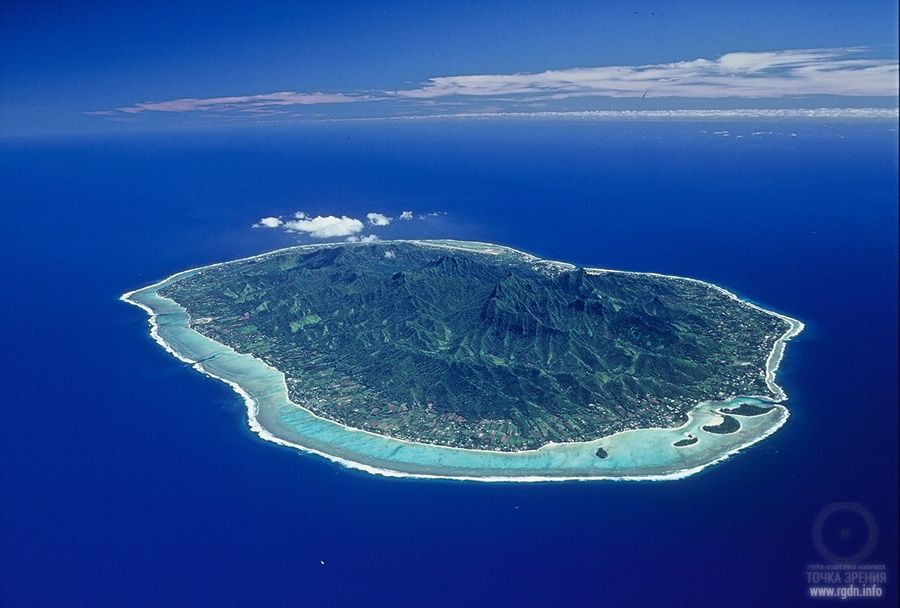
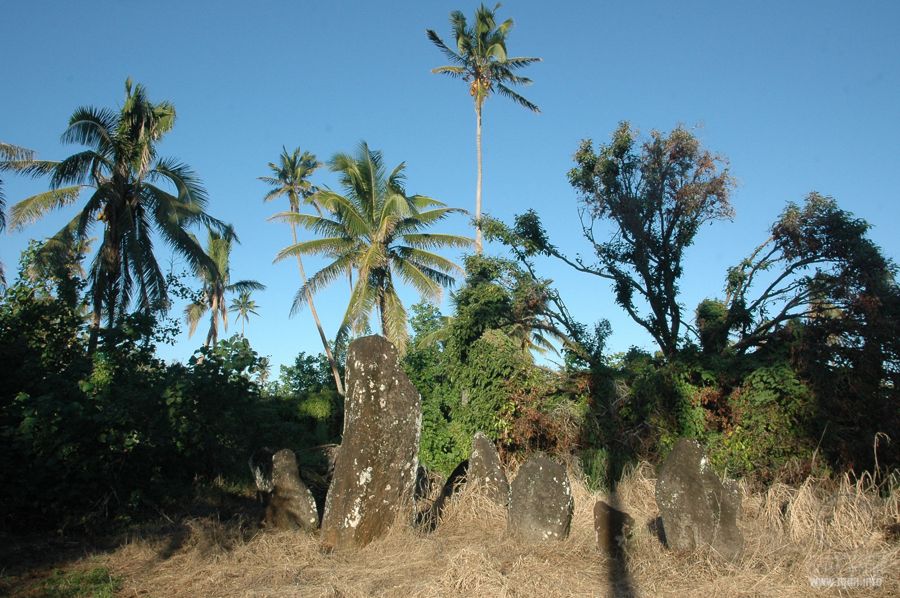
On Tongatapu Island, besides the giant arch there are ‘esi – large stones standing by themselves. Yet, the main attraction of the island is right-angled stepped mounds that resemble pyramid bases and are edged with stone blocks called langi, which is translated as “the sky”.
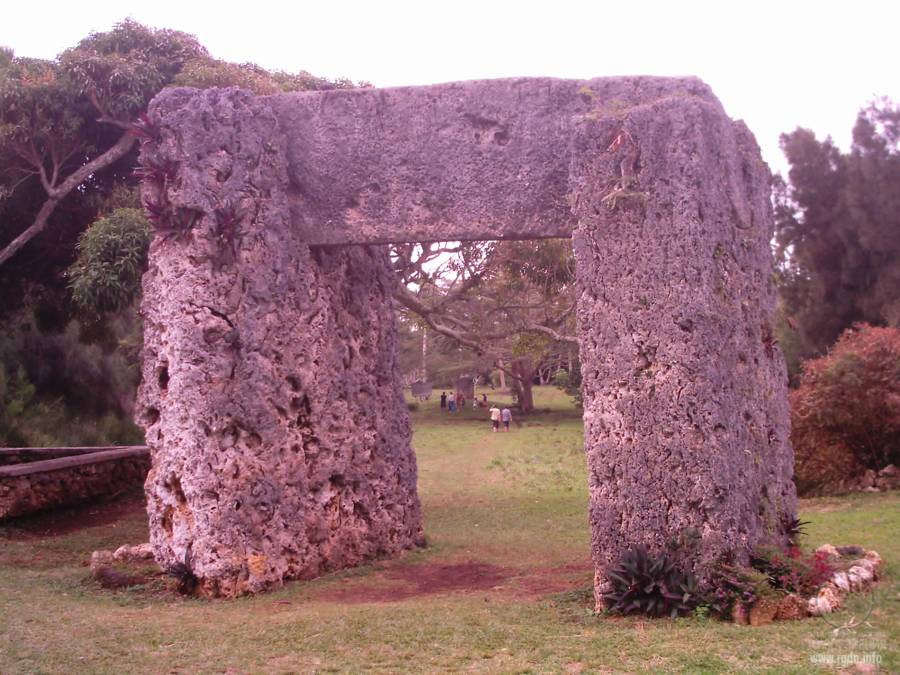
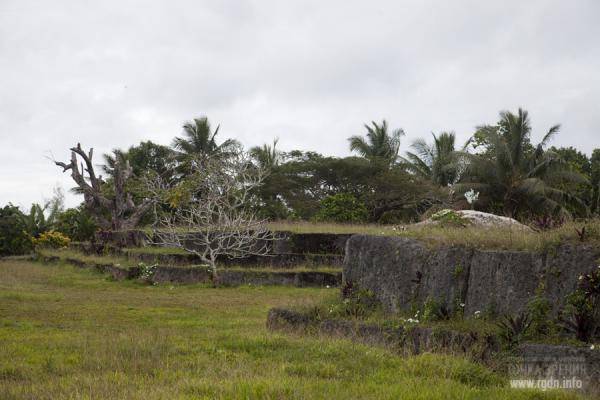
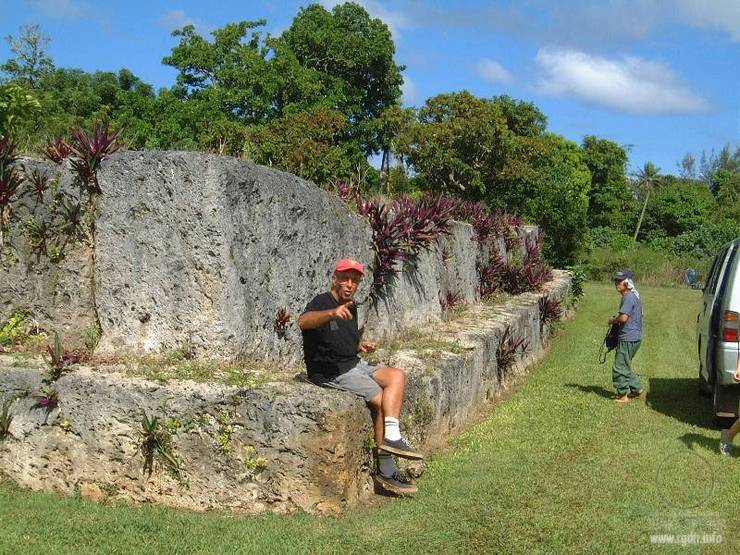
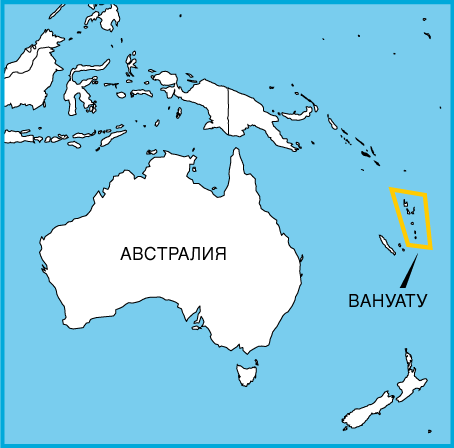 We already mentioned Vanuatu Islands, namely the little island of Malakula (Malekula) in our earlier publications: Jim Alison’s lines, Five points of the Star, and Bearded God. Who is He? Herein I will only summarize and add certain points.
We already mentioned Vanuatu Islands, namely the little island of Malakula (Malekula) in our earlier publications: Jim Alison’s lines, Five points of the Star, and Bearded God. Who is He? Herein I will only summarize and add certain points.
So, once upon a time a mythical character named Kabat arrived to Malakula aborigines and shared knowledge with them. To all appearances, he arrived to Vanuatu from the east, having crossed the Pacific Ocean. Furthermore, when he was leaving he promised to return, just like Quetzalcoatl and Viracocha / Kon-Tiki had promised the same to ancient Mexicans and to South American tribes respectively. It would be incorrect to attach Kabat to the 11th century, because there are no records about him at all. At that let me remind Malakula is very close to Anatom (Aneityum) Island which is one of the five points of the STAR – the working sign artificially created over 12,000 years ago on the planetary scale. This means Kabat visited these places much later than the last global cataclysm had taken place.
Here we can add that the name Kabat is also found in the Kobat’s head word combination (though with O in the first syllable). Kobat’s heads are huge stone heads of the Olmecs, found in Mesoamerica and dated to several millennia BC. The only difference is that these heads are beardless and of Mongoloid-Negroid appearance, whereas on Vanuatu there were apparently “Caucasian bearded men”. As for the word kabat, it means a working shirt, jacket, royal garment, caftan, or armour.
What else is interesting, even very interesting about the Vanuatu Islands? The fact that the largest island in Vanuatu is called Espiritu Santo, which is translated from Spanish as the Holy Spirit!
I will no longer delay the ending, for I have already exceeded all the acceptable text limits.
So, we have only hypothetical points remaining on our map, such as the Pohnpei Island in Micronesia with a ruined ancient city of Nan Madol. By the way, Pohnpei is also mentioned in Jim Alison’s lines as a part of the second Great Pyramid alignment (Jerusalem, Xian, and Pohnpei) and the fourth Easter Island alignment (Napata, Mecca, Mohenjo Daro, Agra, Kathmandu, Pohnpei, and Tahiti). Hence, quite probably Pohnpei is also a part of some giant planetary geometric shapes that used to be working signs in the remote antiquity.
Moreover, Wikipedia says that Nan Madol in its current form supposedly appeared between 1285 and 1485 AD, i.e. during the times of the Saudeleur Dynasty. When the dynasty was ruling, Micronesians started populating there islands and building various structures there. Who knows...
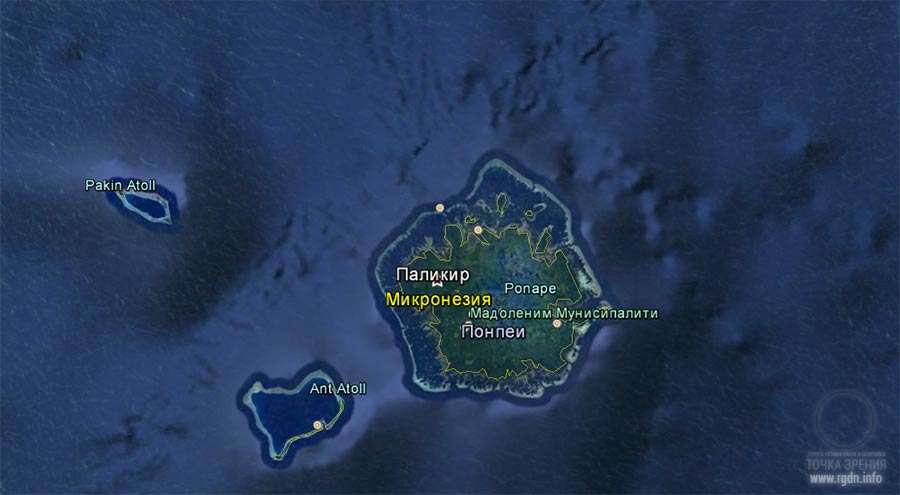
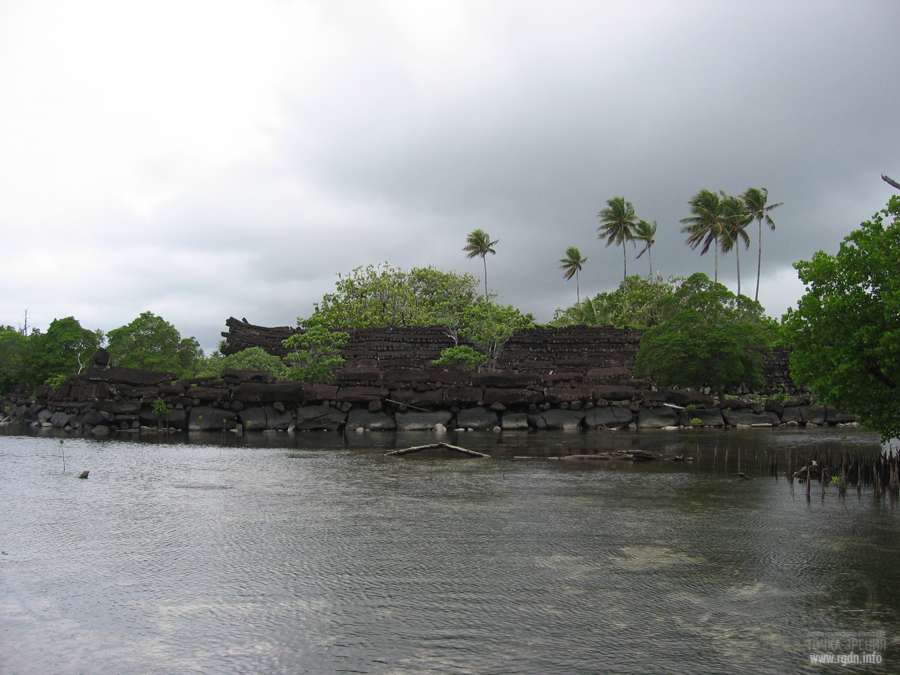
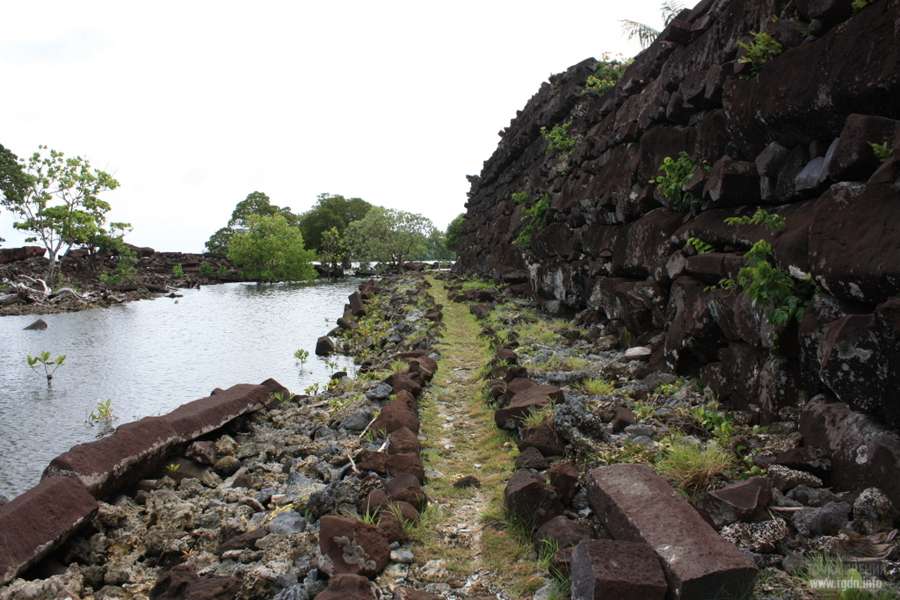
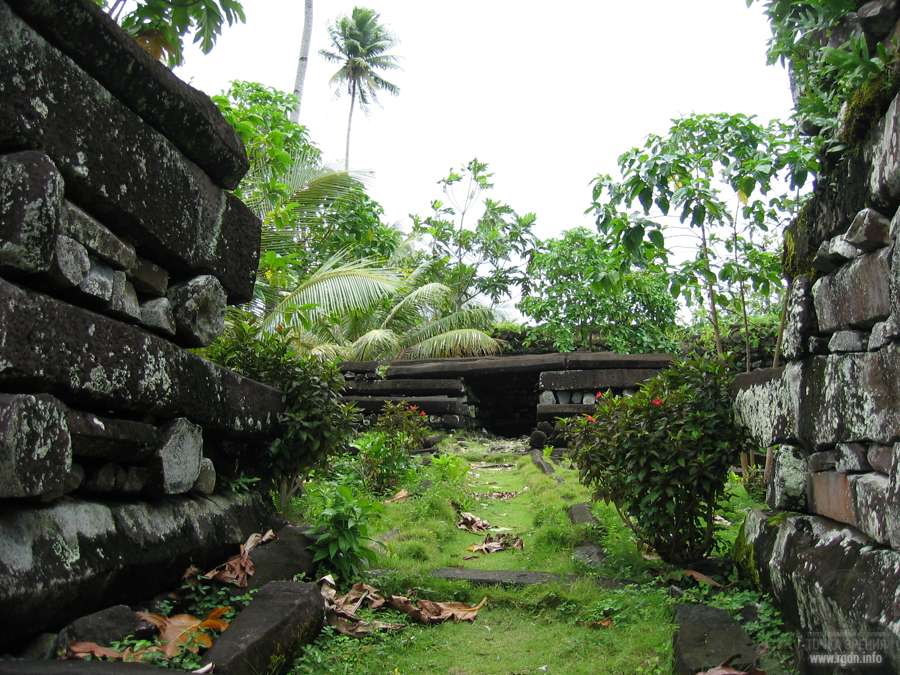
Perhaps, this place deserves a separate story.
Finally, solely for logical completion of the article let me show you megaliths on Palau Island…
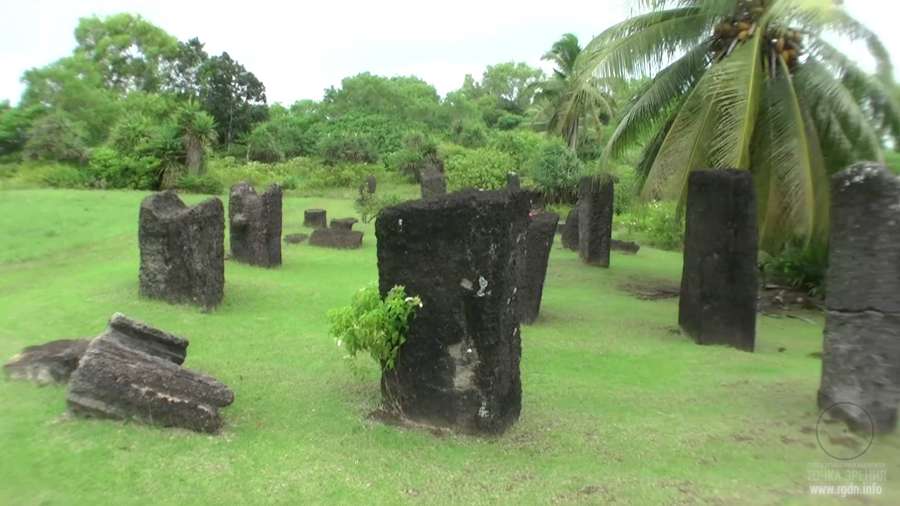
… and enormous stone circles on the neighbouring Yap Island, which are plenty. Most probably, none of them relate to the 11th century, but since we are considering the Pacific Islands I’ve decided to mention these items just in case.
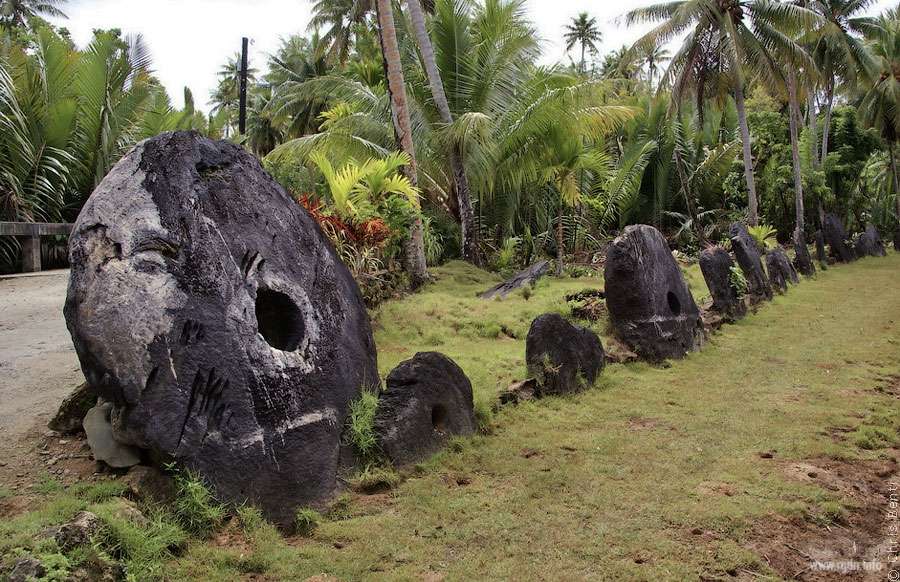
An impression may arise that in this article I have made a muddle of things again, as if there was no life on the numerous Pacific Islands before the 11th century AD. There was certainly life, and it may have been quite booming in terms of spirituality, judging by the traces discovered there. Having at our disposal only the internet and several works by famous travellers and residing on the opposite side of the globe a whole millennium after the relevant events, it is quite difficult to observe and understand the reality. Nevertheless, we have managed to find evidence that in the 10-11th centuries there were certain occurrences in Oceania which may surely be associated with the “spiritual wave” that was then rolling around the planet Earth. Should our readers find more information on the subject, we will greatly appreciate if they share it in the commentary section below.
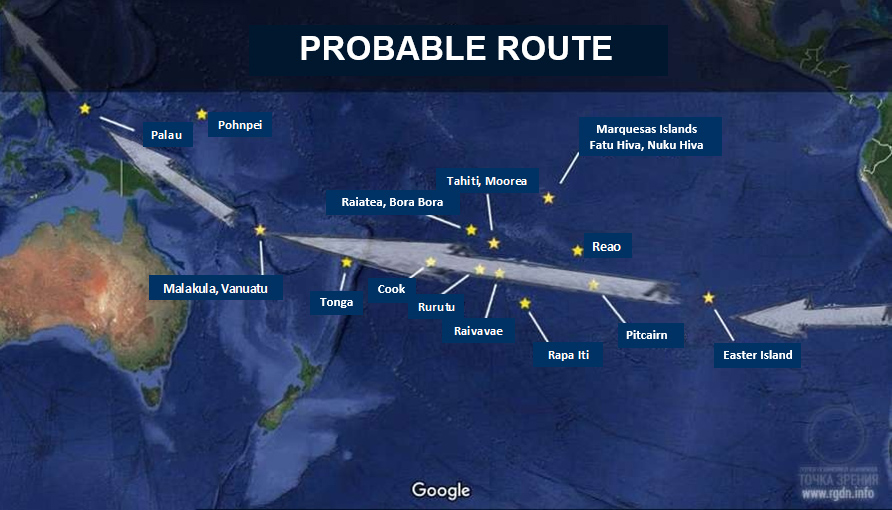
P.S. Henceforth I promise to write more briefly.
Prepared by Dato Gomarteli (Ukraine-Georgia)
 In quest of... The 11th century. Easter Island and Polynesia (Oceania). Part Four
votes:
153
In quest of... The 11th century. Easter Island and Polynesia (Oceania). Part Four
votes:
153
|

Project Aim










Leave comment